- Undergraduate
- High School
- Architecture
- American History
- Asian History
- Antique Literature
- American Literature
- Asian Literature
- Classic English Literature
- World Literature
- Creative Writing
- Linguistics
- Criminal Justice
- Legal Issues
- Anthropology
- Archaeology
- Political Science
- World Affairs
- African-American Studies
- East European Studies
- Latin-American Studies
- Native-American Studies
- West European Studies
- Family and Consumer Science
- Social Issues
- Women and Gender Studies
- Social Work
- Natural Sciences
- Pharmacology
- Earth science
- Agriculture
- Agricultural Studies
- Computer Science
- IT Management
- Mathematics
- Investments
- Engineering and Technology
- Engineering
- Aeronautics
- Medicine and Health
- Alternative Medicine
- Communications and Media
- Advertising
- Communication Strategies
- Public Relations
- Educational Theories
- Teacher's Career
- Chicago/Turabian
- Company Analysis
- Education Theories
- Shakespeare
- Canadian Studies
- Food Safety
- Relation of Global Warming and Extreme Weather Condition
- Movie Review
- Admission Essay
- Annotated Bibliography
- Application Essay
- Article Critique
- Article Review
- Article Writing
- Book Review
- Business Plan
- Business Proposal
- Capstone Project
- Cover Letter
- Creative Essay
- Dissertation
- Dissertation - Abstract
- Dissertation - Conclusion
- Dissertation - Discussion
- Dissertation - Hypothesis
- Dissertation - Introduction
- Dissertation - Literature
- Dissertation - Methodology
- Dissertation - Results
- GCSE Coursework
- Grant Proposal
- Marketing Plan
- Multiple Choice Quiz
- Personal Statement
- Power Point Presentation
- Power Point Presentation With Speaker Notes
- Questionnaire
- Reaction Paper
- Research Paper
- Research Proposal
- SWOT analysis
- Thesis Paper
- Online Quiz
- Literature Review
- Movie Analysis
- Statistics problem
- Math Problem
- All papers examples
- How It Works
- Money Back Policy
- Terms of Use
- Privacy Policy
- We Are Hiring

Korean Culture and Cuisine, Essay Example
Pages: 8
Words: 2096
Hire a Writer for Custom Essay
Use 10% Off Discount: "custom10" in 1 Click 👇
You are free to use it as an inspiration or a source for your own work.
The Korean population has over 70 million people that speak Korean, which is considered a part of the Tungusic branch from the Ural-Altaic language families. The language has a very close relationship with the Japanese traditional grammar and language style of speaking(EveryCulture,2015). The rich history and culture of Korean people go back as early as 500,000 B.C. in the Korean Peninsula populated by Paleolithic people (Asian Info,2015). In addition, the Korean people tradition and culture has been kept and somehow the foundation of Korean culture has remained unchanged. The Korean people have been through wars, North and South differences and many environmental, social and political changes while documenting their traditions in detail. The Korean culture and cuisine has evolved through social and political change, natural environment changes and different cultural trends. Korean cuisine has a basic food combination of steamed cooked rice, vegetables and some meats. The changes in the Korean cuisine originated from their migrations to different parts of the country from village to region to national locations. Korean traditional cooking has many side dishes called banchan such as Kimchi served with every side dish delicacy (China Business Weekly,2011). The tradition of the Korean meals has the following characteristics such as rice, kimchi, bulgoi, and spicy cold noodles. In addition, the cuisine is spicy, tasty, sour and sweet with shrimp, squid, mushrooms and vegetables (Home Cook Dairy,2011).
The Korean culture, tradition and cuisine is integrated is the fabric of their existence from generations of heritage and social tendencies that has not changed. The family combines any event for the family with a specific meal for that occasion and culture rituals that follow any celebration. The Korean people take offense when traditional dishes are not followed exactly the way it was taught by their forefathers. The entire Korean family is held accountable for ensuring these traditions are not altered, changed or any outside influence. The Korean tradition that remains in place for the family is the mandatory respect for the elderly. The ultimate respect for the elderly is everyone bowing and recognizing their contributions to the family while still be a leader of the community and family (Korean Times, 2008).
Korea has a long and rich tradition of excellent cuisine with deep roots with significant historical and cultural customs. One the major heritage accomplishments of Korea have been their ability to preserved their original customs and traditions from generations to generations. The Korean culture is based on humility, sincerity and gratitude when meeting a person, eating with friends or family and praying is important. Their etiquette is being humble by bowing which is the same as a handshake (Golden,2012). Korea is one the few countries that has been through social and political turmoil but managed to keep the foundation and roots of their ancestors in place. Some countries have many different influences from other ethnic contributors however,
The Korean people have managed to keep outside influence from changing their long established culinary identity. The Korean people originate from the Korean Peninsula where the different clans share a very common speaking language, culture and ethnic identity. The Korean people have some significant regional differences between South Korea and the Democratic People’s Republic of North Korea. They both shared the same culture and cuisine traditions with a strong sense of national pride and purpose. The modern North and South Korean both keep all the traditional cultural customs in the rural parts of the country and in the city. The Korean elderly make sure that the younger generations understands the significance of keeping the culture and heritage alive and relevant. The culture of the Korean people holds the elderly in the highest esteem and celebrate their life and death as custom that the elderly should never be forgotten.
The lifestyle of the Korean keeps the culinary identity regardless whether they live in the city in apartments or in the rural area with traditional housing. The new millennium has ushered in the new technology and lifestyles changes nevertheless; the Korean people remain true to the traditional values.
Korean Etiquette
The Koreans have a humble nature that is very conscious of their speech and behavior in social settings. The husband and wife have a balance in the family with the etiquette of the male taking the lead in all situations in public. The Korean people have a naming etiquette that consist of how to address each other such as using titles instead of names (Every Culture,2015).
The best example the teacher would be respected by calling him professor or manager, or director and president. The hierarchical relationship in the Korean social world is followed regardless of business or personal relationships in the home. The Koreans have the cultural etiquette to being respectful of those that are your peers or on the same social level consequently higher status Korean people must be limited with social interactions. The Koreans will bow in respect to others they greet that position demand respect but the etiquette they use is bowing just a little bit lower for those with high statuses. The etiquette habits by Koreans of bowing has significant meaning in the Korean society and families engrain this tradition into their children for life (Korean Times,2008).
The Korean people believe that being on time is an etiquette that must not be ignored. In their culture it is believed that making an appointment or promising to attend an event is taken seriously. The North and South Koreans emphasize meeting deadlines and they believe that punctuality is a sign of respect for locals and any foreigners. Koreans believe it personal etiquette to work hard and diligently without compliant of hours or how hard the task or work. Koreans considered it rude and unprofessional to leave the job early before the executive boss.
Korean Cuisine (Royal Family)
The Korean cuisine has a fundamental foundation of rice which is the primary food of the Korean people that is eaten with literary every meal. The north has a traditional of corn, rice, wheat, barley, corn, while other cuisine traditions include vegetables such as cabbage and turnips(Thorn,2013). The Korean people may have North and South regions with different philosophical and political differences however the foundation of Korean cuisine has evolved from the dishes and techniques without being tainted with outside cultures. The Korean royal palace follows the cultural ways that all Koreans use to prepare their cuisine that are very elaborate.
The Korean culture regardless of royal palace or North or South Korean, Kimchi is a mandatory tradition made of fermented chili sauce, anchovies and cabbage that is authentic spicy and sour taste (Golden,2012). The Royal palace foods have a reputation of being exquisite, extravagant and meticulously prepared by Korean women. The traditional of drinking has its significance in the royal palace because the pouring of a drink is considered a matter of respect for the elderly. The Korean drinking culture has a long history never pouring one’s own drink. This ritual is an act of respect because the pouring of a drink for the elder, one must put their hand over their heart to show a sign of earned respect of the elder(Steinberg,2012).
The Korean royal palace families kept the tradition of Korean food in tact by training women to learn all the cultural and heritage concerning Korean cuisine. These women had different palace positions specifically to learn the history and all the different aspects of Korean food preparation (Visit Korea,2015). The cuisines were documented and learned by the royal families passing down the original recipes and traditions of the Korean cuisine. The kings and queens had the power to control the entire community or region eating regiments by demanding all food follow the thousands of years of tradition. The peasants did not enjoy the same level of extravagant food as the royal family but the recipes were the same.
The royal family has the basics meals of steamed rice, kimchi and fish with characteristics of lots of spices, fermentation and variety of side dishes (Visit Korea,2015). The royal families can be credited for ensure the traditions and Korean cuisine remains unchanged well into the future. In addition, they can be credited for keeping all the Korean etiquettes and traditions in place for future generations. In the Korean culture the etiquette of eating was a part of the cultural experience that was passed down from generations to generations. These cuisine moments were used to shared food recipes, social behaviors, historical, mythical, social and political ideas(Steinberg,2012). The royal queens and kings found that the cultural traditions must be handed-down allowed the peasants to eat the same Korean meals but not in the same grandiose fashion as royalty. The king and queen has the power to change the tradition however, they have been taught to follow the tradition of Korean cuisine, culture and heritage with opposition.
Korean Culture
The most important tradition that has been passed down for many generations is the family comes first above everything in Korean lifetime. This is an essential tradition of the Korean family culture which is never challenge from clan to clan. The father is always the head of the household handling all affairs outside of the home which women are not allowed. The father takes care of the shelter, food, and chooses the martial relationships of the entire family. The religious aspect of Korean family culture is following the teachings of Confucius. There is a set hierarchical of the family that starts with the eldest son who will earn his manhood as the right arm of the family but respecting father’s decisions. This hierarchical model has influence from the Confucius teachings that stress family, community, duty, truthfulness and family honor. The personal feelings, dreams and hopes of the individual in the Korean family is never more important that the goal of the family well-being first.
The Korea culture have an enriched, enduring and beautiful background that has been built over centuries keeping the traditions the same without integration of other cultures. The family traditions are evident because Korean people do not put their parents or grandparents in the nursing home. They spend their lives committed to the help and welfare of the parents and they never forget them with annual memorials on the day of their death. The Korean family praises the elderly ensuring they are involved with every activity and event as advisors. However, the father is the head of the household but the grandparents have a tradition of quietly making decisions to help the father. The father as the head of the household is more than just a gender tradition because the male of the household will be held responsible for the actions of their children. As result, the incorrect behavior of the wife or children will not be held responsible because it’s the father that must make sure everyone is living in the Korean tradition.
There is a specific order that makes the Korean culture work because the traditions such as dressing remains the same as their forefathers. These artful and artistic clothing represents their character and personality as Korean people. The women embrace their place in the long traditional of the household dominated by the men. The Korea’s women culture has a tradition of wearing a conservative dress called hanbok. The women’s daily look involves a hanbok with a plain blouse and a very full skirt that reaches down to her ankles. The women’s blouse is traditionally wrap and tied at the waist with long full sleeves to prevent any thoughts of improprieties. The women wear a petticoat to increase her thickness to hide the body and the men wear baggy trousers which all outfits are artfully crafted. The culture of dressing by the Korean people is representative of their way of life by remaining true to the Korean heritage.
Asian Info. (2015). The people of Korea: Brief History. Retrieved from http://www.asianinfo.org/asianinfo/korea/people.htm
China Business Newsweekly. (2011, Feb). Korean food foundation; Emmy-award winner Kelly Choi to reveal the delicious secret of Korean cuisine. China Business Newsweekly Retrieved from ProQuest Database at http://search.proquest.com/docview/850517044?accountid=34899
Every Culture. (2015). South Korea: Identification. Retrieved from http://www.everyculture.com/Ja-Ma/South-Korea.html
Golden, C. (2012). Craving Korean: for an authentic taste of the new ‘it’ cuisine, start your food adventure in L.A.’s Koreatown. Here’s where to go and what to try. Sunset , (3). 64.
Home Cooking Dairy. (2011). Top 10 most popular Korean foods. Retrieved from http://www.homecookingdiary.com/2011/06/top-10-most-popular-korean-foods.html
Korean Times. (2008, Mar). Tips on Korean custom of bowing. Retrieved from http://www.koreatimes.co.kr/www/news/special/2010/08/177_23339.html
Steinberg E. (2012). Korean Cuisine: An illustrated history. Asian Perspectives: The Journal of Archaeology for Asia And The Pacific ; Vol. (1):132. Retrieved from General OneFile
Thorn, B. (2013). Consumers’ taste for Korean cuisine grows. Nation’s Restaurant News, Retrieved from http://search.proquest.com/docview/1435039490?accountid=34899
Visit Korea. (2015). Travel highlights. Retrieved from http://english.visitkorea.or.kr/enu/SI/SI_EN_3_6.jsp?cid=259177
Stuck with your Essay?
Get in touch with one of our experts for instant help!
Comparison of Vitamin Contents, Essay Example
On-Line Education and Charter Schools, Essay Example
Time is precious
don’t waste it!
Plagiarism-free guarantee
Privacy guarantee
Secure checkout
Money back guarantee

Related Essay Samples & Examples
Voting as a civic responsibility, essay example.
Pages: 1
Words: 287
Utilitarianism and Its Applications, Essay Example
Words: 356
The Age-Related Changes of the Older Person, Essay Example
Pages: 2
Words: 448
The Problems ESOL Teachers Face, Essay Example
Words: 2293
Should English Be the Primary Language? Essay Example
Pages: 4
Words: 999
The Term “Social Construction of Reality”, Essay Example
Words: 371
Your cart is empty
Have an account?
Log in to check out faster.
SEOULBOX BOXES
✨July Promo: Free Mystery Merch Bonus in Every Box!
SHOP SUBSCRIPTION BOXES
Seoulbox signature: korean snack box, seoulbox life: k-pop & lifestyle box, seoulbox v: vegetarian korean snack box, shop by benefit, k-pop & k-beauty, vegetarian snacks, most popular, give a gift, take the quiz, see what's inside.
- About Seoulbox
- Partnerships Enquiry
- Refer a Friend
⭐⭐⭐⭐⭐ 2,500+ 5-Star Reviews

Search Log-in Cart
Search Cart
Korean street food: A culinary journey through korea
The tantalizing world of Korean street food beckons food lovers from all corners of the globe. With its vibrant colors, bold flavors, and unique textures, Korean cuisine has gained immense popularity worldwide. From sizzling skewers of meat to piping hot bowls of noodles, Korean street food offers an irresistible culinary adventure. In this blog, we embark on a mouthwatering journey to explore the diverse and flavorful street food culture in Korea. Get ready to indulge your senses and discover the hidden gems of Korean street food.
Brief overview of Korean cuisine and its popularity
Korean cuisine is renowned for its emphasis on fresh ingredients, balanced flavors, and healthful cooking techniques. It has gained tremendous popularity in recent years, with Korean restaurants and dishes appearing in cities around the world. Korean cuisine's popularity can be attributed to its bold and savory flavors, the health benefits of its traditional ingredients, and the growing interest in global flavors.
The cultural mosaic through street food
- Korean street food reflects the diverse regional flavors and cultural influences present throughout the country.
- Each region offers its own specialties, ingredients, and cooking techniques, providing a glimpse into the cultural mosaic that makes up Korean cuisine.
Unveiling the Treasures of Korean Street Food
Traditional Street Food Delights
- Explore iconic street food dishes like tteokbokki (spicy rice cakes), sundae (blood sausage), and hotteok (sweet pancakes).
- Discover the ingredients, cooking techniques, and historical significance behind these beloved street food classics.
Modern and Fusion Creations
- Witness the emergence of modern and fusion street food in Korea, blending traditional flavors with global influences.
- Delve into popular modern street food items like cheese corn dogs, ramen burgers, and unique culinary mashups that push the boundaries of taste.
Traditional Korean Street Food

Image credit: via pinterest
Overview of traditional Korean street food
The vibrant street food scene in Korea has a rich history and is deeply rooted in the country's culinary traditions. Korean street food is known for its affordable prices, convenient availability, and mouthwatering flavors. Street food stalls, known as pojangmacha, can be found throughout bustling markets, shopping streets, and even residential areas.
Popular dishes like tteokbokki, sundae, and hotteok:
- Tteokbokki: A beloved street food dish consisting of chewy rice cakes cooked in a spicy gochujang sauce. It is often accompanied by fish cakes, boiled eggs, and vegetables.
- Sundae: Not to be confused with ice cream, sundae is a traditional Korean blood sausage made with a mixture of pork, glass noodles, and various seasonings. It is usually steamed or boiled and served with spicy sauce and vegetables.
- Hotteok: A sweet and chewy pancake filled with a mixture of brown sugar, cinnamon, and chopped nuts. It is griddled until golden and enjoyed piping hot.
Description of ingredients and cooking techniques:
- Tteokbokki: The main ingredient is tteok, which are cylindrical rice cakes made from glutinous rice flour. The sauce is made from gochujang (fermented red chili paste), soy sauce, sugar, and other seasonings. The dish is typically stir-fried or simmered.
- Sundae: The sausage casing is made from pig intestines stuffed with a mixture of finely chopped pork, glass noodles, vegetables (such as green onions and garlic), and seasoning. It is then cooked by steaming or boiling.
- Hotteok: The pancake batter is made from a mixture of wheat flour, water, sugar, and yeast. The filling is made by combining brown sugar, cinnamon, and chopped nuts. The pancake is pan-fried until crispy on the outside and gooey on the inside.
Insight into the historical and cultural significance of these dishes
- Tteokbokki: Originating from the Joseon Dynasty, tteokbokki was originally a royal court dish but eventually became popular as a street food. It reflects the use of rice, a staple ingredient in Korean cuisine, and the love for spicy flavors.
- Sundae: Sundae has its roots in Korean sausages brought by Mongol invasions during the Goryeo Dynasty. Over time, it evolved into a popular street food dish that represents the resourcefulness of Koreans in using various parts of the pig.
- Hotteok: Introduced during the early 20th century, hotteok is believed to have been influenced by Chinese stuffed pancakes. It has become an iconic street food snack that brings warmth and comfort, especially during the colder months.
Regional Variations in Street Food
Just as Korea boasts a diverse landscape and regional cultures, its street food scene varies across different regions. Each region offers its own unique flavors, ingredients, and local specialties, making the street food experience a culinary adventure.
Focus on Seoul, Busan, and Jeonju

Image credit: honestfoodtalks via web
As the capital city and culinary hub of Korea, Seoul is a treasure trove of street food delights. Its bustling markets like Namdaemun Market and Gwangjang Market are famous for a wide variety of street food offerings.
Signature street food dishes include:
- Gyeran-bbang: Soft and fluffy egg bread filled with a whole egg, often enjoyed as a quick breakfast.
- Jokbal: Tender and savory braised pig's trotters seasoned with soy sauce and spices.
- Eomuk: Fish cakes served on skewers or in a warm soup, available in various flavors and textures.

Image credit: mangoplate via web
As a coastal city renowned for its fresh seafood, Busan offers a unique twist to Korean street food. The Jagalchi Fish Market and Gukje Market are popular destinations for street food enthusiasts.
- Milmyeon: Cold and chewy wheat noodles served with a spicy and tangy sauce, topped with various vegetables and often seafood.
- Ssiat Hotteok: A variation of hotteok with a filling of seeds such as pumpkin, sesame, and sunflower, adding a delightful crunch to the pancake.
- Gukbap: A hearty soup made with beef or pork, served with rice and often enjoyed with kimchi.

Image credit: bonappetit via web
Jeonju is known as the food capital of Korea, renowned for its rich culinary heritage and traditional flavors.Hanok Village and Nambu Market are prominent spots to explore Jeonju's street food scene.
- Bibimbap: A classic Korean dish consisting of a bowl of rice topped with an assortment of vegetables, meat, and gochujang sauce.
- Kongnamul Gukbap: A comforting soybean sprout soup served with rice and various side dishes, representing Jeonju's emphasis on simple and nourishing flavors.
- Jeonju-style kimbap: A unique variation of kimbap, a rice roll with various fillings, often incorporating Jeonju's famous bibimbap ingredients.
Modern and Fusion Street Food
In recent years, Korean street food has experienced a dynamic transformation with the emergence of modern and fusion creations. Inspired by global food trends and creative culinary experimentation, vendors have started offering innovative twists on traditional dishes and incorporating international flavors.
The globalization of food culture and the increasing popularity of Korean cuisine worldwide have played a significant role in shaping modern street food in Korea. Global food trends, such as the rise of food trucks, the popularity of comfort foods, and the fusion of different culinary traditions, have influenced Korean street food vendors to experiment with new flavors and techniques.
Examples of popular modern street food items:
- Cheese Corn Dogs: A modern take on the classic corn dog, this street food delicacy features a hot dog on a stick coated in batter and deep-fried to perfection. What sets it apart is the addition of a generous layer of melted cheese on the outside, creating a delightful combination of flavors and textures.
- Ramen Burgers: A fusion creation that combines elements of Korean and American cuisine, the ramen burger replaces the traditional burger bun with two discs of fried ramen noodles. The patty, often made with beef or pork, is sandwiched between the crispy ramen "buns," offering a unique and satisfying eating experience.
Impact of social media on the popularity and accessibility of these dishes
Social media platforms, such as Instagram and YouTube, have played a significant role in popularizing modern and fusion street food in Korea. Food bloggers, influencers, and viral videos showcasing these innovative street food creations have created a buzz, attracting both local residents and international tourists. Social media platforms have made it easier for vendors to showcase their unique offerings, increasing the accessibility and visibility of these dishes to a wider audience.
Street Food Markets and Festivals

Korea is famous for its bustling street food markets, where vendors showcase a wide array of mouthwatering delicacies. These markets are vibrant hubs of activity, offering visitors a sensory experience filled with delicious scents, colorful displays, and lively atmosphere. These festivals showcase a wide variety of street food vendors, providing a unique opportunity to sample different dishes and explore the diverse flavors of Korean cuisine.
Famous markets such as:
Gwangjang Market:
Located in Seoul, Gwangjang Market is one of the oldest and largest traditional markets in Korea. It is renowned for its incredible street food scene, with numerous stalls offering a wide range of delectable treats. Visitors can enjoy classics like bindaetteok (mung bean pancakes), mayak gimbap (bite-sized seaweed rice rolls), and yukhoe (Korean beef tartare).
Myeongdong Street:
Situated in the heart of Seoul, Myeongdong Street is a bustling shopping district that is also famous for its street food. Food carts and stalls line the streets, offering a variety of snacks and treats for visitors to indulge in. Some popular street food items found in Myeongdong include tteokbokki, hotteok, and Korean-style chicken skewers.
Street Food Etiquette and Tips
Korean dining etiquette emphasizes respect and communal dining. Common practices include using both hands to receive or pass dishes, using chopsticks and spoons appropriately, and waiting for the oldest or most senior person to begin eating before starting yourself. Showing gratitude and compliments to the cook or vendor is also appreciated.
Specific guidelines for enjoying street food in Korea
- Observe the queue: If there is a line at a street food stall, join the queue and wait patiently for your turn.
- Be mindful of the space: Street food stalls can be crowded, so be aware of your surroundings and avoid blocking pathways or congesting the area.
- Dispose of trash properly: Use designated trash bins to dispose of wrappers, cups, and other food packaging. Keeping the street clean is important in Korean culture.
Tips for finding the best street food vendors and identifying quality offerings
- Follow the locals: Pay attention to where locals are lining up or frequenting. Locals often know the best spots for delicious street food.
- Look for popular vendors: Long queues and high turnover of customers are usually indicators of a popular and reputable street food vendor.
- Cleanliness and hygiene: Check for cleanliness in the preparation area, utensils, and the vendor's overall appearance. This can be a good indicator of the vendor's commitment to hygiene and food safety.
Advice on navigating dietary restrictions or allergies while enjoying street food
- Research common ingredients: Familiarize yourself with common ingredients used in Korean street food and check for any potential allergens.
- Communicate dietary restrictions: If you have specific dietary restrictions or allergies, communicate them clearly to the vendor. They may be able to suggest alternatives or provide ingredient information.
- Opt for made-to-order options: Choose street food items that are prepared fresh and made-to-order. This allows for better control over ingredient substitutions or exclusions.
Navigating street food with consideration for etiquette, quality, and dietary restrictions ensures an enjoyable and safe experience. By embracing Korean dining customs, being mindful of your surroundings, and seeking out reputable vendors, you can fully immerse yourself in the delightful flavors of Korean street food while respecting the local culture and community.
Korean street food is a vibrant and diverse culinary realm that showcases the rich flavors and culinary heritage of Korea. From traditional favorites like tteokbokki and hotteok to modern fusion creations like cheese corn dogs and ramen burgers, Korean street food offers a captivating range of flavors, textures, and aromas. Each region within Korea boasts its own specialties and unique street food experiences, reflecting the country's diverse culinary landscape.
If you're a food enthusiast or an adventurous traveler, Korean street food is an absolute must-try. Embark on a culinary journey through bustling street markets, vibrant food stalls, and exciting street food festivals. Immerse yourself in the sights, sounds, and tantalizing aromas as you savor the delicious offerings that Korean street food has to offer. Whether you find yourself wandering the bustling streets of Seoul, don't miss the opportunity to immerse yourself in the world of Korean street food.
Leave a comment

DISCOVER KOREAN THROUGH SNACKS
Craving some more? How about with Korean snacks! Yes, you, you hit the right spot! Treat yourself to a box filled with unique snacks, exclusive K-pop merch, and K-beauty essentials, all sourced directly from Korea. Relish the thrill of exploring Korea each month and feel its heartbeat closer than ever!
- Choosing a selection results in a full page refresh.
- Opens in a new window.
In My Korea
These 30 Traditional Korean Dishes Will Make You So Hungry!
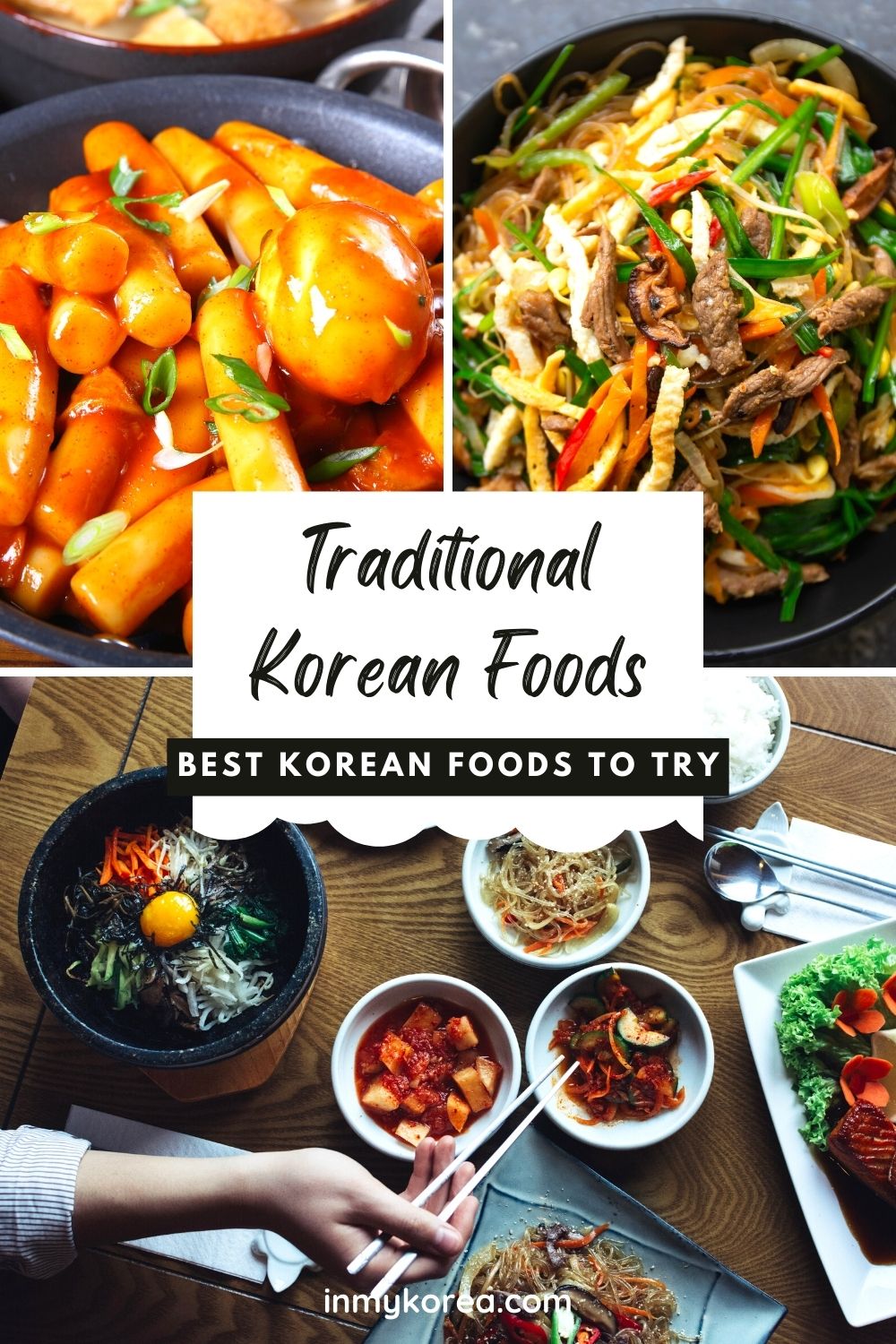
Do you know what the tastiest traditional Korean dishes are? You might think of Korean BBQ, or maybe kimchi and ramyeon . These are just the tip of a culinary iceberg that covers a wide range of dining options for all travellers. Meet the 30 most mouth-watering traditional Korean dishes that you will be craving now and long after you return from your trip to Korea.
You can plumb the depths of an ocean of exquisite tastes, incredible eating experiences, and a variety of flavours, textures, smells, and sights while partaking in Korea’s finest traditional fare. The hardest part of visiting Korea is having to choose which ones to eat and when!
There’s something for everyone in this list, whether you’re a meat-lover, vegetarian, vegan, spice-lover, or seafood-addict. There often isn’t enough time to try them all, so take a look at the list below and see which ones you shouldn’t miss. I’ll share my favourites with you and tell you why they’re irresistible, too.
Table of Contents
Affiliate Disclaimer : This site contains affiliate links and I may earn commission for purchases made after clicking these links.
Why Try Traditional Korean Dishes?
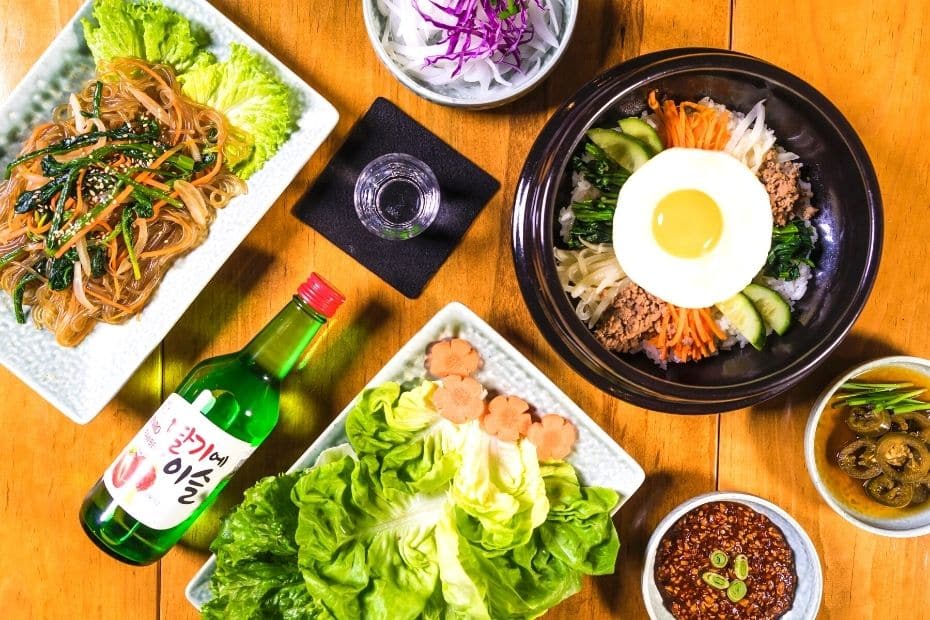
A meal in Korea is like a window into the local culture, where sharing food is core to a harmonious society, and meals are designed to be enjoyed by many people. This makes eating out a stomach-pleasing and soul-warming event that can be lots of fun and lead to some amazing nights out.
Eating traditional Korean meal can be a spectacle that’s best shared with friends or family. Korean meals come with an array of side dishes to sample, a large pot of something yummy boiling or frying in the centre of the table, and food lovingly prepared by chefs who specialise in this one dish.
If you’re eager to know more about Korean dining culture and want to know about what to do and how to behave, then make sure to keep reading till the end of this article. There are some Korean dining tips that will help you learn about the language, culture, and etiquette of eating out in Korea.
Note about prices: food prices have been rising sharply over the last few years and this has led to a rise in the cost of eating out. If you visited Korea in the past, don’t be surprised to see costs have risen 10% or more. Prices quoted are averages and don’t include extras such as drinks.
Now let’s begin this culinary journey. Make sure you’ve got something to nibble on while you read, as you’re going to feel hungry by the end of this!
The 5 Best Traditional Korean Dishes You Must Try
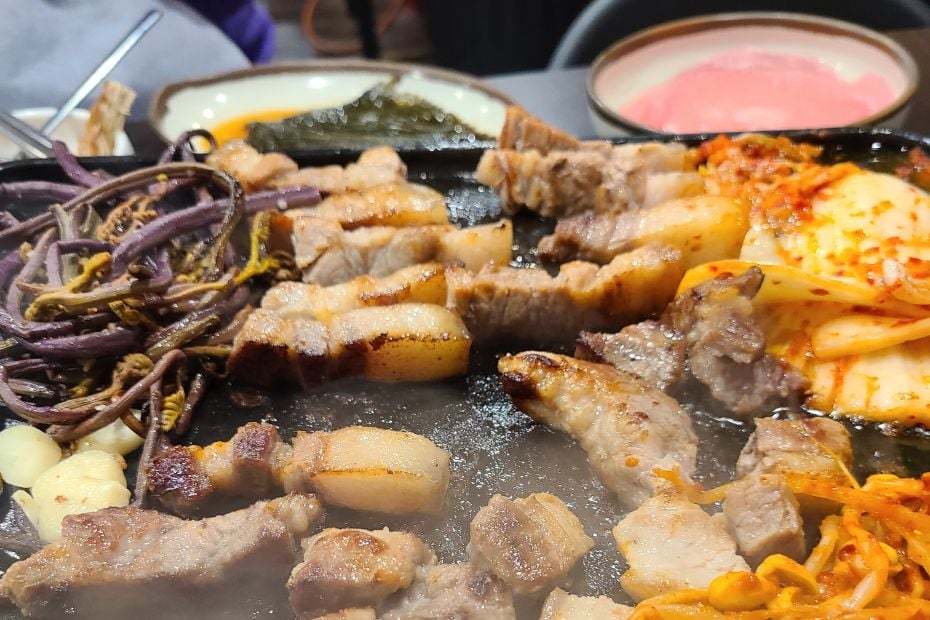
There are many incredible traditional Korean meals to try when you visit Korea, but which ones are the ones you simply can’t leave Korea without trying? If you’re only travelling to Seoul for a weekend or quick stopover, these 5 traditional Korean dishes should definitely be on your eating out itinerary!
1: Samgyeopsal – Korean BBQ
There are numerous options for BBQ in Korea, with different cuts of meat, but the definitive experience comes from eating samgyeopsal (literally – three layered pork). It’s thick, juicy, cheap, and you can find it everywhere. Most Korean BBQ restaurants will serve samgyeopsal as well as other cuts of meat and you buy them in 100g to 200g servings, which is usually enough for one person.
I have to admit, this is my favourite traditional Korean food. It’s different from a British or American BBQ, but certainly gives you the same fix and will leave you feeling stuffed. Instead of Western BBQ, which is usually served with bread rolls and buns, with Korean BBQ you instead wrap the meat in a slice of lettuce or similar veggie and add in extras such as a clove of garlic, onions, bean sprouts, and various sauces and salts.
Why you should try it: The iconic Korean meal that is more of a social event than a simple meal. Eat, drink, laugh, and end up in a meat coma with a smile on your face. BBQ meals aren’t cheap and you often spend more than you realise, but that’s because you’re having fun chatting and eating with a bottle of soju or two.
Cost : W15,000+ Korean : 삼겹살 Where to try in Seoul : 853 Korean BBQ
2: Kimchi Jjigae – Kimchi Stew
Kimchi jjigae is a delightful mix of cabbage kimchi, tofu, cellophane noodles, pork or tuna, and vegetables, served with a portion of rice. If you’re visiting Korea during the winter time, then any jjigae (stew) is the perfect way to recover from the cold, harsh winter weather.
When the kimchi is sautéed, it becomes softer and releases all its flavour into the stew, creating a hearty broth. You can even add more kimchi as it comes as a side dish, too. The best way to eat it is to put a bit of rice on your spoon, dip it in the broth, then top it with the other ingredients.
Why you should try it: There are so many reasons to try a steaming bowl of kimchi jjigae, especially if you’re visiting Korea during winter. This traditional Korean dish is packed with authentic Korean ingredients, including healthy kimchi.
Cost : W10,000+ Korean : 김치 찌개 Where to try in Seoul : Guldari Shikdang
3: Tteokbokki – Spicy Stir Fried Rice Cakes
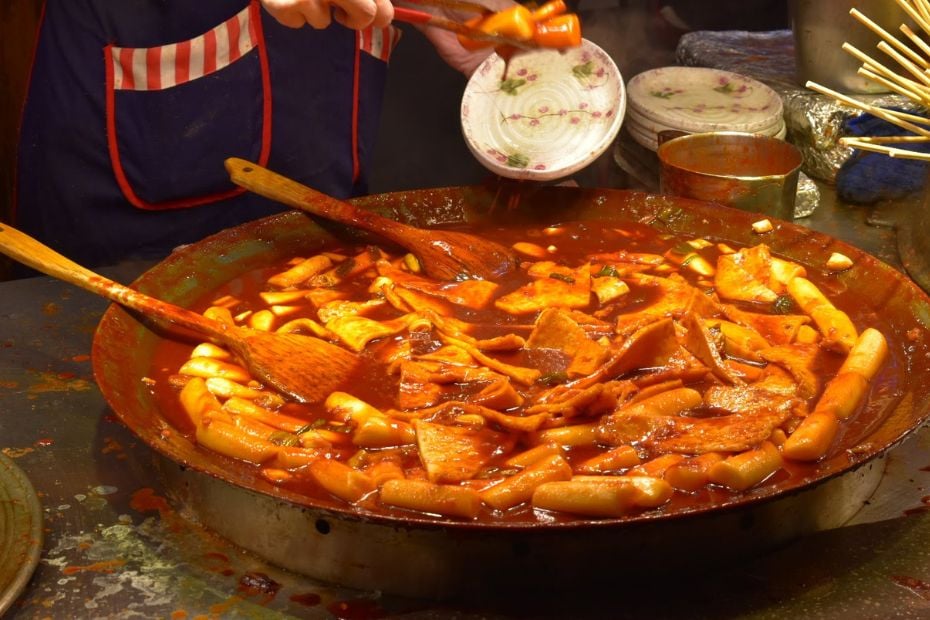
Tteokbokki is a blend of steamed and sliced rice cakes (tteok 떡), fish cakes (odeng 오뎅), and scallions in a sweet and spicy sauce with plenty of chilli paste. If you’re eating in a restaurant, then add in some cheese and noodles for a filling meal. This is one of the traditional Korean dishes you shouldn’t pass up if you’re exploring traditional markets in Korea.
Best eaten fresh from the market vendors, this spicy, salty mishmash of classic Korean ingredients is perfect as a snack or meal. As you can tell from the red colour, it’s going to be spicy! Spiciness and the ingredients in the sauce can vary between vendors – everyone has their own secret recipe. Try it more than once and see which is the best.
Why you should try it: The perfect Korean winter food . Heart-warming and filling on a cold winter’s day. Cheap, delicious, and found in many places.
Cost : W10,000+ (Meal) Korean : 떡볶이 Where to try in Seoul : Tteokbokki Town
4: Bibimbap – Mixed Rice With Vegetables
Literally meaning ‘mixed rice’, bibimbap is a fun, healthy jumble of vegetables, rice, chilli paste, and is topped off with a fried egg. Take all the ingredients and mash them together yourself. Add as much gochujang 고추장 (chilli paste) as you can handle and serve until everything is mixed together like a tossed salad.
Bibimbap is served either cold, in a metal bowl, or heated in a hot stone bowl (dolsot bibimbap 돌솥비빔밥). The hot version is the best version in my opinion as the egg and rice stick together and cook on the hot stone. If you’re visiting Jeonju, then make sure you try bibimbap there as they have their own version called Jeonju-bibimbap and it’s arguably one of the best.
Why you should try it: Another one of Korea’s national dishes. Popular in Korea and overseas. It’s a healthy mix of vegetables and spices that is perfect in winter or summer.
Cost : W10,000+ Korean : 비빔밥 Where to try in Seoul : Nongri Bapsang
5: Gimbap – Seaweed Wrapped Rolls
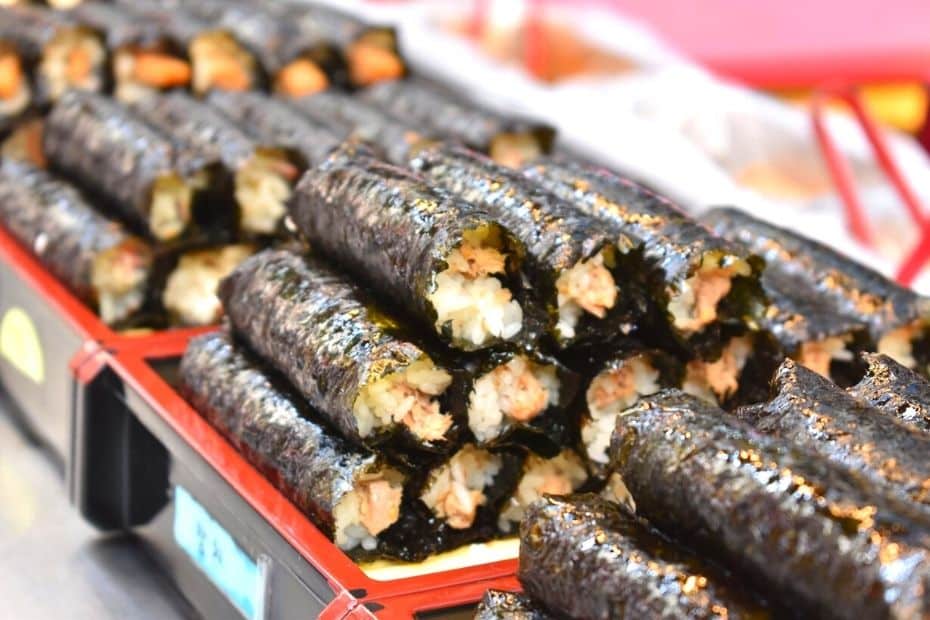
Gimbap (also spelt kimbap) is extremely versatile and can be bought as a snack from a convenience store, or the main part of a meal in a traditional Korean restaurant. This simple dish is actually one of the most popular traditional Korean dishes for students and people looking for a light, low priced lunch. The gimbap pictured above are the little roll gimbap (mayak gimbap – 마약김밥), but this dish is typically a larger roll sliced up like a California roll.
I personally love gimbap as it is light, healthy, and comes in a range of mouth-watering fillings, such as cream cheese, bulgogi (fried beef), lobster, and lots more. Typically I eat at least one gimbap a week as it’s perfect for lunch on the go. This is a great meal option for those who want to cut their costs while travelling to Korea. It’s also great when you want to go hiking and need to pack a filling snack for the journey.
Why you should try it: This Korean street food is a lot healthier than many of the other street eats you’ll find in Seoul. Gimbap has lots of great fillings, it’s so cheap, and so convenient.
Cost : W4,000+ (Meal) Korean : 김밥 Where to try in Seoul : Yeonhee Gimbap
Planning to visit Korea? These travel essentials will help you plan your trip, get the best deals, and save you time and money before and during your Korean adventure.
Visas & K-ETA: Some travellers to Korea need a Tourist Visa , but most can travel with a Korean Electronic Travel Authorisation (K-ETA). Currently 22 Countries don’t need either one.
How To Stay Connected : Pre-order a Korean Sim Card or a WiFi Router to collect on-arrival at Incheon Airport (desks open 24-hours). Alternatively, download a Korean eSIM for you travels.
Where To Stay : For Seoul, I recommend Myeongdong (convenient), Hongdae (cool culture) or Gangnam (shopping). For Busan, Haeundae (Beach) or Seomyeon (Downtown).
Incheon Airport To Seoul : Take the Airport Express (AREX) to Seoul Station or a Limo Bus across Seoul. Book an Incheon Airport Private Transfer and relax to or from the airport.
Korean Tour Operators : Tour companies that have a big presence in Korea include Klook , Trazy , Viator , and Get Your Guide . These sites offer discounted entry tickets for top attractions.
Seoul City Passes : Visit Seoul’s top attractions for free with a Discover Seoul Pass or Go City Seoul Pass . These passes are great for families and couples visiting Seoul – you can save lots.
How To Get Around : For public transport, grab a T-Money Card . Save money on Korea’s high speed trains with a Korea Rail Pass . To see more of Korea, there are many Rental Car Options .
Travel Money : Use money exchanges near Myeongdong and Hongdae subway stations for the best exchange rates. Order a Wise Card or WOWPASS to pay by card across Korea.
Flights To Korea : I use flight comparison sites such as Expedia and Skyscanner to find the best flights to Korea from any country. Air Asia is a good option for budget flights from Asia.
How To Learn Korean : The language course from 90 Day Korean or Korean Class 101 both have well-structured lessons and lots of useful resources to help you learn Korean.
Top 12 Authentic Korean Meals With Meat
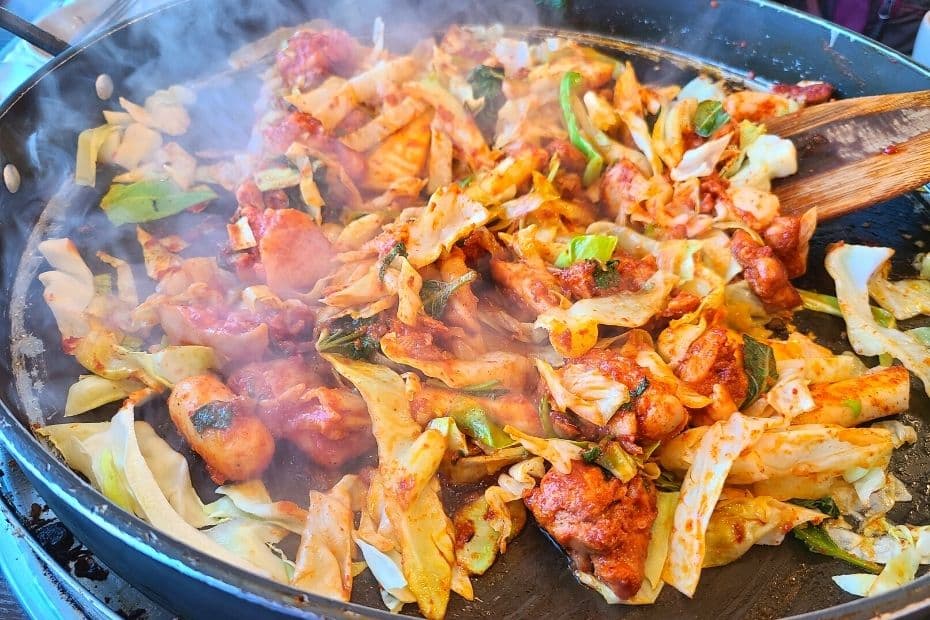
Meat-lovers visiting Korea will have no problems finding delicious and filling Korean traditional dishes. There are many Korean meals that come with meat, including dishes with beef, pork, chicken, duck, and lamb. These dishes often involve fried meats, but there are also steamed meats and stews, too.
1: Chuncheon Dakgalbi – Spicy Stir Fried Chicken
Chuncheon dakgalbi is another of those traditional Korean dishes for those people who love fried meat. This dish combines marinated chicken with vegetables, rice cake (tteok 떡 ), chilli paste sauce, and other spices. You can also add noodles and cheese.
These ingredients are chucked in a large pan and stir fried at your table. A waiter will come every few minutes and mix it all up for you. This makes it a great food to experience, not just eat. Although dakgalbi has spread throughout Korea, it first started in Chuncheon and this is the best place to try it. Visit Chuncheon Myeongdong Dakgalbi Street for the finest examples of one of Korea’s best traditional Korean dishes.
Why you should try it: A quintessentially Korean dish that mixes meat, vegetables, and spices together and fries them in a big metal pan. Add cheese for a greedy, satisfying meal.
Cost : W15,000+ Korean : 춘천 닭갈비 Where to try in Seoul : Chuncheon Dakgalbi
2: Samgyetang – Ginseng Chicken Soup
Samgyetang, a meal in a bowl, contains a whole small chicken packed with rice, garlic, jujube, and ginseng. The thick soup absorbs all of this whilst cooking, leaving a soft, tender chicken and an aromatic, hearty broth. Perfect! Ironically, this hot, healthy, and delicious ginseng chicken soup is most popular during summer.
Koreans have a saying that you should fight heat with heat, meaning that you should eat hot food when it’s hot outside. As strange as it sounds, it actually works. As with most traditional Korean dishes, you’ll find the best samgyetang in a traditional Korean restaurant. You can sit on the floor at a long table and indulge in the soup with a wide range of side dishes.
Why you should try it: This is a filling meal that is worth the cost. Perfect during winter, and (if you believe the stories) great Korean summer dish . Healthy and full of ingredients you might not find in your own country.
Cost : W15,000+ Korean : 삼계탕 Where to try in Seoul : JangAn Samgyetang
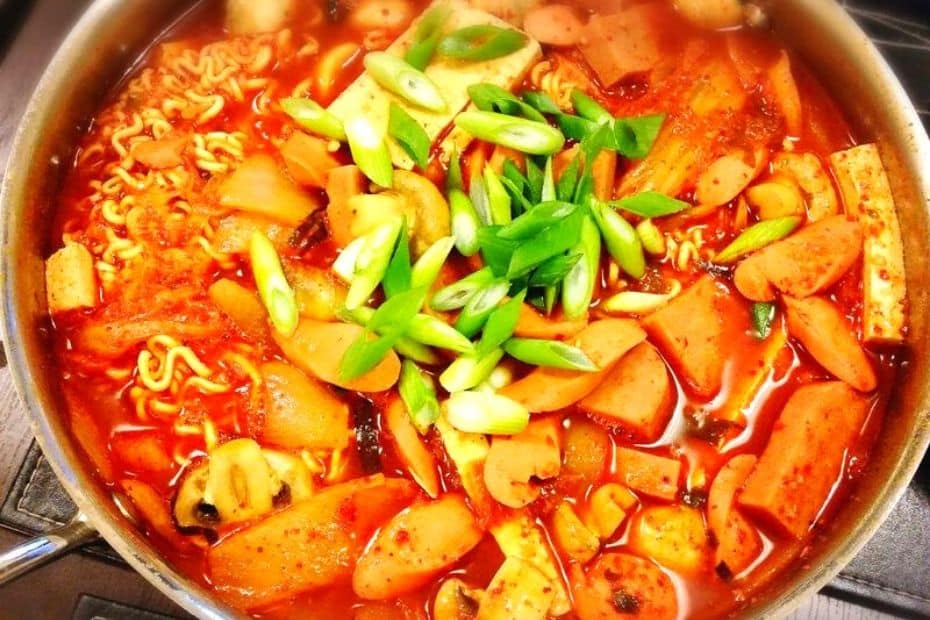
3: Budae Jjigae – Army Stew
Budae jjigae was created by adding various items from American army bases into a regular jjigae (stew). This included Spam, sausages, baked beans, American cheese, as well as some local items, such as instant noodles and tteok (rice cakes).
If you’re wondering how such an obviously foreign food item made it into a traditional Korean dish, the answer goes back to the Korean War. Meat was hard to come by then and the American soldiers provided the locals with food aid. This unique fusion of American and Korean foods created one of the best dishes in Korea to eat on a cold day. The bright red stew is packed full of rather unhealthy foods, which makes it taste great and gives you lots of energy!
Why you should try it: Great in cold weather and a guilty treat that’s not just for soldiers. A delicious mix of East and West.
Cost : W10,000+ Korean : 부대찌개 Where to try in Seoul : Heungbune Budae Jjigae
4: Sundae – Blood Sausage
One of the oldest traditional dishes in Korea, sundae might make people squeamish at first but it shouldn’t be missed. Sundae is kind of a cross between haggis and black pudding. It is also really delicious and a wonderful, cheap snack. Sundae traditionally contains pig or cow’s intestines mixed in with rice and vegetables and has long been a regular family meal in Korea.
After the Korean War, cellophane noodles were added inside to bulk it out, and it became a cheap street food, too. Eat sundae by dipping it into a bowl of salt or other seasoning. It goes well with a cold beer on a warm evening. There’s also a soup version with slices of sundae, green veg, and rice in a hearty broth.
Why you should try it: Because it’s unique and cheap. One for people who want to indulge in Korean dishes. Live like a student and have a lively meal with sundae and beer.
Cost : W8,000+ (Meal) Korean : 순대 Where to try in Seoul : HongdaeSak Sundae

5: Yangnyeom Tongdak – Sticky Fried Chicken
Yangnyeom tongdak might not seem like the most authentic of all traditional Korean dishes, but its popularity means that it deserves a place on this list. With more than 20,000 fried chicken restaurants in Korea, this is definitely one of the national dishes.
Yangnyeom tongdak stands out above other flavours and types of chicken due to its finger licking qualities. This bold mix of sweet, sour, and spicy sauce lavishly spread over regular fried chicken just works. Topped off with crushed nuts, it’s irresistible. You can find this as a snack at a Korean baseball game, as a meal on its own, or anywhere selling Korean street food. Grab a cup of it and dip your fingers in if you don’t mind getting messy, or use some chopsticks if you do.
Why you should try it: The combo and chicken and beer is one enjoyed around the world, but few countries do it as well (and as reasonably priced) as Korea.
Cost : W15,000+ Korean : 양념 통닭 Where to try in Seoul : Bareun Chicken
6: Bossam – Wrapped Boiled Pork
A typical bossam meal comes with a big plate of sliced boiled pork, at least 3 types of kimchi, raw garlic, dipping sauces, and several different things to wrap all of that in. Koreans love to wrap their food in lettuce and cabbage and bossam takes this to another level.
This is a meal all about dipping and wrapping slices of boiled pork – which is more appetising than it sounds. It’s also healthier than fried alternatives. Choose your favourite ingredients, select one of the dipping sauces or salt, wrap them all up in a lettuce, cabbage, or sesame (perilla) leaf, and then eat in one go. The best part of this meal is experimenting with combinations of all of these separate options.
Why you should try it: As much fun as eating samgyeopsal, but less smoky and probably a bit healthier. This is also a great dish to enjoy whatever the weather.
Cost : W15,000+ Korean : 보쌈 Where to try in Seoul : Insadong Manul Bossam
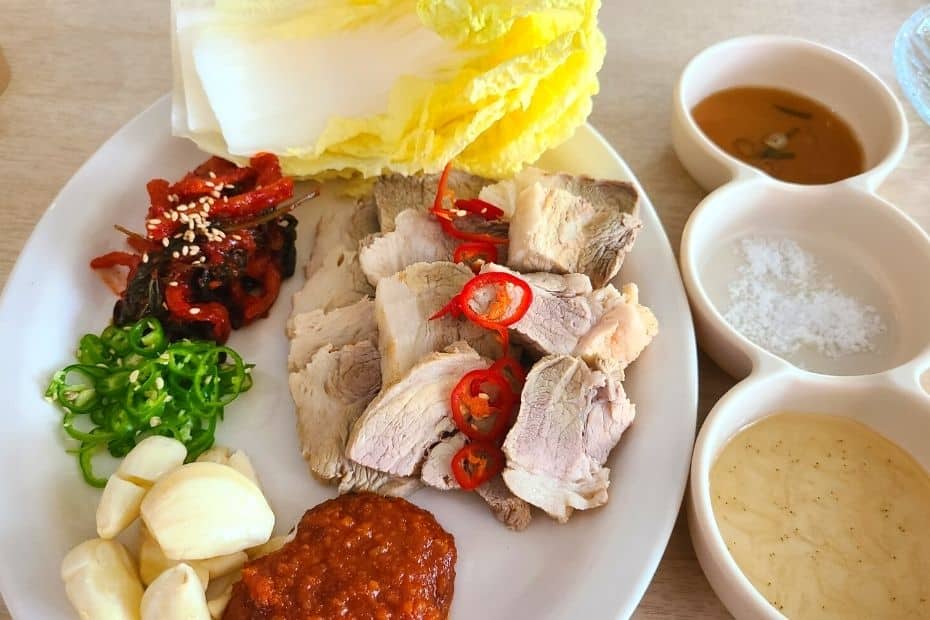
7: Bulgogi – Korean Grilled Beef
Bulgogi is one of the oldest traditional Korean dishes you can find. Literally translated as fire (bul 불) meat (gogi 고기), this dish is very adaptable and bulgogi can be found in many different meals. You will usually find it barbecued though.
Bulgogi usually comes with sliced beef, which is marinated and then grilled to give it a wonderful smoky, rich meaty taste. It can be other types of meat, too, including pork. Wrap the freshly cooked meat in a lettuce leaf (like samgyeopsal), add extras, and then shove it into your mouth in one go. This style of eating might seem strange to foreigners, but is completely normal to Koreans.
Why you should try it: A nice alternative to samgyeopsal, especially if you can’t eat pork. You’ll get all the same side dishes and have fun wrapping up the meat, but this time it’s thin slices of beef.
Cost : W15,000+ Korean : 불고기 Where to try in Seoul : WooRae-Ok Bulgogi
8: Byeo Haejangguk – Bone Hangover Soup
There are many types of haejangguk (hangover soup) in Korea that are eaten late at night or in the early morning to cure headaches, but the best of them is byeo haejangguk. This version comes with meat-clad bones, a thick broth, and lots of seasoning. The meat falls off the bone easily as you mix together meat, soup, rice, and side dish and send it down to your awaiting insides, ready to be embraced and to start repairing your body after a night of drinking.
Of course, you don’t have to eat this only when you have a hangover. It’s great any time, especially in winter. A hot bowl of this with a cool beer, and lots of side dishes is the perfect way to get through a cold January night.
Why you should try it: This dish is perfect on a cold day and will revive and restore you when you’re not feeling well. Fills your belly and your soul.
Cost : W8,000+ Korean : 뼈 해장국 Where to try in Seoul : Sindong Gamjatang
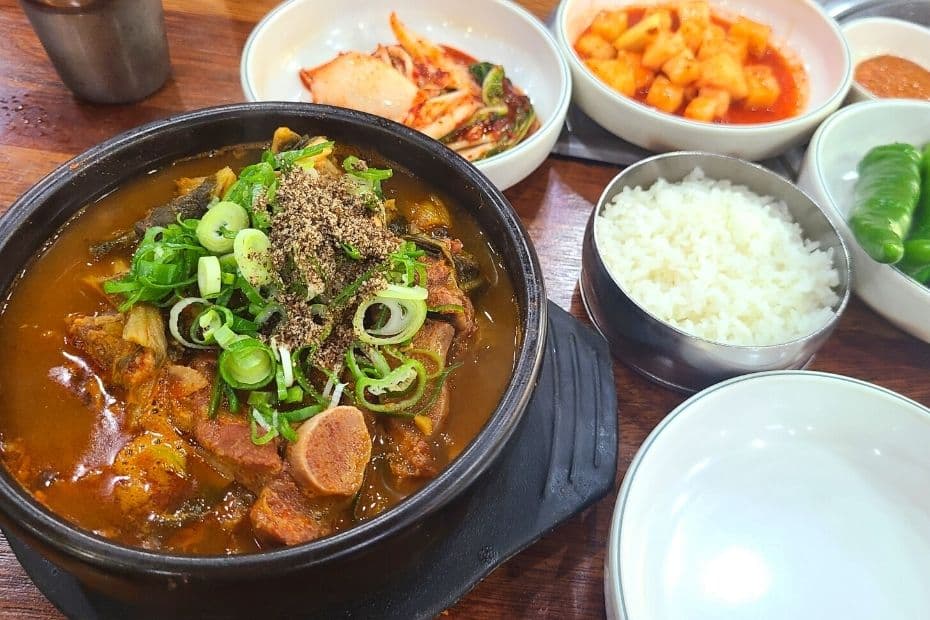
9: Galbi-Gui – Grilled Ribs
Galbi-gui is a type of grilled dish that is made with marinated pork or beef short ribs in a ganjang-based sauce (Korean soy sauce). In Korean, galbi (or kalbi) literally means “rib” and can often indicate uncooked ribs. Unlike ribs in the USA, these are often served in long strips of meat that you’ll need to cut into smaller sections yourself.
As galbi-gui is typically served raw, you get to cook the seasoned ribs on a tabletop grill in the centre of the table. This makes it not only a delicious culinary experience, but also a fun one where you’re in charge of cooking the meal. Don’t worry, staff will help if you’re in trouble.
Why you should try it: These finger-licking ribs are really hard to eat with chopsticks, but worth the effort. The meat is juicy and tender.
Cost : W15,000+ Korean : 갈비구이 Where to try in Seoul : Hangaram Bonjeom
10: Kimchi Bokkeumbap – Kimchi Fried Rice
Kimchi bokkeumbap is a humble Korean dish made basically with kimchi, leftover rice, and whatever else you might have to hand. You’ll find kimchi bokkeumbap served as a meal with spam and spring onions added, as well as a fried egg served on top. The best way to enjoy kimchi bokkeumbap is after a Korean BBQ. Add kimchi and rice to the BBQ hot plate, mix in any leftover meat, and fry it in the oil left on the pan. Perfect!
Since Korean homes almost always have rice and kimchi available, kimchi fried rice is a favourite go-to meal whenever there seems to be nothing to eat at home. This traditional Korean dish is especially popular among young people who are living on a low budget as it is a quick-fix meal, inexpensive to prepare, yet delicious and filling.
Why you should try it: If you want to experience a traditional Korean packed lunch, called dosirak, then order a meal of kimchi bokkeumbap. Old school Korean restaurants will serve it in the metal lunch boxes kids carried to school.
Cost : W8,000+ Korean : 김치볶음밥 Where to try in Seoul : Ajossi-ne

11: Yukgaejang – Spicy Korean Soup
Yukgaejang is a spicy Korean soup consisting of shredded beef (usually brisket), scallions, gosari (eagle fern), bean sprouts, leeks, or mushrooms. The soup is seasoned with chili paste, which gives it its distinctive bright red colour, as well as soy sauce, sesame oil, garlic, and chili flakes.
Yukgaejang is best served piping hot, with a bowl of rice on the side and generous helpings of kimchi to go with it. As it’s both hot and spicy, this dish is best eaten in winter when you need to warm yourself up or clear your sinuses (make sure you’ve got tissues available when eating this). There is a ‘white’ version that’s not so spicy, too.
Why you should try it: This is a simple yet filling meal that is cheap and quick. There are many yukgaejang places around so it’s easy to find.
Cost : W8,000+ Korean : 육개장 Where to try in Seoul : Jongnogob Yukgaejang
12: Seolleongtang – Ox Bone Soup
Seolleongtang or ox bone soup is a Korean broth made from ox bones (mostly leg bones), brisket and other cuts. A bowl of seolleongtang is served as-is and if you want to change the flavour, you can do so with the condiments at the table. However, I recommend trying it as-served as the chefs at these restaurants have one job and that’s to make the best broth every time.
This dish is traditionally served in the bowl it was cooked in, boiling hot and with a fried egg on top with white rice on the side. Be careful when it arrives, but don’t wait too long to start tucking in, just blow on the spoon a few times and you should be safe to munch away.
Why you should try it: A simple, lighter Korean meal than some of the other traditional dishes listed here. If you’re feeling tired of heavy food, try a bowl of seolleongtang.
Cost : W8,000+ Korean : 설렁탕 Where to try in Seoul : Singawon
Make Traditional Korean Dishes In Seoul

Want to try making your own traditional Korean dishes? There are loads of great opportunities to experience cooking traditional Korean food in Seoul. Why not try your hand at making some of these delicious traditional Korean dishes and create some fun memories on your travels?
Top 8 Korean Dishes With Vegetables & Noodles
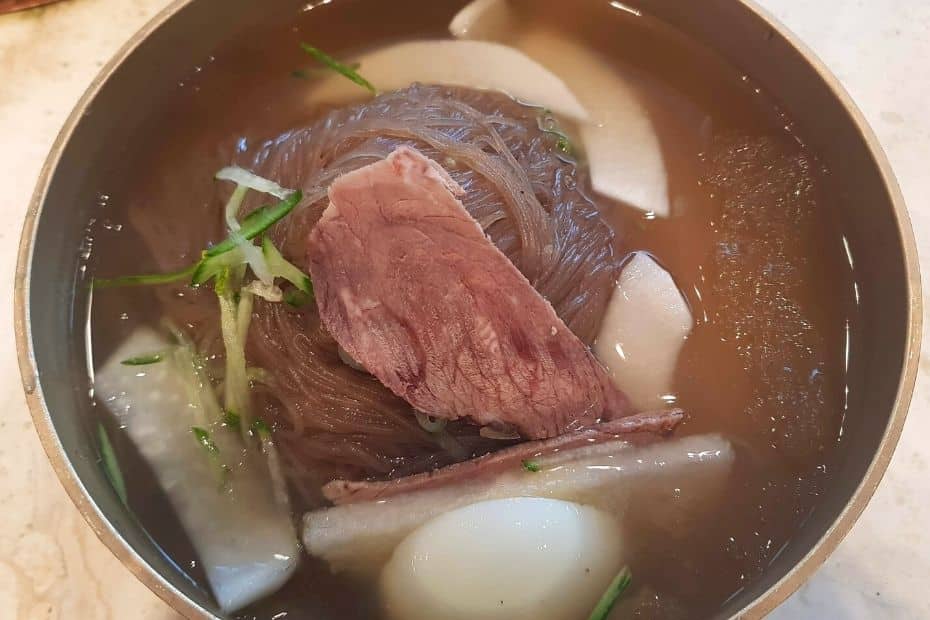
These popular Korean dishes are great options for vegetarians or those looking to enjoy (mostly) meat-free noodle dishes, which are perfect in all seasons. Discover the healthy side of Korean cuisine that uses local ingredients and traditional techniques to create satisfying savoury meals you’ll love.
1: Naengmyeon – Ice-Cold Noodles
Naengmyeon is simple dish of cold buckwheat noodles. There are two main varieties – mul naengmyeon 물냉면 (ice-water cold noodles) and bibim naengmyeon 비빔냉면 (spicy cold noodles), both of which are perfect for summer. I prefer the mul naengmyeon (pictured) as the noodles are drowned in icy-cold water and become so refreshing. It’s topped with thin pieces of radish, cucumbers, and a boiled egg and seasoned with vinegar and mustard.
Bibim naengymeon is mostly the same but instead of icy-cold water, the noodles are splashed with spicy chilli paste and form a deadly bowl of spicy noodles. This dish can be deceptively spicy, so be careful. I find that mul naengmyeon is perfect in winter while the bibim naengmyeon is suitable for any time of year.
Why you should try it: It might not look like much, but it is as refreshing as an ice cream on a hot summer’s day. The cold noodles give you back lost energy during the heat.
Cost : W8,000+ Korean : 냉면 Where to try in Seoul : Gom Naengmyeon
2: Kalguksu – Knife-Cut Noodle Soup
Literally meaning knife-cut noodle soup, kalguksu has chunky noodles because they are cut by hand and not spun, giving the noodles a rich taste. Extra ingredients can include shellfish, ground beef, chicken, some vegetables, or cilantro. Perfect during winter in Korea , this hot, steaming broth is simple but can refresh any weary traveller. It is also deceptively filling and hard to finish.
You can find freshly-cut noodles in Korea’s traditional markets. Watching chefs hack up noodles, throw them violently into the broth, and serve them directly to you, fresh and spongy, is a culinary experience in itself. Not only are the noodles some of the best you’ll find, but the broth in some kalguksu restaurants is perfected after decades of experimentation, where they only serve this one dish and have mastered it and made it as good as any meal can be.
Why you should try it: Very filling. The broth is thick and the noodles are thicker. If you find a kalguksu place with a lot of people in it, don’t miss the chance to try it.
Cost : W8,000+ Korean : 칼국수 Where to try in Seoul : Sarangbang Kalguksu
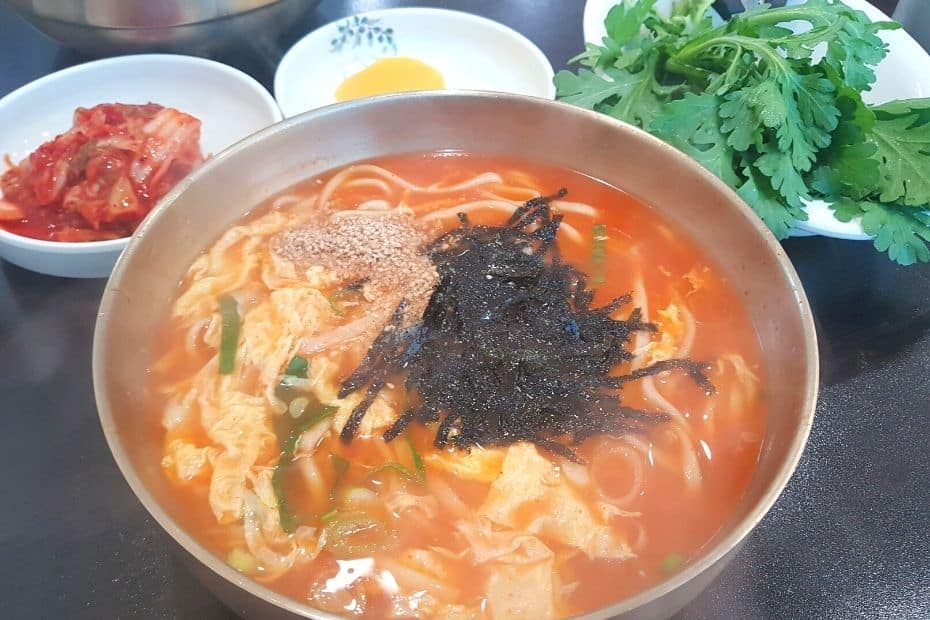
3: Manduguk – Dumpling Soup
Korean dumplings (mandu 만두) are best when they’re in their own soup – manduguk. Manduguk comes in a small or large bowl full of various mandu and squeezed in with tteok 떡 (rice cakes), sliced vegetables, ground meat, or egg. The mandu come with a variety of different fillings, including kimchi, meat, shrimp, and vegetables.
You usually get kimchi or meat dumplings in a manduguk, but good restaurants will have a range of options. As with some other traditional Korean dishes, there is a special day that people eat manduguk, and that is New Year’s Day. Start the New Year with a bowl of manduguk if you’re in South Korea. Families work together to make the dumplings by hand.
Why you should try it: Chew and munch on this hot dish during winter, trying each of the different types of mandu to find your favourite.
Cost : W10,000+ Korean : 만두국 Where to try in Seoul : Bukchonson Mandu
4: Japchae – Stir-Fried Glass Noodles
Japchae is a classic Korean dish that translates to ‘mixed vegetables’. This simple dish is a savoury and sweet combination of ingredients such as stir-fried glass noodles, mushrooms, spinach, carrots, chilli and bell peppers, garlic chives, and more. The main star of this dish is the glass noodles.
Japchae is a must-try for its unique texture and flavour. It’s really easy to eat as the ingredients are all soft and tender and it accompanies greasier (fried) foods well. Japchae is often served as a side dish during Korean holidays or special occasions and if you ever go to a Korean house, they’ll probably have a big tub of it in the fridge ready to dollop onto your plate.
Why you should try it: A healthy, simple meal that goes best as part of a big meal with a selection of other dishes to try. If you try a Korean royal-court dinner spread, expect to find this.
Cost : W8,000+ Korean : 잡채 Where to try in Seoul : Hanyang Jungshik
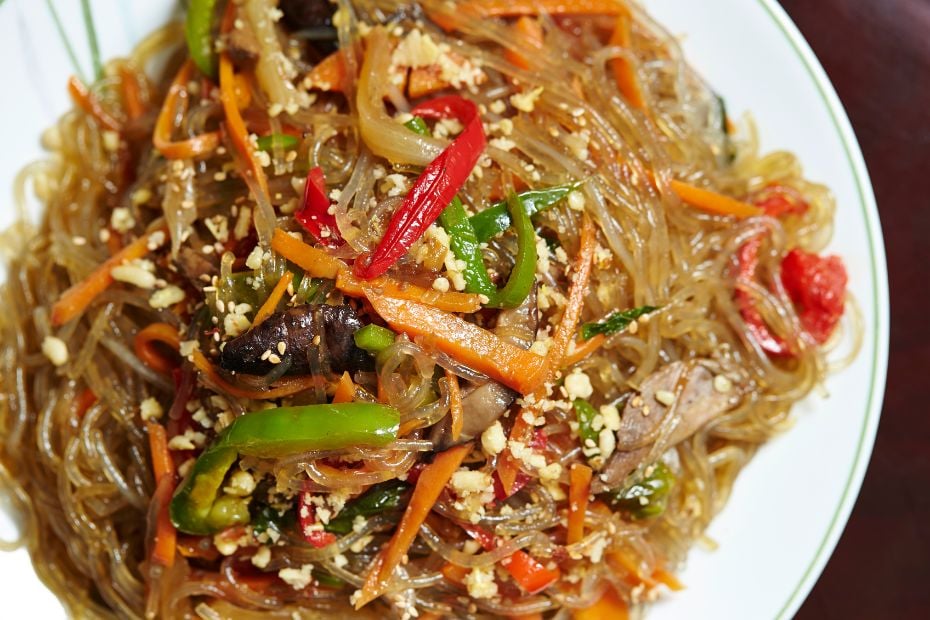
5: Sundubu-Jjigae – Spicy Soft-Tofu Stew
Sundubu-jjigae is a variety of traditional Korean stews. Besides numerous other ingredients, the foundation of sundubu is uncurdled tofu. Since the tofu is not strained, its consistency is not firm, but rather soft and silky, making it melt into the rest of the dish and provide a soft bite of deliciousness.
A bowl of sundubu-jjigae can be vegetarian-friendly, but can also include meat (usually beef) or a variety of seafood (or even both together). The main ingredients are a healthy mix of onions, zucchini, scallions, mushrooms, and garlic, which are all softened up in the hot spicy broth. Remember to dip some rice in, too.
Why you should try it: This truly traditional Korean meal is great when you’re feeling down and need a healthy pick-me-up.
Cost : W8,000+ Korean : 순두부찌개 Where to try in Seoul : Jeongwon Sundubu
6: Juk – Korean Rice Porridge
Juk is a Korean savoury rice porridge made with various ingredients, such as pumpkin, abalone, chicken, or mushrooms. Each version of juk typically comes with just one of these extra ingredients to add a twist of flavour.
This is a really popular meal for people who are feeling sick and if you eat out in a traditional Korean juk restaurant, you’ll probably hear some people sniffing away while wating for their healing bowl of porridge. Modern Koreans have adapted to the idea of having this healthy porridge as breakfast, light meal or as a comfort food, too.
Why you should try it: A bowl of juk during winter, or any time when you’re suffering, will really give you your energy back. And unlike medicine, this tastes really great!
Cost : W10,000+ Korean : 죽 Where to try in Seoul : Bon Juk
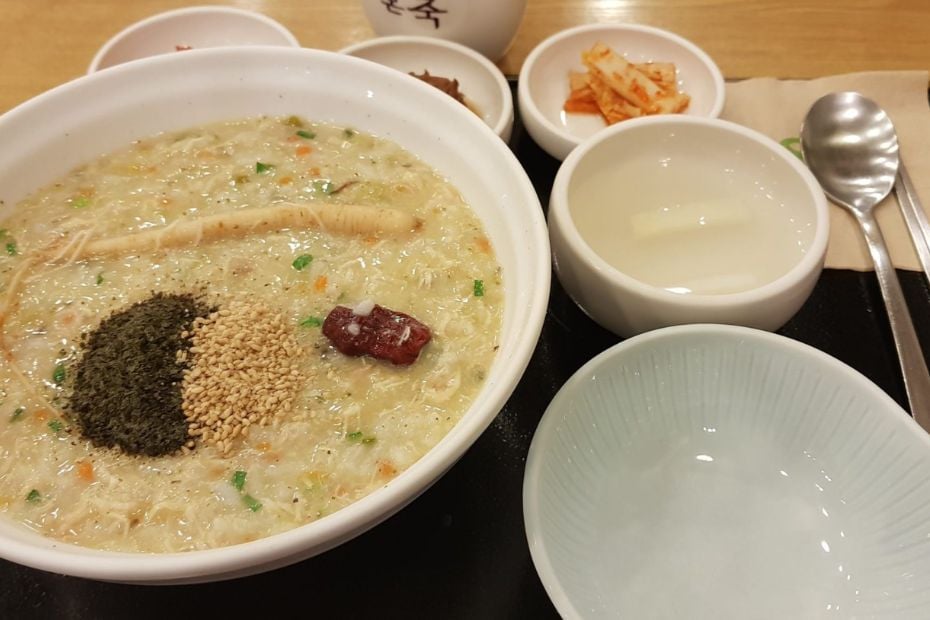
7: Jjajangmyeon – Noodles In Black Bean Sauce
Jjajangmyeon is a Korean-Chinese noodle dish topped with a thick sauce made of chunjang paste, diced pork, and vegetables. Although this dish contains meat (or sometimes seafood), the strength of the black bean sauce dominates the taste of this meal, as well as the colour! If you go to Incheon, make sure to try jjajangmyeon as this is the home of this popular Korean dish.
This black noodle dish is one of the most popular student foods or cheap eats in Korea and is often mentioned in K-dramas. There’s even a special day when people in Korea eat jjajangmyeon called Black Day (because of the colour of the sauce) – a kind of anti-Valentine’s Day when single people get to enjoy going out for a meal.
Why you should try it: If you want to experience life as a Korean student, eating a bowl of cheap jjajangmyeon is the best place to start. It’s a popular student dish due to its low price.
Cost : W6,000+ Korean : 짜장면 Where to try in Seoul : Gawon
8: Doenjang-Jjigae – Fermented Soybean Stew
Doenjang-jjigae is a staple Korean stew made with doenjang (된장), a fermented soybean paste, which gives it a strong taste and smell. It’s cheap and easy to make doenjang-jjigae, which is why you’ll find it served (often for free) with larger shared traditional Korean meals.
This hearty stew is often eaten regularly regardless of occasion or time of day. Depending on the other ingredients added, you can make endless variations of the stew. The large number of vegetables in doenjang-jjigae make it quite healthy, but if you’re looking for a vegetarian dish, this usually isn’t one as it contains pork, too.
Why you should try it: This rich, thick stew has a hearty broth and lots of vegetables inside. It often comes as a free extra with sharing meals but is worth trying by itself.
Cost : W8,000+ Korean : 된장찌개 Where to try in Seoul : Moonsuk-iminari
Vegetarian and vegan travellers to Seoul and Korea don’t need to worry as there are an increasing number of vegetarian-friendly restaurants and vegan-friendly restaurants in Seoul. There are plenty of traditional Korean dishes, including Korean temple cuisine , which are naturally vegan-friendly, too.
Top 5 Classic Korean Dishes With Fish & Seafood
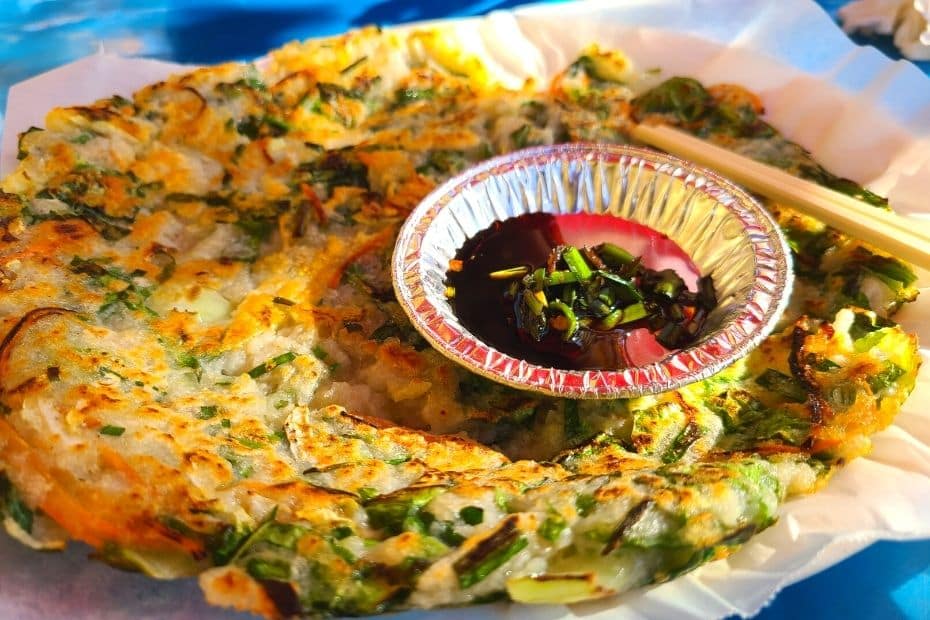
Korea is a peninsula surrounded by coasts on three sides with a bounty of fresh fish and seafood. There are many Korean dishes with fish and seafood prepared in a variety of forms, including raw, smoked, grilled, baked, and even fermented. Head to coastal cities such as Busan for these dishes.
1: Jeon – Korean Savoury Pancake
Jeon (Korean savoury pancakes) come with a variety of fillings, including kimchi, squid, potato, beef, pork, and more. The most popular of these is haemul pajeon 해물 파전 (squid and spring onions) and is a great treat when you’re tired and hungry.
If you’re hiking in Korea , you’ll find a lot of restaurants selling jeon. You’ll know them by the chefs frying them on a hot plate outside the restaurant. They’re served fresh to hungry hikers who are craving something filling after a long trek. Dip the jeon in spicy soy sauce and wash it down with another mountain-based speciality – makgeolli (막걸리). Makgeolli is a creamy rice wine that comes in some interesting flavours, such as chestnut, corn, and even banana.
Why you should try it: Embrace Korean culture when you’re out hiking in a national park by ordering a plate of jeon and makgeolli. Perfect after a long day of hiking or sightseeing.
Cost : W18,000+ Korean : 전 Where to try in Seoul : Jeondae Gamdaek
2: Maeuntang – Spicy Fish Stew
Maeuntang is a hot, spicy fish stew made with a range of different fresh fish. How do you know that the fish are fresh? You can usually choose the fish you want to eat from an aquarium outside the restaurant. The fresh fish are cut up and boiled with an assortment of vegetables and a bit of ground beef.
To give this dish its signature spiciness, generous helpings of red chilli paste (gochujang 고추장) and red chilli flakes (gochugaru 고추가루) are added. You can find lots of extras in a bowl of maeuntang, such as shellfish, garlic, and more. They give it an unforgettable taste and help make this one of Korea’s most beloved seafood dishes. A traditional Korean dish for those who love their food with a kick.
Why you should try it: Spice-lovers who want a dish without meat will be pleased with this. Full of fresh ingredients, tastes, and pretty healthy, too. A great combination.
Cost : W10,000+ Korean : 매운탕 Where to try in Seoul : Donggang-Naruto
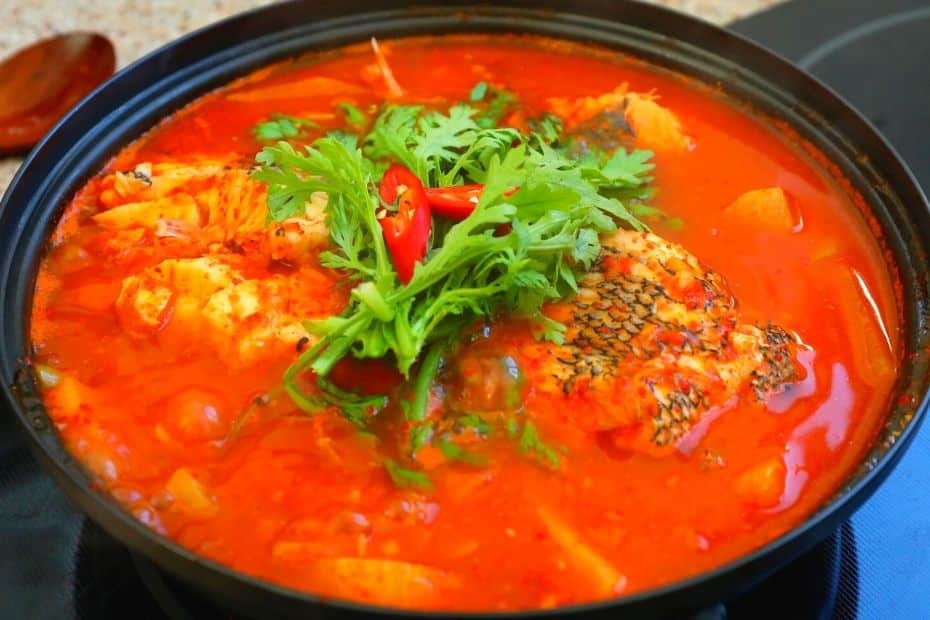
3: Hoe – Sliced Raw Fish
Hoe is one of the best traditional Korean dishes to eat if you’re visiting Busan or any other seaside town or city. This is more than what you’d expect from Japanese sashimi, hoe has other options beyond the normal thin slices of fresh fish. You’ll also find a medley of colourful, and sometimes more alive than expected, types of seafood and shellfish. Additional side dishes could include more seafood, kimchi, garlic, soup, soft crabs, fried fish, and more.
Dip the gentle slices in soy sauce and wasabi and indulge as is, or grab some lettuce or cabbage to wrap the raw fish in. Take a lettuce leaf and place the fish inside, along with some garlic and whatever else you like. Like a Korean BBQ but with seafood.
Why you should try it: You’ll find lots of essential nutrients in this juicy traditional Korean dish. If you’re by the coast, then you shouldn’t miss out on some of the seafood caught fresh from the seas surrounding Korea.
Cost : W20,000+ Korean : 회 Where to try in Seoul : Insaeng-Hoetjib
4: Ojingeo Bokkeum – Spicy Stir Fried Squid
I didn’t expect to like ojingeo bokkeum when I first tried it as I’m not a massive fan of squid. However, the soft, tender texture of the squid in this meal makes it surprisingly delectable and it has more of a meaty taste to it than you’d normally associate with seafood. You should definitely add it to your list whether you like squid or not.
The sweet, spicy sauce adds a lot to the taste of squid and goes well with the vegetables, too. Stir frying the lot together leaves a fresh, crisp, sweet, spicy, and not too fishy dish that you’ll want more and more of. Be careful if you’re not too keen on traditional Korean dishes that pack a spicy punch as this might make your eyes water.
Why you should try it: This is one of the most popular traditional Korean dishes and Koreans eat this at home or out. Easy to make, served quick and fresh.
Cost : W10,000+ Korean : 오징어볶음 Where to try in Seoul : Deoksujeong
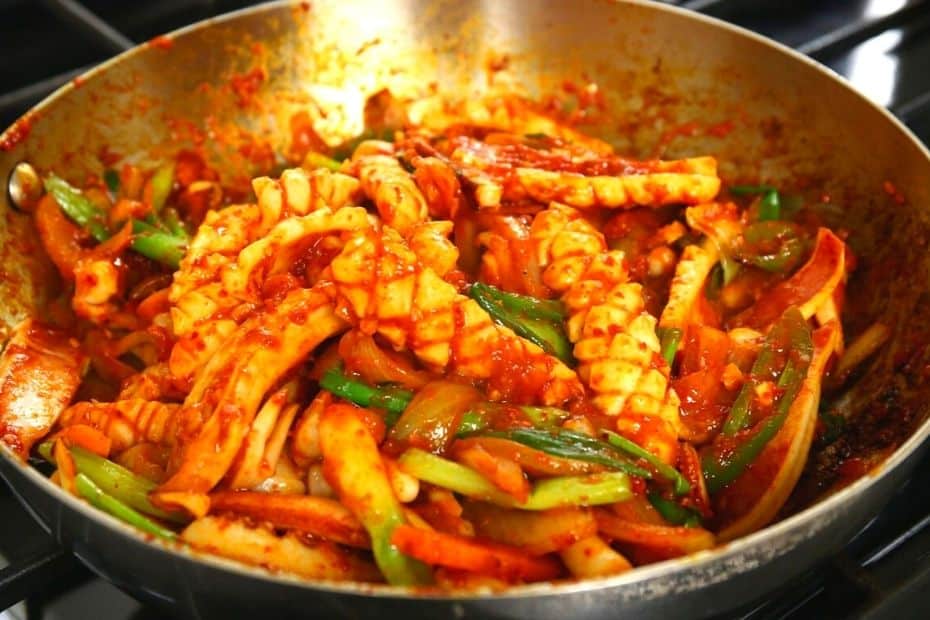
5: Godeungeo-Gui – Grilled Mackerel
Godeungeo-gui is one of the most popular and beloved fish dishes in Korea and one that you’ll often find served in canteens or for school lunch. This authentic dish features grilled mackerel that is generously seasoned with salt and lemon juice and cooked over a charcoal or gas fire until the skin is crispy and the flesh is moist and flaky.
The best thing about godeungeo-gui is that it’s a simple but satisfying dish that showcases the fresh and oily flavour of the fish, which is rich in omega-3 fatty acids and protein. This traditional fish meal is usually served with rice, soup, and various side dishes, such as kimchi, radish salad, soybean sprouts, and seaweed. If you want to try the best godeungeo-gui, eat it during autumn in Korea when mackerel are in season and have more fat.
Why you should try it: A crispy, healthy fish dish that will leave you licking your lips. If you’re visiting Korea in October , it’s a must-have dish.
Cost : W10,000+ Korean : 고등어 구이 Where to try in Seoul : Jeonju Shikdang
Bonus: Kimchi (Fermented Vegetables)
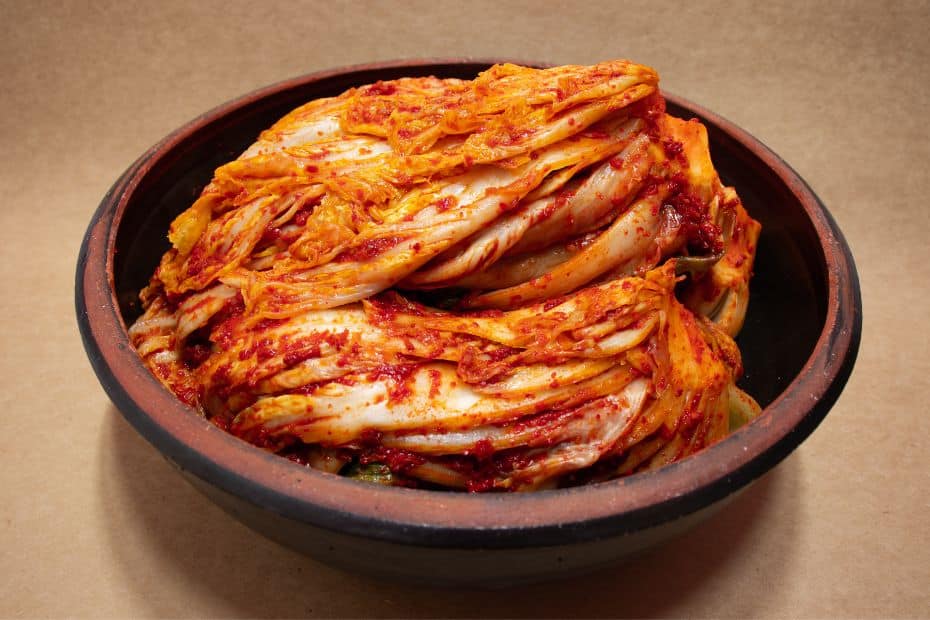
Of course, no list of traditional Korean dishes would be complete without mentioning kimchi. Although this isn’t a dish in itself, you probably won’t eat any of these dishes without it. There is nothing as ubiquitous as kimchi in Korean cuisine and it’s served with every meal of the day (even breakfast!). Korean’s even have a whole day of making kimchi each year called gimjang, which I’ve tried and it’s a lot of fun, but hard work.
Kimchi makes a great side dish to snack on, goes great in a stew, fits nicely in a wrap with BBQ or boiled meat, and even belongs in a taco. Koreans also believe that it has miraculous health benefits, including reducing cholesterol and stopping stomach cancer. It can even keep you young! Whether or not these all work, you certainly can’t travel to Korea without trying kimchi.
Why you should try it: It’s Korea’s national side dish, healthy, and goes so well with many of Korea’s best traditional dishes. I don’t think you’ll be able to visit Korea without sampling kimchi, which you definitely should.
Cost : Free with most meals Korean : 김치 Where to try in Seoul : Everywhere
Make Traditional Korean Dishes At Home
Want to try making these traditional Korean dishes at home but not sure where to start? Here are some Korean cookbooks to teach you how to make a range of tasty Korean treats. Start with the basics, such as tteokbokki and mandu , or jump straight into filling meals like kimchi jjigae and jjajangmyeon .
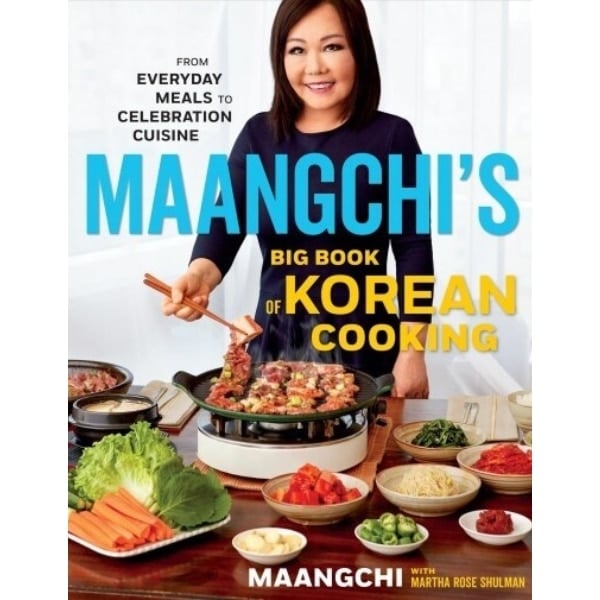
Maangchi’s Big Book Of Korean Cooking
The book contains the favourite dishes by famous Korean chef and YouTuber, Maangchi. She has perfected many Korean meals over the years, from Korean barbecue and fried chicken to bulgogi and bibimbap. Discover Maangchi’s professional approach to Korean cooking today.
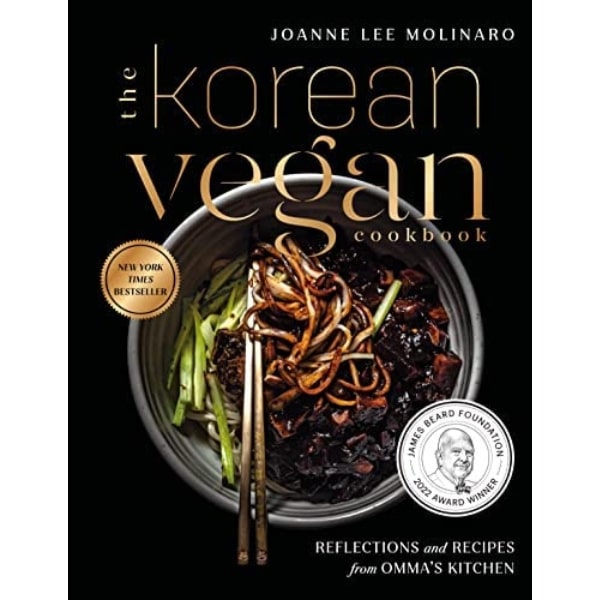
The Korean Vegan: Joanne Lee Molinaro
Joanne Lee Molinaro has captivated millions of fans with her powerfully moving personal tales of love, family, and food. In her debut cookbook, she shares a collection of her favorite Korean dishes, some traditional and some reimagined, as well as poignant narrative snapshots that have shaped her family history.
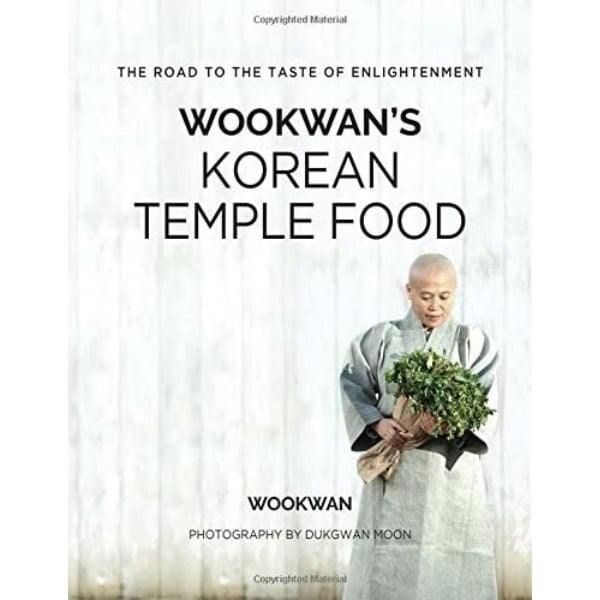
Wookwan’s Korean Temple Food
As the first volume of temple cuisine published in English, Wookwan herself has written an elegant volume that introduces the reader to Korean temple food, including what it means to care for the ingredients at each step of preparation, following the three key principles of cooking temple food, interspersed with her own accounts and tips among the recipes.
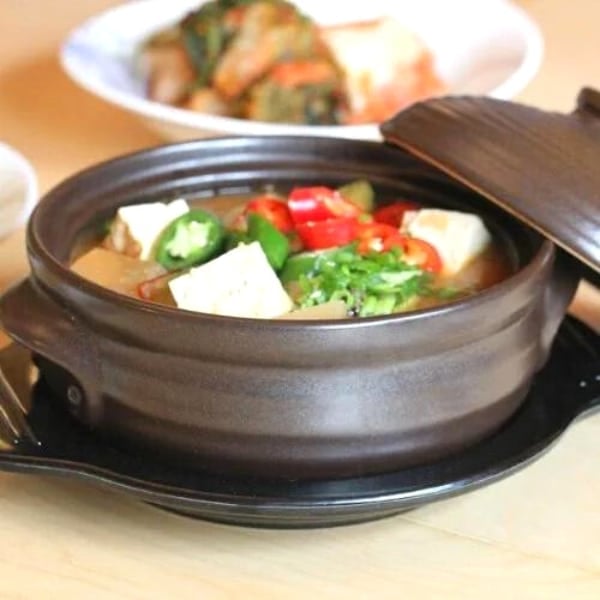
Korean Stone Bowl Cooking Pot
An essential part of many Korean winter dishes is the stone bowl ( dolsot ) cooking pot. This can be used to make dishes such as dolsot bibimbap, kimchi jjigae, and many other hot soups and stews.
Cookbooks not your thing? Check out the Baek Jong Won YouTube channel. He’s one of Korea’s most famous chefs and you can find his restaurants all over the place. He can teach you to make tteokbokki and many other tasty Korean winter foods.
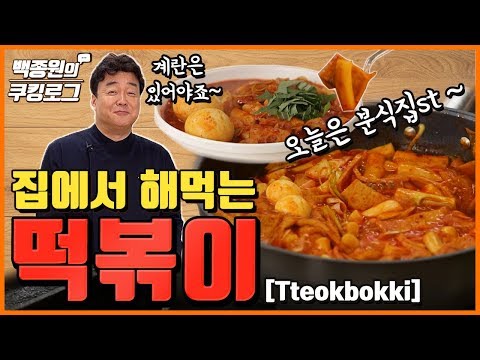
Tips For Enjoying These Real Korean Dishes

I’ve eaten out in Korea way too much, it’s hard not to. The food is cheap, delicious, and there is so much variety, a lot more than people realise before visiting Korea. I’ve put together a few tips to help you get even more out of your trip and the delicious Korean meals you’re going to enjoy.
1: Korean Food Is Cheap
Don’t be surprised by how much you get. However, food can get expensive, especially if you want to eat foreign foods. You’re in Korea and so I’d really recommend trying the local foods before looking for something more familiar.
2: Meals For Two
Some meals will be for two or more people and will be indicated on the menu with – 2인 (2 people in Korean). If you see this, then the price is for the whole meal, not per person. This is a big sharing meal and are often much better than individual meals – check them out!
3: Understanding Chinese Characters
Sharing meals (like those found in tip 2) usually come in 3 different sizes, which are represented by traditional Chinese characters. These are as follows:
- 小 ( so ) – small portion
- 中 ( jung ) – medium portion
- 大 ( dae ) – large portion
A small portion is enough for 2-3 people. Remember, the meal will usually come with side dishes, too. If you want to know more useful Korean, check out this article about phrases for eating-out in Korea .
4: Eat At The Markets
Korea’s traditional markets and street food stalls offer some of the most amazing traditional food and are often cheaper and fresher than in a restaurant. Be sure not to miss them when you visit Seoul and other cities as they are also a great place to pick up cheap souvenirs and interact with locals.
5: Indulge In Side Dishes
Traditional meals typically come with Korean side dishes , called banchan (반찬). These are included with the meal and if you ask for more, you can often get free refills. Don’t be surprised if you order a simple meal and end up with 10 or even 20 side dishes!
6: Wrap It Up
If your meal comes with a bowl of lettuce leaves (or cabbage), you’re probably meant to use it to wrap the other parts of the meal. Eating a Korean BBQ is a really fun experience and one of the times it’s ok to get your fingers dirty. Pick up some meat, garlic, kimchi, and whatever else you fancy, and wrap it inside the lettuce leaf and pop it into your mouth.
7: Stay Hydrated
Restaurants in Korea always give you free water (sometimes iced tea). This is a great way to get free liquids during the day. Make the most of it as Korea can be hot, especially in summertime. Also, Korean dishes tend to be quite salty, so staying hydrated is important.
8: Be Brave
There are some weird Korean dishes out there that might shock and scare you, but so much of Korea’s cuisine is mouthwateringly delicious (despite the look) that it would be a crime to miss them. Sure, some traditional Korean foods ( hongeo-hoe ) will leave a bad taste in your mouth, but try the rest!
As with many cultures, Korean meals often come with their own set of rules that you probably won’t be aware of before visiting in Korea. Read up on Korean etiquette rules to help you avoid cultural faux pas when you’re eating out, drinking, meeting people, and in other situations.
My Favourite Korean Traditional Meals
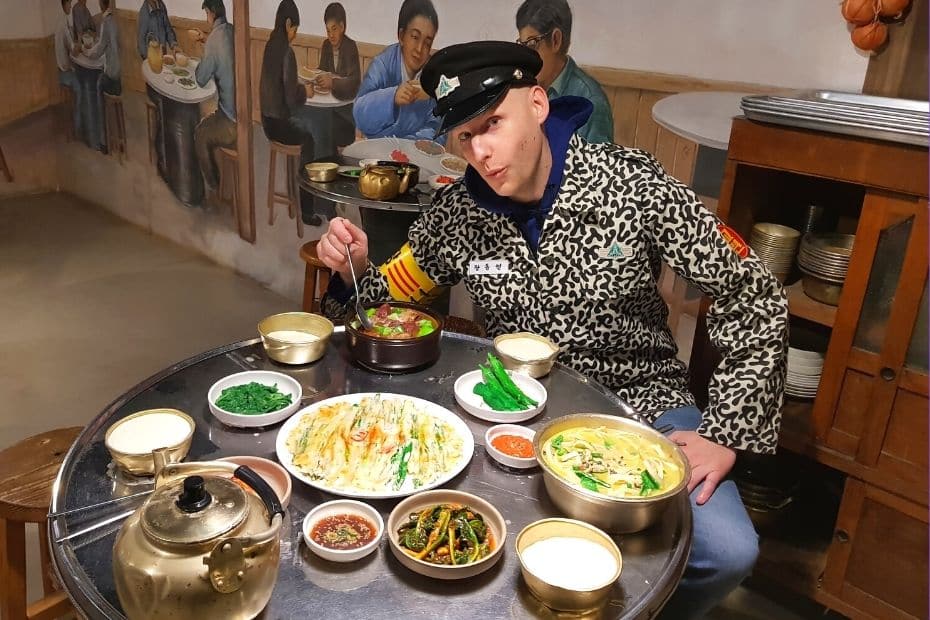
I’ve lived in Korea since 2015 and instantly fell in love with the food. There are so many unique culinary experiences – from the large group meals to the snack-able delights you can find in small street stalls or mountaintop shacks.
I’ve tried everything on this list and a lot more. So, what are my 3 favourite traditional dishes?
Well, I have to put samgyeopsal on the list – it’s a dish I enjoy regularly with friends. And one that I probably eat too much of for my own good!
Next up is my go-to lunch snack or can’t-be-bothered-to-cook-dinner meal – gimbap . This small, but filling, dish is great for lunch or dinner and you can eat it with dumplings, ramyeon , tteokbokki , and other foods.
Finally, a relatively plain dish compared to some of the others available, one that’s really just a bowl of noodles – kalguksu . I fell in love with this dish near my old workplace and eat it a lot during winter.
Kalguksu is really filling and perfect when it’s cold as the soup is hearty and warming. The noodles are thick and chewy and you can eat a big bowl of this without feeling too guilty as it’s not unhealthy.
How about you? What are your favourite traditional Korean dishes? Please let me know in the comments.
Support In My Korea Thanks for reading. If you want to help me to create more great content in the future, why not buy me a coffee? A strong coffee helps me write more and is a simple way to show gratitude for this free content.

Liked This? Pin It For Others
If you enjoyed reading this article, then please share this with your friends on Pinterest.
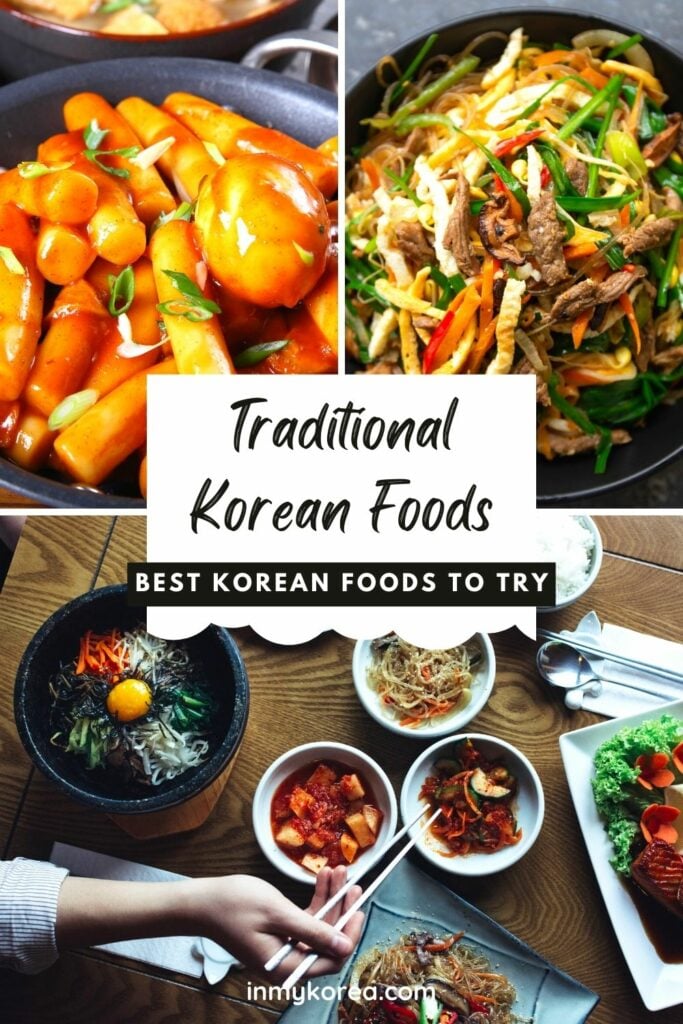
Related Articles
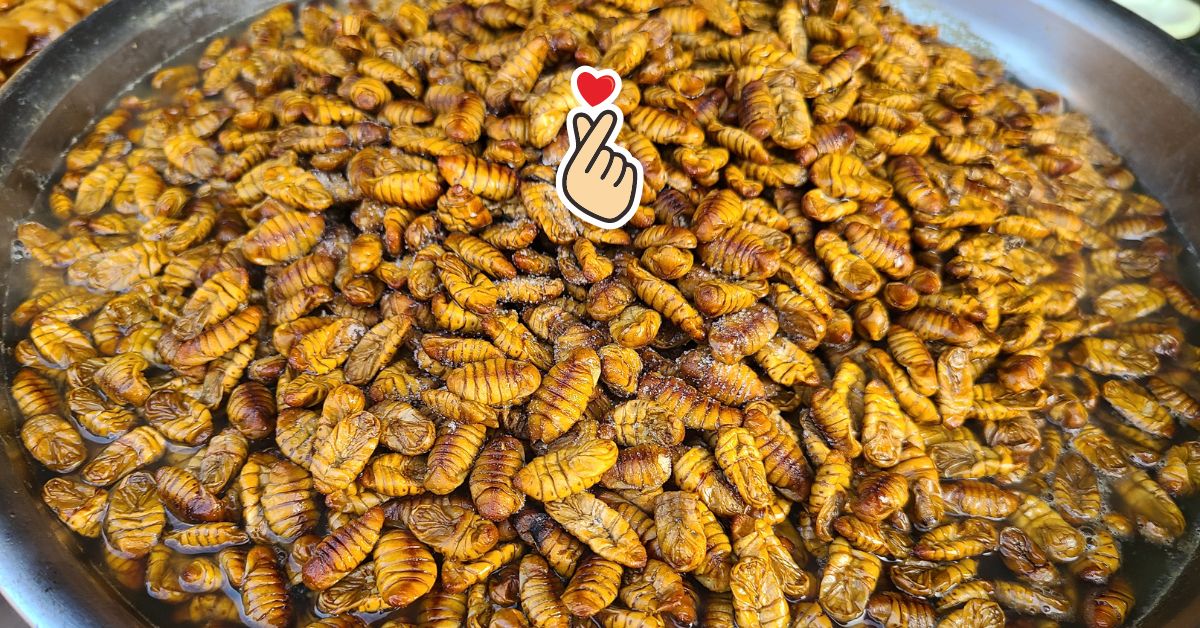
Weird Korean Foods: 15 Unique Korean Dishes You Might Love
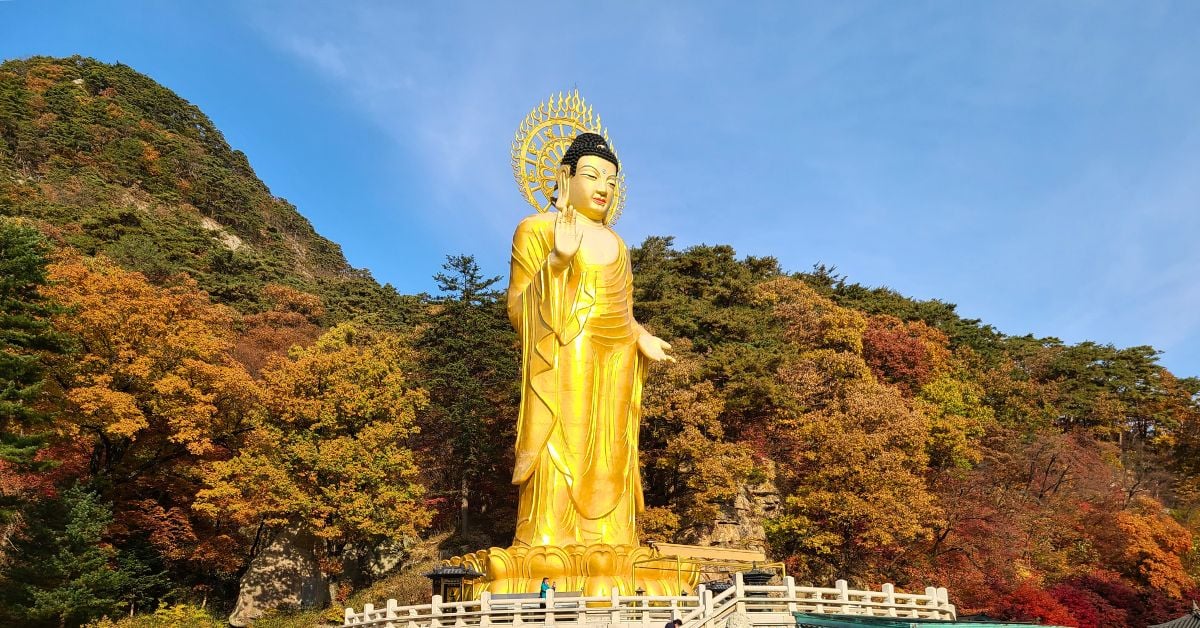
Korea In October 2024: Best Festivals, Events, And Sights
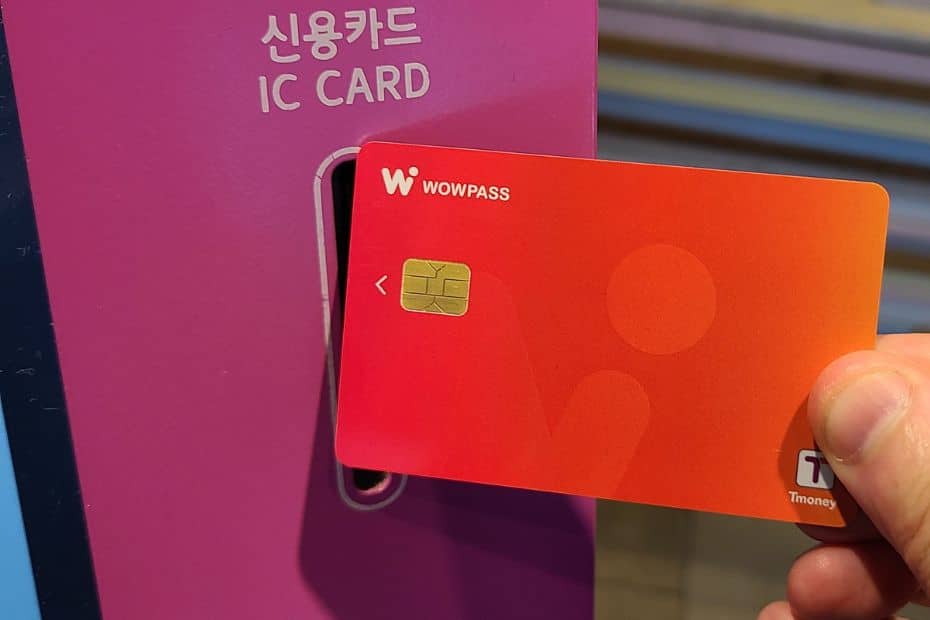
WOWPASS Korea Review: How To Use WOWPASS With T-Money 2024

Hi! My name is Joel, I'm the author of In My Korea and writer of this article. I've lived, worked and travelled in Korea since 2015 and want to share my insights, stories and tips to help you have the best experience during your trip to Korea.
I love learning more about Korean culture, hiking the many mountains, and visiting all the coolest places in Korea, both modern and traditional. If you want to know more about my story, check out the ' about me ' section to learn why I love living in Korea.
5 thoughts on “These 30 Traditional Korean Dishes Will Make You So Hungry!”
The Korean nutrition is absolutely scrumptious and I’m grateful for it!
I was stationed in the Army at Camp Humphreys from 1971-72 and like you, I love the Korean food! As you said, they don’t skimp on how much you get for your money and I can’t remember ever trying anything I didn’t like. Hopefully you will send me more recipes I can print off as I’m very much into cooking Korean food.
Thanks for reading, hope you could taste the food through the pictures if you can’t get the real thing where you are now. Definitely good value for the price, even these days. Thanks for the idea, I might try to find some recipes to add for this article so people can try them at home.
Your website is wonderful. I want to learn more about Korean Food etc. Please sign me up to receive emails from your company.
Hi Stephen, thank you for reading our post and kind words. Unfortunately we don’t currently have an email list, we’ll get to it soon, and will definitely add you when that is ready.
Leave a comment Cancel reply
Save my name, email, and website in this browser for the next time I comment.
TheKoreanGuide is a reader-supported site. Purchases made through links may earn a commission.
19 Famous Korean Foods in South Korea (Must Try)

Korean food is revered all over the world for the lasting impression it leaves on diners. And there is so much more to Korean cuisine than the quintessential Kimchi and Ramen .
For your trip to South Korea, we’ve compiled a list of 19 delicious must-try foods to give your tastebuds a treat. This includes gimbap, bulgogi, tteokbokki , japchae and many more.
In this article, we will guide you through the best of Korean cuisine that you can easily find on streets and in restaurants. Plus, we’ll let you know exactly what to expect when it comes to their flavors.
Here are the 19 famous Korean Foods you must try:
1) bibimbap / mixed rice with vegetables.
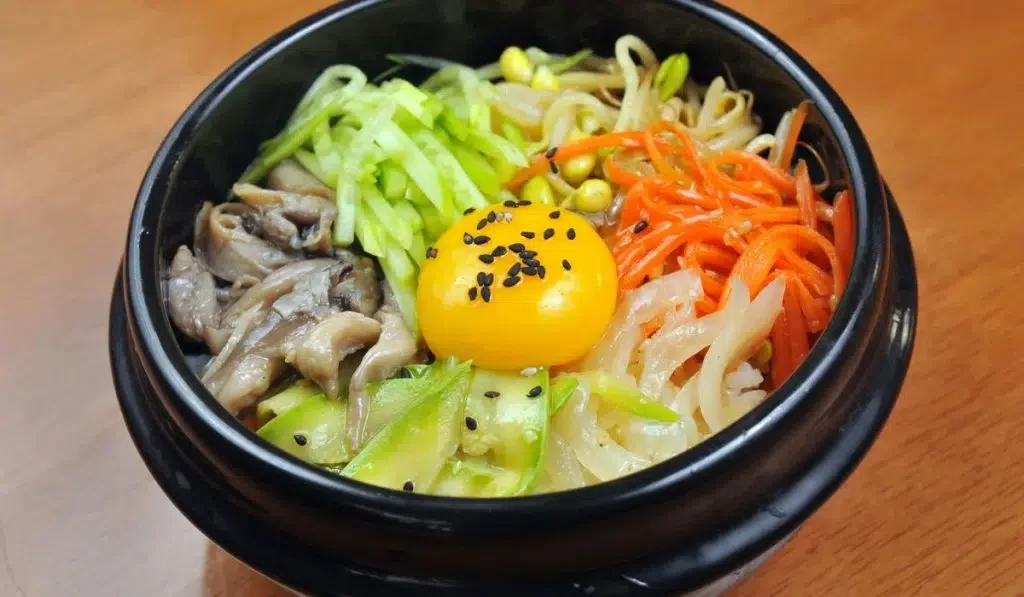
If you fancy a comforting food bowl, then Bibimbap will surely give you the ultimate satisfaction. This was originally a royal dish in the yesteryears which slowly made its way into Korean staple foods.
Bibimbap is a tasty mixture of rice, beef, vegetables tossed with gochujang (a hot red pepper paste) and soy sauce. Finally, it is topped with sesame seeds for some extra flavor.
Although chili paste is the most common seasoning used, people who prefer milder flavors usually opt for soy sauce instead.
2) Gimbap / Korean Seaweed Rice Rolls
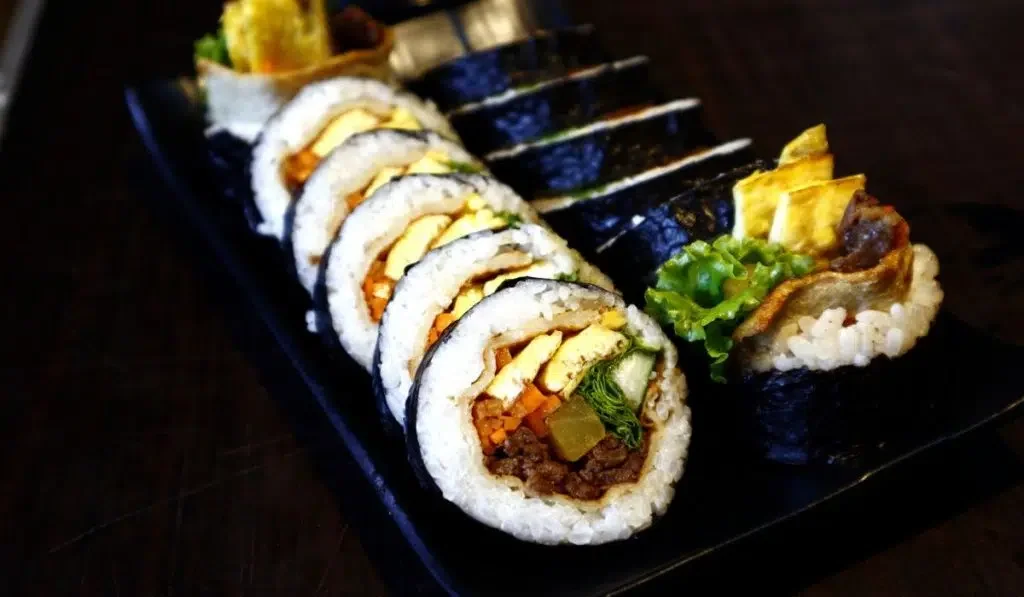
If you’re in South Korea , you really shouldn’t go back without giving gimbap a try. This nutritious and filling dish is easily available in street markets, food courts, as well as fine dining restaurants.
Essentially, gimbap is made from dried seaweed which is rolled up and filled with white rice and vegetables like carrots, spinach, radish, egg, and other seasonings. Then, it is cut into bite-sized pieces which make it a convenient meal for picnics or traveling.
The main filling of gimbap can vary. Tuna gimbap is another highly loved option, with a filling of mayonnaise, vegetables, canned tuna, and sesame leaves. You can also enjoy other variations with beef, kimchi, and cheese fillings.
3) Tteokbokki / Red Rice Cakes
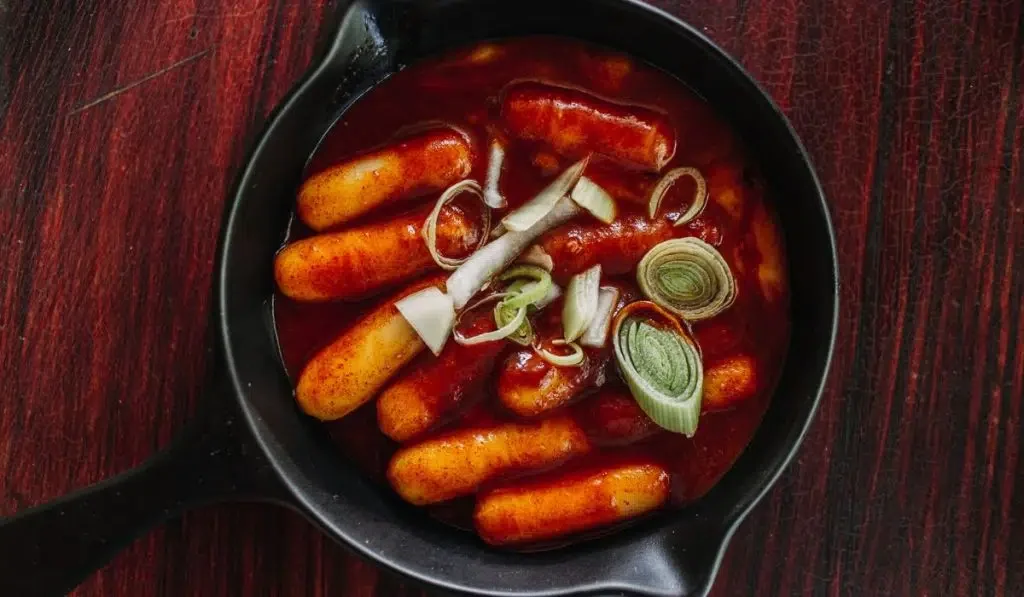
Anyone who knows about Korean culture has definitely heard about tteokbokki. This is a traditional street food that is highly treasured by Koreans for generations. It’s pretty easy to spot tteokbokki as it has a distinctly bright orange color.
Basically, tteokbokki is made from chewy, sweet rice and fish cakes . These slices of boiled rice cakes are combined with a special red chili and soybean paste. It is also tossed in onions, assorted vegetables, diced garlic, and other seasonings to elevate the flavor.
This scrumptious dish is an absolute must-try if you want to know more about Korean cuisine. You can easily find tteokbokki at street vendors and in many restaurants sprawled across South Korea.

4) Bulgogi / Marinated Beef Barbecue
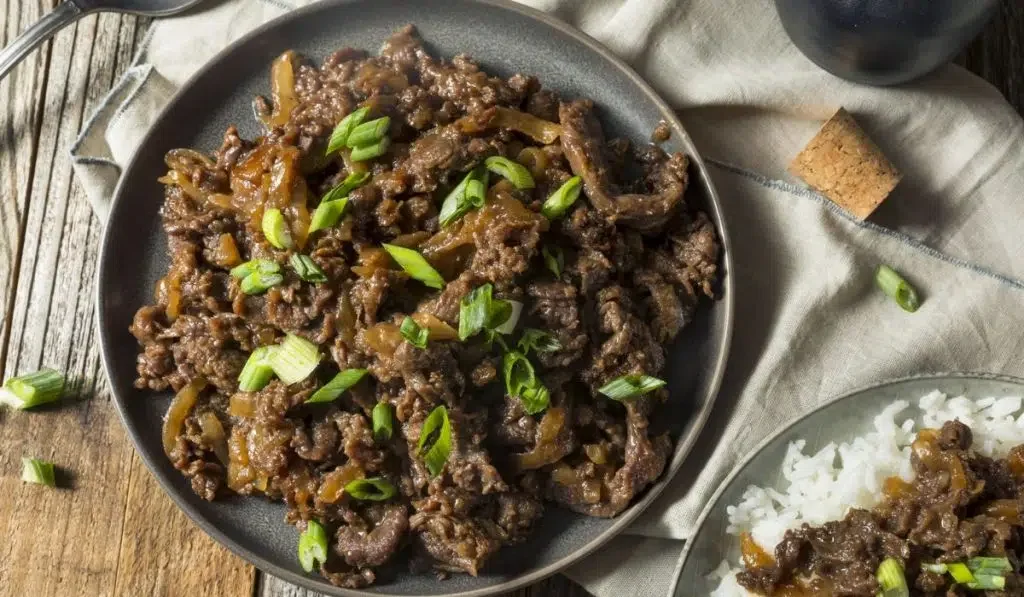
For meat lovers, bulgogi should be on top of their list of Korean foods to try. In fact, in 2011, CNN ranked bulgogi as the 23rd most delicious food in the world in its CNN Travel’s reader’s poll.
This savory and juicy dish consists of thinly sliced, grilled beef sirloin. It is cooked in soy sauce, black pepper, green peppers, onions, garlic, ginger, sugar, and sesame oil to make it tender and flavorful.
The dish is usually accompanied by a side of vegetables like spinach and lettuce. Koreans usually wrap up the sliced meat and spicy paste in the lettuce and then proceed to eat it.
5) Japchae / Stir-Fried Glass Noodles
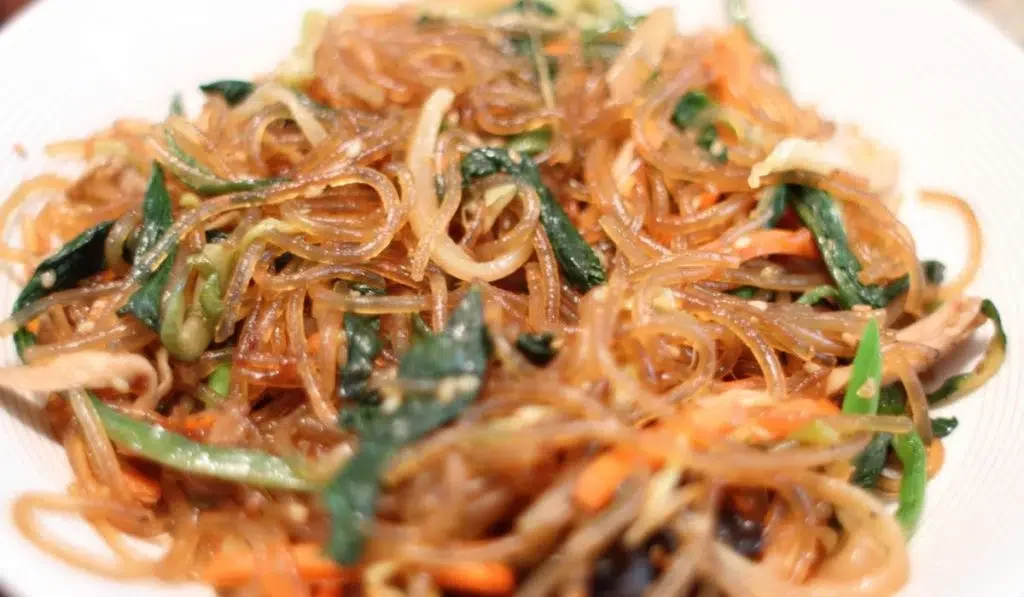
The famous glass noodles are another must-try for anyone visiting Korea . This is arguably one of the most popular noodle dishes in the country.
These glass noodles are typically made from sweet potatoes. Then, the noodles are stirred in sesame oil, mushrooms, assorted vegetables, and beef.
The best way to enjoy japchae is to use a spoon together with metal chopsticks while slurping the juicy noodles. In Korea, it’s not considered polite to keep the bowl too close to your mouth while eating.
6) Kimchi / Spicy Fermented Vegetables
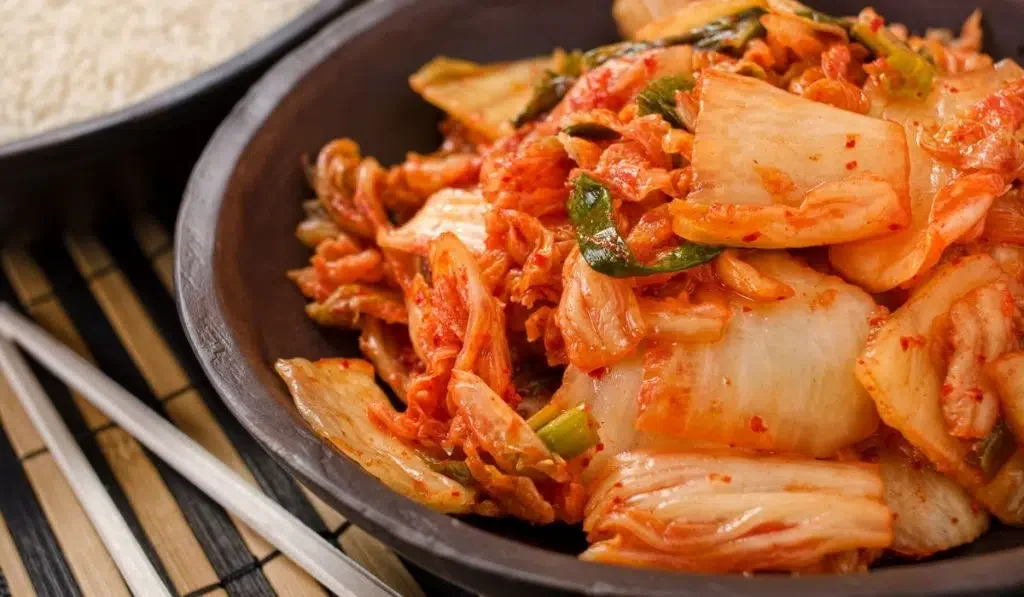
Kimchi is one term almost everyone has heard when Korean food is mentioned.
It is basically a crunchy salad made with assorted, fermented vegetables. Cabbage is the base ingredient of this salad but it is packed with flavor as a spicy paste, crushed garlic, and minced ginger are also added.
The best part is that kimchi is also quite healthy. It has a high amount of fiber and is low on calories. This side dish is an important part of most Korean dining experiences.
7) Jajangmyeon

A fusion of Korean and Chinese cuisine, jajangmyeon is made from thick, wheat noodles that are handmade. The noodles are then topped with savory black soybean paste, cucumber slices, and assorted veggies. Diced pork is also an important addition to this comforting dish.
Jajangmyeon is a hearty noodle dish and most Koreans absolutely love it. It is also very affordable with a starting price of 5,000 won. If you’re looking for a quick, budget-friendly meal, you can count on jajangmyeon anytime.
8) Ramyun / Korean Instant Noodles

Ramyun is a hugely popular instant noodle that has made waves not just in Korea, but all across the globe. With economical prices, a variety of flavors, and an amazing texture, this is one of the best dishes in Korean cuisine.
Korean instant noodles are becoming increasingly popular everywhere. They are usually enjoyed with lots of broth, a fried egg, and cheddar cheese on top.
9) Korean Fried Chicken
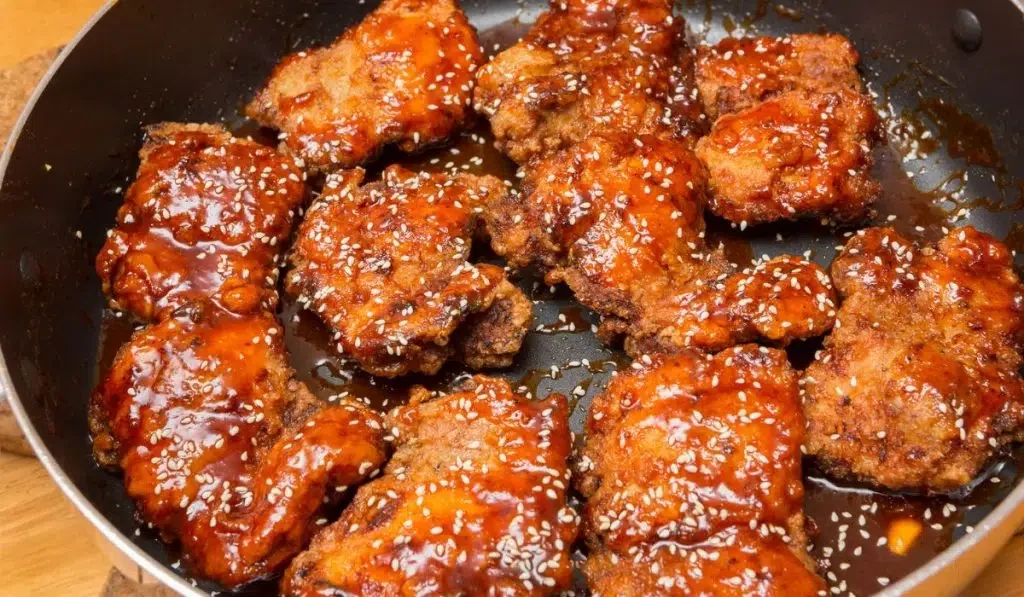
If you want to try out American fast food with its own twist, Korean fried chicken is the dish for you.
The chicken is coated all over with a sweet, spicy sauce and sometimes green pepper is added to the batter too. Then, it is double fried to give it a crunchy bite which makes it absolutely delicious. The meat of Korean fried chicken is as juicy and succulent as it gets.
This is one snack that will have you licking your fingers. It is typically enjoyed with beer and you can easily find places serving this popular combination in South Korea.
10) Nakji Bokkeum / Korean Spicy Stir-fried Octopus
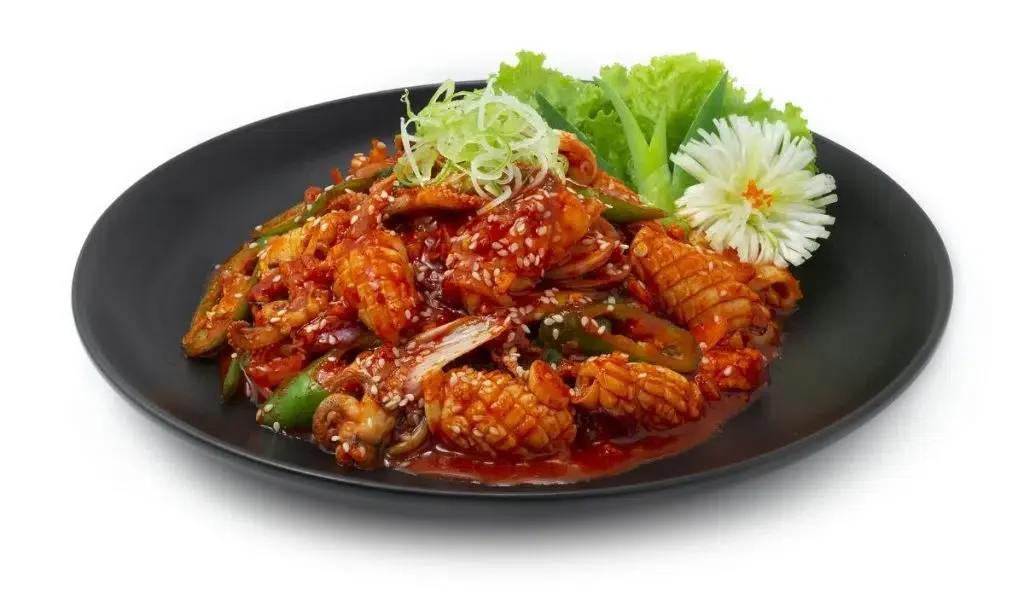
Back in the 19th century, Koreans loved eating raw or fried squid. During this era, Najki Bokkeum was also born.
Squid lovers would surely enjoy this delicious dish made with stir-fried octopus bathed in a delectable caramel sauce. Nakji Bokkeum oozes flavor and leaves you wanting more.
Ideally, the squid should be soft yet chewy and balanced with assorted vegetables. It is often served spicy as chefs season it with chili pepper, powder, and paste to create an explosion of flavors. If you don’t like very spicy foods, you can have it with boiled bean sprouts to reduce the heat.
It is most commonly eaten with rice which is served separately as a side. Some restaurants will also cook the nakji bokkeum in front of you on the table.
11) Hotteok / Korean Sweet Pancakes
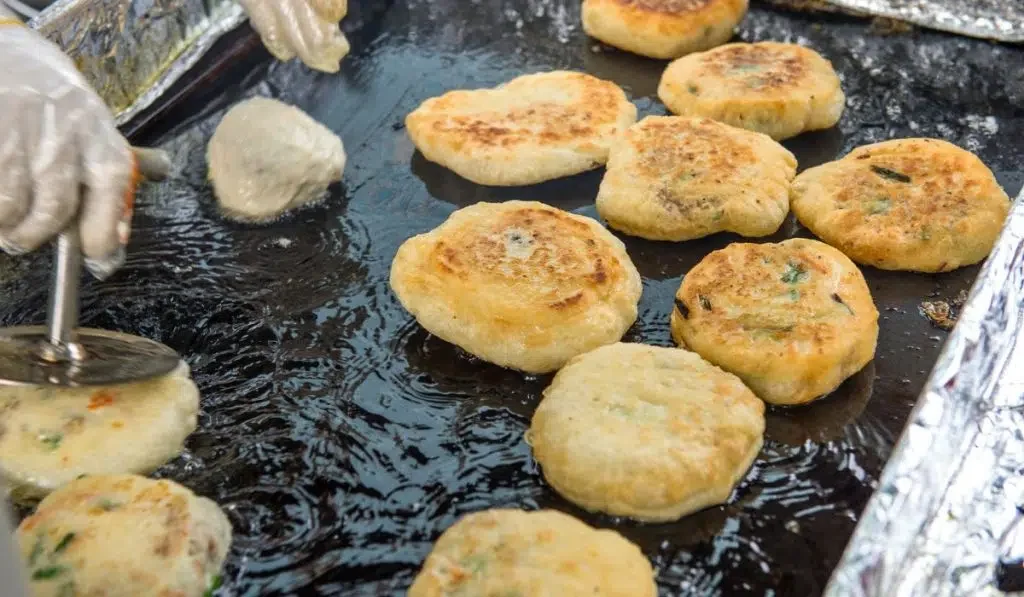
Almost everyone knows how yummy pancakes are. But what about the Korean version of sweet pancakes known as hotteok? This is a popular street snack in the country and is widely available everywhere.
The batter is made using flour, and then the pancakes are filled with mouthwatering syrup. This syrup is usually made with brown sugar, cinnamon, and peanuts.
Right off the grill, the pancake is typically folded in a cardboard or paper cup. It is served super hot and fresh, so be careful before you take a bite of this syrup-filled sugary goodness. Plus, the softness of the fluffy pancake is on another level.
We recommend you to have hotteok with a warm cup of milk, especially in the chilly Korean weather.
12) Soondae / Korean Sausage
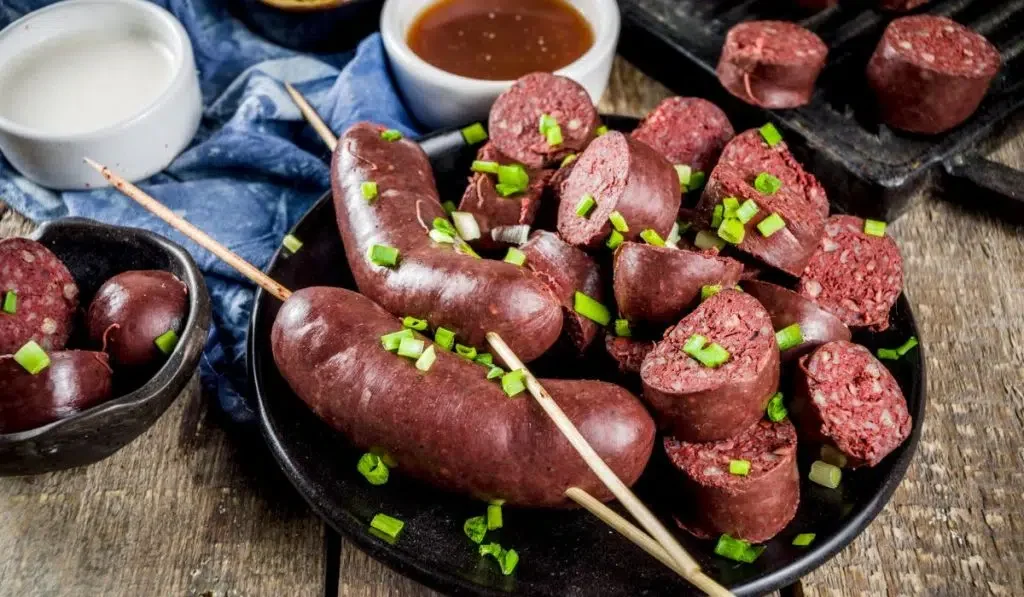
Soondae is also worth a try for tourists who are looking for meaty food options. Basically, this is made from pig intestines that are stuffed with pig’s blood, vegetables, and dangmyeon (clear noodles).
You can enjoy soondae with a variety of dipping sauces. The usual sauce mostly varies from region to region.
For instance, it is mostly served with salt in Seoul, Gyeonggi. If you’re in Busan or Ulsan, you will probably get ssamjang sauce to go with it. In Jeolla and Chungcheong, it is usually enjoyed with shrimp sauce and chojang sauce.
13) Odeng / Fish Cake
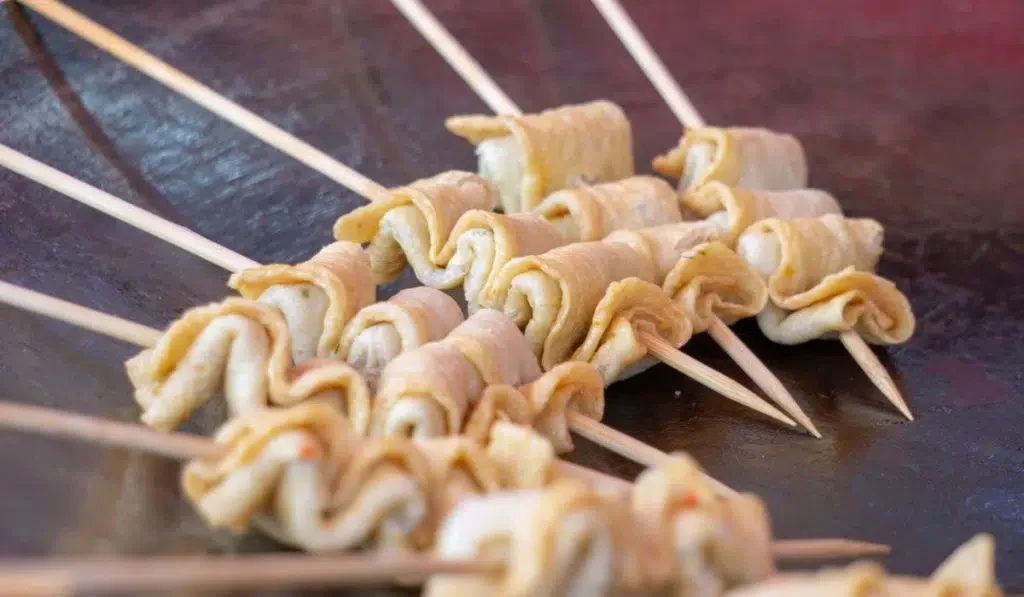
This famous fish cake, known as Odeng, was actually named after Japanese Oden stew. This dish came into being during 1910 to 1945 when Japan took over Korea. So, a number of Korean dishes were inspired by Japanese cuisine during this period.
If you’re on the hunt for delicious street food, Odeng is one of the snacks you should try without hesitating. It is a unique taste and experience for many tourists and is usually appreciated by them.
The fish cake should ideally be tender and chewy, and it becomes even better when drenched in a zingy broth. You can either dip the fish cake in the broth before taking a bite or take a sip of the broth later. Either way, it’s a combination you will never forget.
14) Seolleongtang / Ox Bone Soup
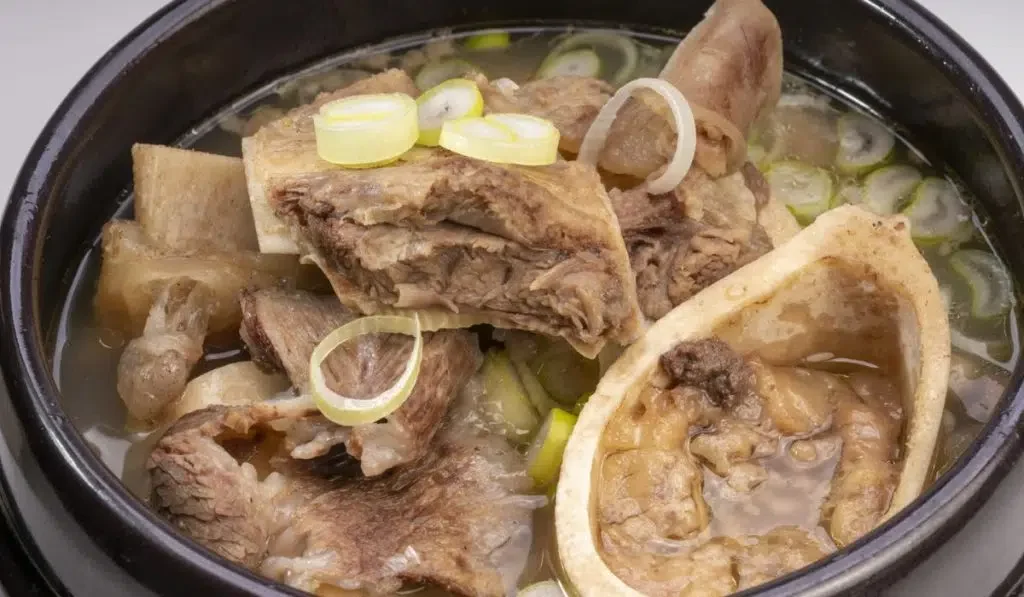
Ox bone soup or Seolleongtang is a household favorite in South Korea. It is especially popular in the winters and is highly adored as comfort food.
The beef bones and ox bones are boiled for hours to whip up this tasty soup. Then, it is seasoned with scallions, garlic, salt, and pepper. The soup is not only immensely flavorful, but it is also rich in proteins.
If you’re looking for a healthy snack during the winter season in Korea, make sure not to miss out on Seolleongtang.
15) Bibim Nengmyun / Spicy Cold Noodle
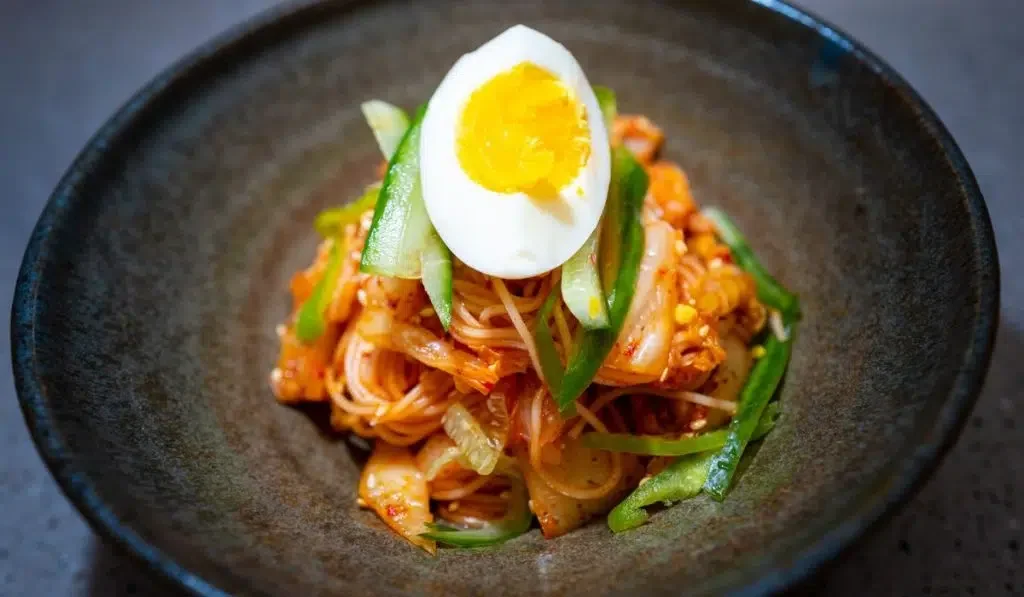
You probably know by now that Koreans really love noodles. And there are endless variations of noodles in the country.
Well, bibim nengmyun is a noodle dish served in a cold broth. It is also seasoned with cucumbers, boiled egg, pear slices, and cold slices of boiled beef. The noodles can be made from different ingredients like flour, buckwheat, sweet potatoes, seaweed or even green tea.
These spicy cold noodles are known for being super healthy. Traditionally, they are served without cutting, but you can always ask the diner to cut them for you first.
16) Ganjang Gejang / Raw Crabs Marinated in Soy Sauce
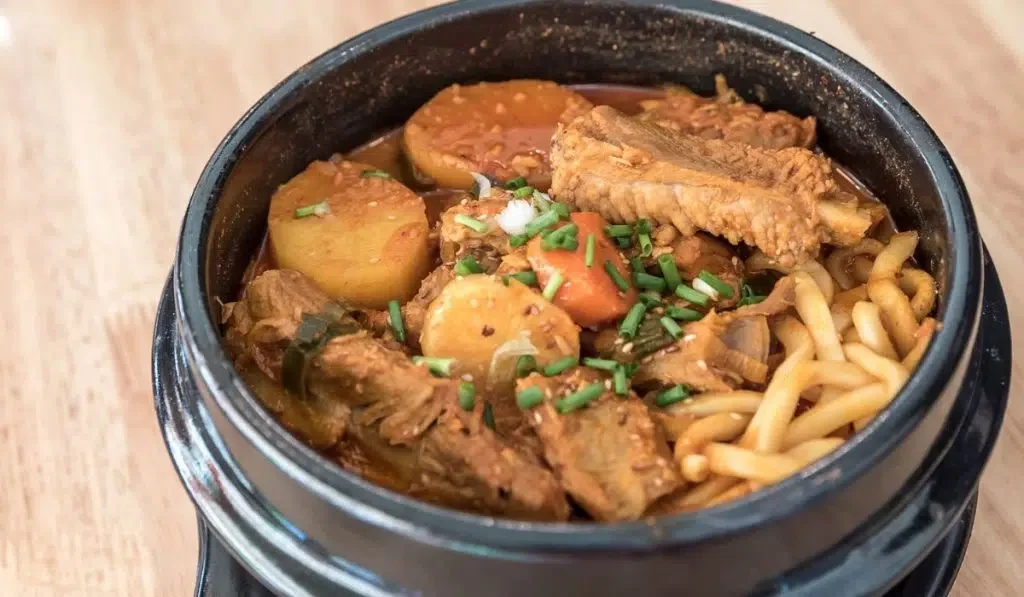
Crabs are a delight to eat for anyone who is fond of seafood. Ganjang gejang, also known as ‘bap-dodook’ is essentially raw crab covered in soy sauce.
Many people are hesitant while trying out this dish but it is a highly loved part of Korean cuisine.
17) Pajeon / Savory Pancake
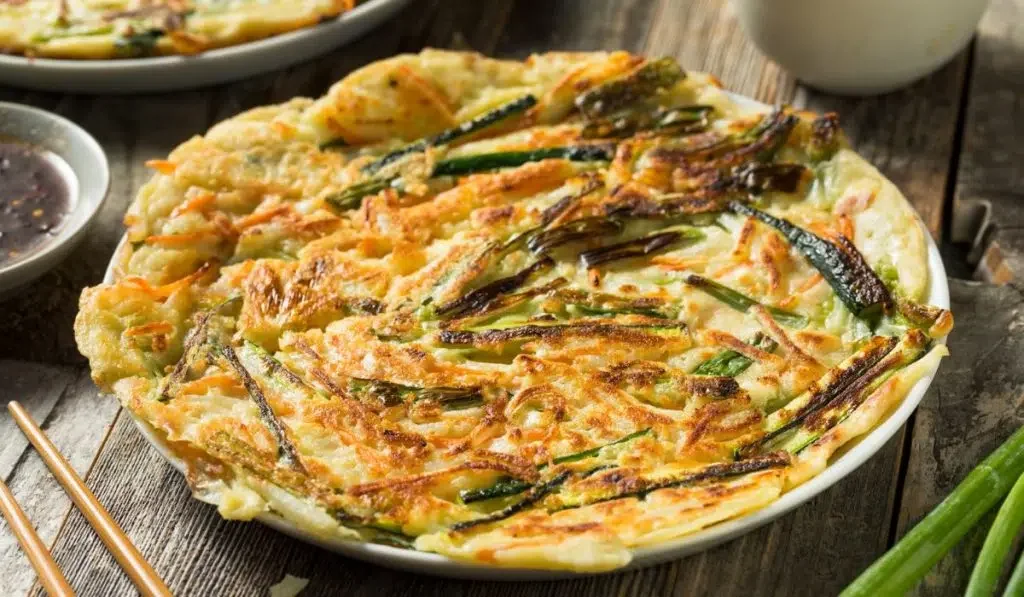
This addictive and famous pancake variation is a must-try in Korea. With a soft, delicious cake base, a combination of green onions and carrots, and a mouth-watering dipping sauce- there’s so much to love about pajeon.
The divine sauce is typically made from garlic, soy sauce, and honey. It really takes the flavor of the pancake up a notch and makes it irresistible.
Here’s a fun fact: The name Dongnae Pajeon was actually inspired by the Dongnaesung fortress from the Joseon Dynasty.
18) Sundubu Jjigae / Korean Spicy Soft Tofu Stew
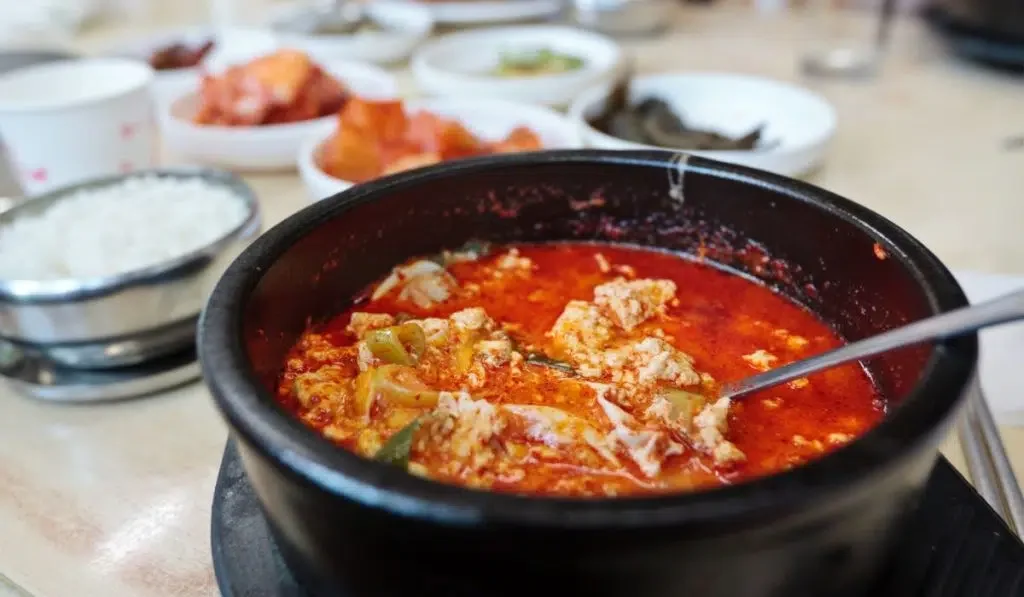
Tofu is another important part of Korean food culture. Sundubu jjigae is a form of unpressed, uncurdled tofu stew that is a huge favorite among the masses.
The classic version of this dish is made from plain tofu bathed in a broth and is called Chodang tofu. Sundubu jjigae is made in a richer, spicier broth with seasonings of red pepper powder and oil.
19) Gamjatang / Pork Back-Bone Soup
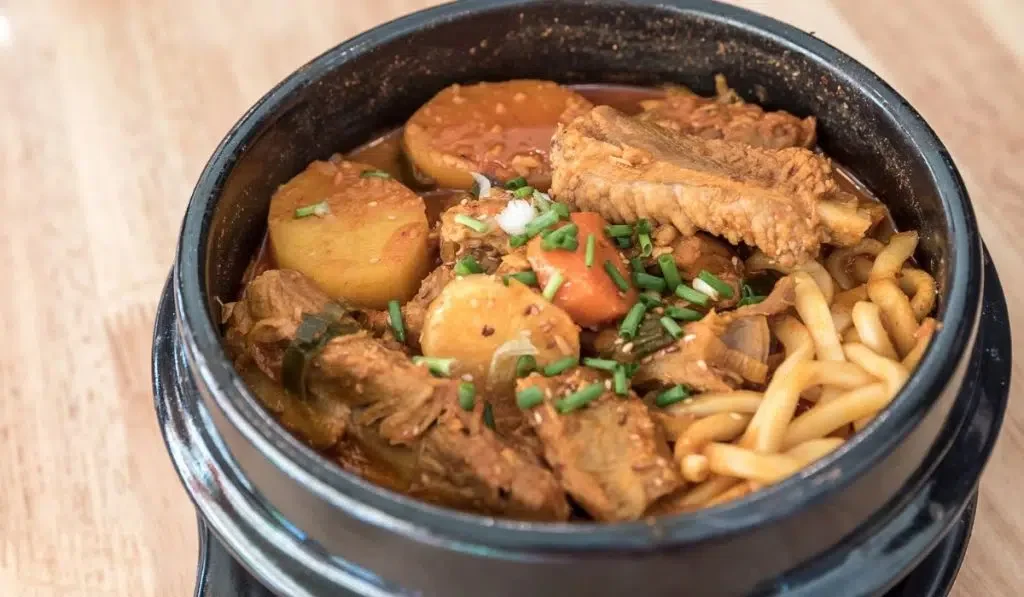
Made from pork backbone, Gamjatang is another fascinating soup dish in Korea. It is usually mixed with boiled potatoes and other vegetables, as well as perilla seeds.
So, what makes this dish so popular? It is known to cure a hangover immediately. So, places that serve gamjatang are usually open for 24 hours. You now know what you need after a night of heavy partying in South Korea.
Final Thoughts
If you’re on a food adventure, Korean food will surely take you on a ride. However, you should know it’s an acquired taste, so not everyone is able to appreciate it.
We recommend you to try all the delicious Korean dishes on this list if you can. The strong flavors and interesting textures of this cuisine offer an experience of its own kind.
Enjoy the article?
You'll love my daily email! Learn something new about South Korea every single day. It's completely free. <3
About The Author
You May Also Like

10 Best Korean Toners for Dry Skin (2024 Updated)

The 8 Best Korean Essences for Dry Skin (2024 Updated)

24 Best Korean Skincare Brands of All-Time

Is Korean Skincare Cheaper in Korea?

How Long Does It Take for Korean Skincare to Work?

Is Korean Skincare Similar to Japanese?

© 2024 TheKoreanGuide.com | As an Amazon Associate, I earn from qualifying purchases.
Home — Essay Samples — Nursing & Health — National Cuisine — Korean food culture
Korean Food Culture
- Categories: Korean National Cuisine Nutrition
About this sample

Words: 1818 |
10 min read
Published: Mar 14, 2019
Words: 1818 | Pages: 4 | 10 min read

Cite this Essay
Let us write you an essay from scratch
- 450+ experts on 30 subjects ready to help
- Custom essay delivered in as few as 3 hours
Get high-quality help

Verified writer
- Expert in: Sociology Nursing & Health

+ 120 experts online
By clicking “Check Writers’ Offers”, you agree to our terms of service and privacy policy . We’ll occasionally send you promo and account related email
No need to pay just yet!
Related Essays
1 pages / 552 words
2 pages / 1118 words
3 pages / 1444 words
4 pages / 3148 words
Remember! This is just a sample.
You can get your custom paper by one of our expert writers.
121 writers online

Still can’t find what you need?
Browse our vast selection of original essay samples, each expertly formatted and styled
Related Essays on National Cuisine
Food and culture share an intimate and intricate relationship, weaving together the flavors, traditions, and stories that define societies across the globe. This essay embarks on a journey to explore the profound connection [...]
Food is a universal language that unites cultures and brings people together. However, not all foods are created equal, and some dishes are subject to misconceptions and misunderstandings. One such dish is mofongo, a traditional [...]
Floribbean cuisine, also known as “new era cuisine”, has emerged as one of America’s new and most innovative regional cooking styles. Floribbean cuisine is representative of the variety and quality of foods indigenous to Florida [...]
With the White Australia policy firmly in the past, new Asian food choices have emerged on the restaurant scene. Immigrants from East and Southeast Asia have formed a major demographic in Australia for more than one hundred [...]
Sights, sounds, smells and most importantly taste. Jaipur city is a treat to the senses, from its palatial buildings to its old markets. Jaipur is a stage where a quaint desert culture is fusing rapidly with a metro lifestyle. [...]
Palatability refers to observations of a food’s taste, smell, and texture. It is an important food trait because, pets must be eager to eat acceptable quantities of the food to satisfy their daily calorie and nutrient needs. [...]
Related Topics
By clicking “Send”, you agree to our Terms of service and Privacy statement . We will occasionally send you account related emails.
Where do you want us to send this sample?
By clicking “Continue”, you agree to our terms of service and privacy policy.
Be careful. This essay is not unique
This essay was donated by a student and is likely to have been used and submitted before
Download this Sample
Free samples may contain mistakes and not unique parts
Sorry, we could not paraphrase this essay. Our professional writers can rewrite it and get you a unique paper.
Please check your inbox.
We can write you a custom essay that will follow your exact instructions and meet the deadlines. Let's fix your grades together!
Get Your Personalized Essay in 3 Hours or Less!
We use cookies to personalyze your web-site experience. By continuing we’ll assume you board with our cookie policy .
- Instructions Followed To The Letter
- Deadlines Met At Every Stage
- Unique And Plagiarism Free
Food in Korean Culture: Describing Korean Cuisine
In Korea, food remains a unique attribute of the people’s culture. Korean citizens believe that food has medicinal properties that improve a person’s emotional, psychological, and mental well-being. Korean traditional food includes fermented cabbage, commonly known as kimchi, and soybean paste or doenjang. Korean chili, widely called chili paste, forms an important part of people’s diet. A wide range of vegetables, chili sauces, meat, and sea-foods are evident in Korean cuisine. Most people in this culture do not consume dairy products (Jeon 268). This analysis indicates that traditional Korean soup delivers unique health benefits. Meals are prepared and named as side dishes accompanying kimchi since it is the country’s staple food. At the same time, Korean households might waste a significant amount of food (Islam 410). A detailed examination of food in this culture becomes the best starting point for learning more about the people’s values.
Cultural Aspects Learned
From this exercise, I have learned several aspects about the Korean people and their culture. First, the study has revealed that Koreans identify food as the primary source of favorable health outcomes. The cuisine helps them improve their mental, physical, and psychological abilities, thereby contributing to numerous benefits. Second, food helps most people to practice and share their experiences, values, and traditions (Jeon 270). They usually come together to celebrate and show unity by promoting their cuisine. Such practices have allowed Koreans to develop a unique culture that guides and encourages them to continue pursuing their health and traditional goals.
Third, Koreans add different spices and components to season their foods. Some of the identified ones include garlic, tofu, and plant-based ingredients. This practice makes Korean cuisine healthy and capable of delivering numerous bodily benefits. Five, rice forms the staple source of food in the country’s diet (Jeon 272). The most exciting aspect of this analysis is that the people of Korea have a cuisine that differs from my culture. Specifically, grains, animal products, and potatoes are part of our diet. At the same time, we do not have kimchi or doenjang as these products are not part of our culture. I think it can result from the differences in mentalities and how countries evolved. Moreover, we do not consume much rice and tofu, while for Koreans, these are the major products in their diets. In such a way, Korean food differs from ours because of their culture and peculiarities of historical development. Traditional dishes of my culture are made of other products, and I believe they can be less healthy than Korean ones.
Personal Reflection
From a personal perspective, I strongly believe that Korean cuisine presents an opportunity to learn more about the aspects associated with Asian food culture. The completed exercise has been informative because it has widened my understanding of Koreans. As their cuisine appears to deliver numerous health benefits, I can borrow such a practice to reduce my consumption of junk food (Saxena et al. 271). This observation explains why I am ready to start focusing on foods that have medicinal or healing properties. More people could embrace such a practice since it will guide them to develop healthy bodies. They will be empowered to manage a wide range of conditions, such as obesity and stroke.
I believe that members of different communities can borrow numerous insights from the Koreans and the manner in which they relate to food. From the analysis, I have observed that various ceremonies and festivals are essential to the people of Korea. Consequently, citizens can embrace these initiatives if they want to realize their cultural goals. Based on the acquired ideas, people should begin to plan their diets in accordance with their cultural attributes. In conclusion, the studied notions revolving around cuisine can guide more individuals across the globe to take the issue of food seriously if they are to lead healthy lives.
Works Cited
Islam, Maidul. “Are Students Really Cautious about Food Waste? Korean Students’ Perception and Understanding of Food Waste.” Foods, vol. 9, no. 4, 2020, pp. 410-419.
Jeon, Do Hyun. “A Study on the Relationship between the Korean Wave, Preference and Recognition of Korean Cuisine among Chinese.” Journal of the Korean Society of Food Culture, vol. 34, no. 3, 2019, pp. 268-276.
Saxena, Priyanka, et al. “Food Security, Fruit and Vegetable Intake, and Chronic Conditions among Supplemental Nutrition Assistance Program Education Participants Attending Free Food and Produce Events.” Obesities, vol. 2, no. 3, 2022, pp. 264-275.
Cite this paper
- Chicago (N-B)
- Chicago (A-D)
StudyCorgi. (2023, August 15). Food in Korean Culture: Describing Korean Cuisine. https://studycorgi.com/food-in-korean-culture-describing-korean-cuisine/
"Food in Korean Culture: Describing Korean Cuisine." StudyCorgi , 15 Aug. 2023, studycorgi.com/food-in-korean-culture-describing-korean-cuisine/.
StudyCorgi . (2023) 'Food in Korean Culture: Describing Korean Cuisine'. 15 August.
1. StudyCorgi . "Food in Korean Culture: Describing Korean Cuisine." August 15, 2023. https://studycorgi.com/food-in-korean-culture-describing-korean-cuisine/.
Bibliography
StudyCorgi . "Food in Korean Culture: Describing Korean Cuisine." August 15, 2023. https://studycorgi.com/food-in-korean-culture-describing-korean-cuisine/.
StudyCorgi . 2023. "Food in Korean Culture: Describing Korean Cuisine." August 15, 2023. https://studycorgi.com/food-in-korean-culture-describing-korean-cuisine/.
This paper, “Food in Korean Culture: Describing Korean Cuisine”, was written and voluntary submitted to our free essay database by a straight-A student. Please ensure you properly reference the paper if you're using it to write your assignment.
Before publication, the StudyCorgi editorial team proofread and checked the paper to make sure it meets the highest standards in terms of grammar, punctuation, style, fact accuracy, copyright issues, and inclusive language. Last updated: August 15, 2023 .
If you are the author of this paper and no longer wish to have it published on StudyCorgi, request the removal . Please use the “ Donate your paper ” form to submit an essay.
South Korean and Japanese Cuisines and Identity Essay
- To find inspiration for your paper and overcome writer’s block
- As a source of information (ensure proper referencing)
- As a template for you assignment
Korean Identity
Contemporary japan, globalizing world.
Bibliography
There is a famous quote saying that you are what you eat. Of course, it should not be understood literary, as our food cravings do not predicate our biological nature. The line rather describes the combination of values one is likely to carry, which can be evaluated according to their food preferences. Most countries have their distinct cuisine that was forming during many centuries. Food is not only the source of human nutrition processes, but it is also one of the brightest cultural examples. In such a way, one can predict certain traits or values of other people based on their food choices.
East Asia is one of the world’s regions that has a very distinct cuisine. People from this area associate themselves with their nationality, which includes food preferences. Japanese, Chinese, and other Asian restaurants are spread worldwide, and their kitchen cannot be confused with that of others. This paper reviews examples of South Korean and Japanese food that served as markers of national identity in the past. Yet, they are losing this determining role due to political shifts and the process of globalization.
Modern Korean land is divided into two halves, representing a separate country with an opposite economic structure. However, the food culture remains similar due to Korea’s long history as a single state, which experienced its internal cultural development and foreign influence. Nowadays, most research on this country is done regarding South Korea since its northern neighbor is not open to the world.
Colonial Past
In the past, Korea used to be one of the Japanese colonies. Although the two cultures had similar culinary products, many of them had differences in ingredients and making. For instance, soy sauce is a product that is currently viewed as traditional in East Asia, yet not many people are aware that the modern recipe is Japanese. Korean households used to brew their soy sauce, which was later replaced by the Japanese version 1 . This happened because Korean culture was not viewed as superior, and local citizens attempted to look better in the eyes of their rulers. Food as a part of this culture also had to correspond with Japanese civilization’s high standards. This is a bright example of associating food with identity, as Koreans wished to become closer to the superior nation by changing their food habits. Nowadays, another trend adds to the local soy sauce phenomena, as it is produced industrially instead of homemade. Koreans identify themselves as busy people who have no time to cook difficult recipes, which is the same for the rest of the modern world.
Modern Aspirations
As the country became independent and economically strong, Koreans received a need to promote their national pride. It is now normal to be proud of Korean culture and food in particular. Thus, the recent case of the first Korean astronaut created a precedent for developing a special recipe of kimchi, a national food, that could be taken to space 2 . Journalists compared this event with the tradition when mothers gave kimchi to their sons who left home. This is an example of how modern Koreans identify themselves through their national food, saying that they are more than proud to be a part of this culture, which has to be taken to outer space to sign their identity.
Unlike Korea, Japan did not experience the same foreign influence, except for the times in the XX century, when it had to assimilate to become an equal partner in the world’s economy and trade. Nowadays, Japanese culture is regarded as one of the most famous, yet still difficult for a foreigner’s understanding. For instance, the Japanese see raw food as the one ready for consumption, which has much to do with their perception of nature and its resources 3 . The philosophy of harmony with nature and oneself is one of the key principles of Japanese culture, which is achieved to keep past values.
Nowadays, boundaries between countries dissolve due to the economic processes, making different cultures blend. Japanese and Korean food are widely represented in the West, giving people from other cultures an opportunity to admire it from childhood. This trend makes the saying about food being a part of the identity to lose its positions. Although I acknowledge that this was the case in the past, modern reality demonstrates that Koreans can consume a lot of American food, and vice versa.
While food remained one of the national identity elements in the past, it was subject to changes for political or economic reasons. Nowadays, independent countries find pride in their food as a traditional element. However, the process of globalization threatens to exclude national cuisine as an identity feature.
Bestor, Theodore C. “Cuisine and Identity in Contemporary Japan.” In Routledge Handbook of Japanese Culture and Society , edited by Victoria Lyon Bestor, Theodore C. Bestor, and Akiko Yamagata, 273-285. Oxon: Routledge, 2011.
Cwiertka, Katarzyna J. “The Soy Sauce Industry in Korea: Scrutinizing the Legacy of Japanese Colonialism.” Asian Studies Review 30 (2006): 389-410.
Sang-Hun, Choe. “Kimchi Goes to Space, Along with First Korean Astronaut.” The New York Times , February 22, 2008.
- Katarzyna J. Cwiertka “The Soy Sauce Industry in Korea: Scrutinizing the Legacy of Japanese Colonialism.” Asian Studies Review 30 (2006): 390.
- Choe Sang-Hun, “Kimchi Goes to Space, Along with First Korean Astronaut.” The New York Times , February 22, 2008, para 2.
- Theodore C. Bestor, “Cuisine and Identity in Contemporary Japan.” In Routledge Handbook of Japanese Culture and Society , ed. Victoria Lyon Bestor, Theodore C. Bestor, and Akiko Yamagata (Oxon: Routledge, 2011), 275.
- Soybean and Deforestation in the United States
- Bolognese Sauce and Italian Gastronomic Tradition
- Recipe for Alice: Stir-Fried Pasta
- Food Nexus Models in Abu Dhabi
- Family Food and Meals Traditions in Dubai History
- Filipino Food Essay
- The Science of Why You Crave Comfort Food
- Kitchen and Cooking in Kalymnos People
- Chicago (A-D)
- Chicago (N-B)
IvyPanda. (2020, November 5). South Korean and Japanese Cuisines and Identity. https://ivypanda.com/essays/south-korean-and-japanese-cuisines-and-identity/
"South Korean and Japanese Cuisines and Identity." IvyPanda , 5 Nov. 2020, ivypanda.com/essays/south-korean-and-japanese-cuisines-and-identity/.
IvyPanda . (2020) 'South Korean and Japanese Cuisines and Identity'. 5 November.
IvyPanda . 2020. "South Korean and Japanese Cuisines and Identity." November 5, 2020. https://ivypanda.com/essays/south-korean-and-japanese-cuisines-and-identity/.
1. IvyPanda . "South Korean and Japanese Cuisines and Identity." November 5, 2020. https://ivypanda.com/essays/south-korean-and-japanese-cuisines-and-identity/.
IvyPanda . "South Korean and Japanese Cuisines and Identity." November 5, 2020. https://ivypanda.com/essays/south-korean-and-japanese-cuisines-and-identity/.
- Share full article
Advertisement
Supported by
Kimchi Fried Rice, Korean Comfort Food

By Francis Lam
- May 5, 2016
I had a problem with kimchi fried rice: Its name says garlic and chile and sour, yeasty ferments that will lay waste to your taste buds, but the usual reality is chewy grains and a hum of warmth. It’s like sidling up to a fireplace when you feel like being a smokejumper. But Grace Lee, a music marketer by day and kimchi-maker by night and weekend, set me straight on kimchi fried rice. In her version, the fire and tang of kimchi are mellowed out with butter, and the rice is scented with sesame oil and topped with a soft-fried egg. “It just tastes happy,” she said, and I finally understood the dish. It’s not tame — it’s food designed for comforting, continual spoon-to-mouth consumption. For Koreans who grew up making and eating it, there is no confusion about what it is supposed to be.
“It’s everyday comfort food for us; it’s what you make for your kids when they come home from school,” Lee said. I saw how kimchi fried rice becomes a companion for life, a taste that does not change.
So it was somewhat odd when we got to the subject of the Spam that she diced into it. “I was at a restaurant, and they had a kimchi fried rice with brisket,” she said. “That was delicious. But that is not Spam. If you’re making this at home, you’re using Spam.” It’s been a while since I pulled the tab on a can of Spam myself, though it was easy to see its appeal in Lee’s rice — the salt, fat and bounce it adds to each bite. But Spam, whose name is rumored to be a mash-up of the words “spiced ham,” is a Minnesota native, and not, shall we say, the food of the ancients in Korea.
There’s another supposed decoding of its name, and the key to understanding its place in the Korean pantry: Special Army Meat. For decades after the Korean War, American G.I.s stationed in Korea ate from the bounty of the new industrial-food revolution, and a taste for these ingredients spread outside the bases, evolving in Korean hands. Thus you have dishes like budae jjigae , “army stew,” a bubbling pot of Spam, hot dogs, kimchi, tofu and a dozen other things. Thus you have spicy ramyun noodles blanketed by pasteurized process-cheese food. Thus you have Grace Lee, who will not make kimchi fried rice without Spam. (Although she concedes that you can make it without Spam.)
It isn’t hard to find these dishes in Koreatown restaurants, but it’s arguable that the cross-cultural spirit that invented cheese ramyun may not have traveled easily with the restaurateurs who’ve left Korea. Lee was born there but raised in Ohio, Minnesota, California, Georgia and Seoul, and makes it a point to try Korean restaurants wherever she is in the world. From Mexico City to Rome, the food has tasted just as it might in Korea.
We are having trouble retrieving the article content.
Please enable JavaScript in your browser settings.
Thank you for your patience while we verify access. If you are in Reader mode please exit and log into your Times account, or subscribe for all of The Times.
Thank you for your patience while we verify access.
Already a subscriber? Log in .
Want all of The Times? Subscribe .
Gastronomica
The Journal for Food Studies

Home Run: My Journey Back to Korean Food | Roy Ahn
from Gastronomica 9:4
Last winter, I dined with my then-pregnant wife, Amy, at a Korean restaurant in a suburban strip mall, where all good Korean food establishments seem to be. This hole-in-the-wall, located on a stretch of highway outside Boston flanked by retail plazas and ranch houses, was filled with Koreans like myself, plus a Caucasian or two, Amy being one. The proprietor sat us in a spot away from the section with barbecue-grill tabletops, but the smell of seared beef mixed with garlic, soy sauce, and brown sugar still permeated our clothing. (Pop quiz: How long does the smell of beef bulgogi linger in a pair of blue jeans? Answer: Until it gets thrown into a washing machine.)
The waitresses spun like dervishes from table to kitchen to table, bringing out vegetable and fish banchan dishes in one pass and clearing them away in another, with little respite between customers to wipe their beads of sweat. I took particular notice of the diners’ white bowls, which reminded me of outsized pieces from Go, my late father’s favorite board game.
After a cup of tea and our own banchan , we awaited the main courses. Mine would be galbi-chim —braised short ribs—served with rice. I imagined pulling the meat off the bone and the flecks of burnt sesame seeds staining the white rice a deep brown, so I was understandably shocked when the waitress placed before me a bowl of oxtail soup. Had she misunderstood? No, I quickly realized. I had ordered the wrong dish.
On the surface, confusing galbitang with galbi-chim would seem an innocuous lapse. Both are beef dishes whose names share the same Korean-language prefix. But the two couldn’t be more different. Imagine a Bavarian confusing knockwurst with bratwurst! As I lowered pieces of kimchi into the beef broth to give it a spice kick, and as Amy sipped her way through her bowl of bean-curd-and-vegetable stew, I wondered whether my slipup was an omen: could I be losing my ethnic bearings? If so, there could hardly be a worse time.
I was harboring all sorts of yuppie anxieties about first-time fatherhood—the unit cost of diapers and 529 College Savings Plans chief among them. But as a Korean-American, I was also worrying about our son’s cultural identity. I especially looked forward to introducing him to my culinary heritage. That task would be solely up to me—Amy is from a multiple-generation Wisconsin family with European roots, and our culinary union is best described as Land of Rice meets Land of Cheese. Consider some of the foods you might see in her parents’ house near Madison: pepper Jack, butterkasse , and Limberger cheeses, along with sauerkraut, pickled Brussels sprouts, and wursts of all kinds.
As for my parents, they won’t be around to introduce my son to their native foods, teach him how to bow properly to his elders, sing Korean nursery rhymes, or explain to him that the number four represents bad luck for Koreans. Both of them died in a car accident when I was twenty-four.

I was born in Seoul in 1972. My parents, a physician and an elementary school teacher, were concerned about raising children in South Korea at a time when military conflict with North Korea seemed imminent, so they immigrated to the United States with my older sister and me when I was four. My official, stamped Korean passport noted that I was “90 cm” tall and weighed “11 kg”—about the equivalent of a twenty-five-pound bag of rice. But soon enough I began to grow, my chubbiness a testament to my successful American acculturation.
As a kid living in suburban Detroit, I loved two things above all else: Baskin-Robbins and the Detroit Tigers. (I still think the ice-cream-inside-miniature-batting-helmet remains one of the industry’s greatest inventions.) Inside our apartment I would mark out my own baseball diamond, sprinkle the floor with talcum powder, and, using my father’s thick medical textbooks as bases, slide my way across the room as though I were Lou Brock. Like many American boys, I dreamed of becoming a professional baseball player but lacked the athleticism to play beyond high school. My dream of pro ball quashed, I once told my mother that I wanted to become president of a Fortune 500 company. She laughed. A Caucasian businessman would never allow a Korean to have that job, she said, steering me into the sciences instead.
My childhood love of ice cream notwithstanding, my favorite Korean dish was a bowl of rice drizzled with soy sauce and topped with a raw egg. I learned to crack the egg over the rice while it was still piping hot, so the egg would cook a little. Sometimes my mother would add some sliced daikon to this silky porridge that glided so easily down my throat. Over time, I began to add my own flourishes—a handful of cooked ground beef and a pinch of dried red-pepper flakes.
During my teenage years, after we moved to Los Angeles, I chose to downplay my ethnic roots. I was a Ralph Lauren–clad American teenager living in “The Valley,” and my Korean heritage was an inconvenience. This applied to my culinary traditions, too. When I went out, I ate all the things my friends did—pizza, hot dogs, enchiladas, and fries with greasy chili that turned the paper wrapper orange. It’s worth noting that two Korean-American boys were among my circle, but we rarely went out for food from the homeland. Whatever the reason, they were much more comfortable than I was with being Korean-American. Still, when my circle of guy friends went out, we’d usually opt for fried zucchini with ranch dressing at Carl’s Jr., chicken burritos at a Mexican food chain on Ventura Boulevard, or pasta at the Cheesecake Factory in Beverly Hills, all the while rocking out in our cars to the Beastie Boys and Run-dmc.
When I got home, I chased down all that American food with Korean fare. My mother, who spoke to me almost exclusively in her native tongue, cooked it herself or stocked up on prepared foods from our local Korean supermarkets. Variations of kimchi abounded: red-pepper-flecked radish cubes, cucumber slices, bellflower root, and cabbage. Occasionally, too, there was yellow daikon, which paired well with ground beef, spinach, and rice. Or she would make ginseng chicken stew and japchae , a stir-fry of glass noodles, sliced carrot and onion, slivers of beef, and pink-and-white fishcake in a soy and sesame-oil sauce. Food to fuel the brain for studying deep into the night: a mother’s loving manifesto for her son. I never had the heart to tell her that the food had the opposite effect—the sugar crash put me to sleep atop my school papers.
I should mention that our house in California had two refrigerators: one in the kitchen for American food, and one in the garage for the Korean food. I’m not sure why my mother was willing to go dual-fridge. I imagine she’d had enough bellyaching from me about the garlicky stench of “Mom and Dad’s food” and complaints of how embarrassing it would be if my friends ever got a whiff of the real stuff we ate. She must have decided it wasn’t worth the aggravation.

My father, for his part, took my resistance to Korean food poorly. He’d wanted me to be proud of his homeland. “Italian food smells, too,” he once told me. But Korean dishes flavored with garlic smell different than Italian ones, and I imagined the odor exuding from my every pore. Leftover Korean food was even worse, announcing itself like a flatulent guest at a wedding. Never mind that a diet of smelly fermented vegetables, stews, noodles, and meats has nourished Koreans for generations.
You may imagine that my father disapproved of American ways. On the contrary, he immersed himself in the culture of his adopted country. Interstate road trips to amusement parks, Kentucky Fried Chicken, bowling. While he loved being Korean, he was fascinated by cultures other than his own and especially enjoyed commingling them. To this day, I can’t picture a bucket of kfc extra-crispy without adjacent bowls of white rice and kimchi . My father’s stacks of Japanese novels were piled right alongside Westerns by Louis L’Amour, and he listened to instructional language tapes on Spanish and Mandarin in his spare time. He often serenaded us on road trips with his rendition of “Tears on My Pillow,” a number he’d learned from the soundtrack of Grease . Once, I watched him eat a bowl of white rice with ketchup, straight up. Another time, he used chopsticks to pluck Vienna sausages out of their tin. He was so pleased with his concoctions, so original in his wackiness, that I believe I inherited my own willingness to improvise from him.
My mother, by contrast, was never comfortable in the States. She struggled to pick up English and didn’t make many friends outside her Korean church. A short woman with permed black hair, large brown eyes, and caramel-colored skin, darker than that of most Korean women I knew, she watched a lot of Korean soap operas on the vcr and seemed content to have a vicarious American experience through her children.
Little Korean boys do not take formal cooking lessons from their mothers; the kitchen is considered a woman’s domain. Nonetheless, I made excuses to spend time with her there. Cooking Korean dishes means a lot of sautéing, boiling, grilling, and frying. She rarely baked. I considered my mother a great cook, although she always told me she was only so-so, modestly claiming there were other women at church who possessed skills far superior to her own.
I don’t recall that we did a lot of talking while I watched her cook. She did not share with me the latest in church gossip, nor did she try to impart wisdom in the form of hackneyed analogies about food and life. Such things are better left for movies involving white people and karate. Instead, I recall marveling at the way she so deftly used a paring knife to peel fruit, her thumb applying pressure until the skin unfurled in a continuous ribbon. She had good hands for peeling, with strong fingers, neither long nor stubby. I watched her make simple dishes that, later on, when my parents both went to work, became my latchkey-kid staples.
There was one American experience my entire family did enjoy: eating steamed crabs at the Redondo Beach Pier. The dining experience was far from formal. We’d place our order, lay several pages of the Los Angeles Times atop one of the many communal tables, and wait for the crabs to steam. I remember how excited I was to buy lemons (for cleaning our hands afterward) and rent crab mallets. I’d crack my crab with authority, as though I were a judge lowering a gavel. Using my hands to eat, I tried my best to avoid touching the mustard-colored crab guts. Afterward, I played Skee-Ball until I drained my parents of ones and fives. As a family, we walked off our meals along the beach, sometimes until the sun set. My parents seemed so contented there. My mother was at ease at the beach, less concerned about fitting in, and she laughed a lot.
For a few years after my parents’ deaths, I lived in a weird fog, unable to focus on my future or reconcile my past. I lost interest in all things Korean, including food. When my mother was alive, she would ask me questions in Korean and I would respond in English. After she was gone, my grip on the language loosened.
I began to work summers as a cook at an artists’ colony café in a resort town in the Rocky Mountains. There, under the best of all possible circumstances—cooking for, and being inspired by, the master printmakers, woodworkers, painters, and ceramic artists who came through the colony—I learned to make crème brûlée, venison stroganoff, and other European dishes. In that nurturing atmosphere, as my confidence in cooking grew, so did my expressiveness through food. (Within limits, of course: my idea for a “healthful” sugar cookie made with lemon Ricola cough drops never made it onto diners’ plates.) But something even more unexpected occurred: latent Korean influences began to insinuate themselves into the food I prepared. I fried rectangles of tofu in vegetable oil. I tenderized flank steak in garlicky kalbi marinades. I slipped scallions into whatever dishes I could. Sesame oil found its way into my sauces.
I can’t say that I channeled my parents by cooking Korean food, or that food reinvigorated my innate sense of Korean-ness. I’m not at all certain about the synapses that get fired when human beings experience emotions from cooking and eating the foods of their childhoods. All I can say for sure is that something sublime happened in that mecca of Korean cuisine—the Rockies—where I rediscovered my native food heritage. My mother left behind no recipe cards. Instead, I created dishes based on my recollections of watching her cook, imagining her in that café kitchen with me, telling me to add a few more red-pepper flakes or dial down the sesame oil.
I still harbor mixed feelings about my parents’ move to the United States. Would they still be alive today if we had stayed in Korea? It is, of course, a fool’s errand to speculate about something like that. What I do know is that, because of their sacrifice, I have had terrific experiences and opportunities, and that our son, Charlie, will inevitably have the same. One day, if he so chooses, he may even become a corporate ceo—a Fortune 500 one at that. Or a professional baseball player, if I have any say in the matter.
As I write this, Charlie is just three months old. He has my mother’s skin tone and big eyes, but otherwise no physical features that specifically remind me of either of my parents. He has my faint black eyebrows and Amy’s broad smile. And because he does not cry when I play songs—well, not as much as usual, anyway—I’ve come to believe that Charlie likes music, especially party music, as much I do. Just last week, he and I danced in our living room to the Commodores’ “Brick House.”
Meanwhile, food remains a primary conduit through which I hope to instill in him the lessons of one half of his ethnic roots. I’m sad that my parents aren’t around to help indoctrinate him into their culture. Even though it might be naive to think that by teaching him to eat and cook Korean he’ll also learn about who they were, my gut tells me this is so.
Amy and I live near a Korean supermarket that sells a lot of foods from my youth: perfectly circular Shingo pears, each one cradled in its own Styrofoam nest, and too-sweet candies made from sweet bean, jelly, and agar-agar. I think how cool it will be to have these foods at Charlie’s first birthday party. For that celebration I can imagine cooking dishes that capitalize on my knowledge of Korean and non-Korean cuisines. I will sauté fiddleheads with leeks and reserve the leek fronds for garnish. I will make potstickers, doing my best, just as my mother did, to get that even seal on the wrappers, which is so critical to keeping the ground pork and vegetable filling moist. I will put creative spins on Korean classics. I will wrap bibimbap ingredients—sliced beef, spinach, carrot slivers, bean sprouts, fried egg, rice—in nori straightjackets, drizzle them with wasabi aioli, and present these oversized, funnel-shaped hand rolls in metal Belgian frites stands. For dessert, I will experiment by baking sweet red beans en croûte .
Of course, I am getting ahead of myself. At the moment, Charlie’s diet is limited to two options—fresh breast milk, or thawed-and-warmed breast milk.
Another way Charlie will learn is through language. At the peak of one of his nighttime crying fits last week, I found myself soothing him with calming words—“It’s okay, it’s okay”—but in Korean, the way my mother might have. Amy is learning the language, too. She has taken classes in Korean through an adult-education center. In fact, she can read and write Korean far better than I can. I intend to join her in these classes, or at least sit in front of a laptop with Charlie and complete our Rosetta Stone exercises together. I mean, who wouldn’t benefit from learning the Korean word for elephant ( koo-kee-ree )? Perhaps this way I will register even farther east on the Korea-meter.
Recently, we had a family dinner at a Korean restaurant in Cambridge. It was a more formal, or, at any rate, more urbane place than the one where I had made my ordering mistake. The host put us in a private room where we had to take our shoes off. During dinner, as Amy nursed Charlie beneath a cotton shawl, I dissected the ingredients in the banchan I ate, the proper method of constructing our ssam (lettuce wraps), using rice and meat and red kochujang paste. I pronounced aloud the Korean names of as many dishes as I could. And this time I remembered most of them accurately.
Amy fears that our son won’t get a sufficient dose of Korean culture. It’s a familiar refrain. But I will make sure to offer Charlie Korean food and, as my parents did with me, exercise patience if he doesn’t want any. We will stick to one fridge in our house.
Share this:
One thought on “ home run: my journey back to korean food | roy ahn ”.
I absolutely love Korean food — which is why I stopped to read — and this is a nice piece of food writing. But where were the editors? On organic, single-origin coffee break?
A “handful” of cooked ground beef? Ick. Did she really use her hands?
Comments are closed.
Discover more from Gastronomica
Subscribe now to keep reading and get access to the full archive.
Type your email…
Continue reading

8 Reasons to Love South Korea

I love South Korea. It’s one of my top 5 favorite countries in the world since it has so much to offer. Whether you’re looking for fantastic shopping, great outdoor activities, festivals, food experiences or lush nature – South Korea offers all that and more!
There’s something about South Korea that makes me long to go back – the friendly people, the fashion, music, events, nature and super delicious food!
If you’ve been thinking about going to South Korea but not 100% sure about going there or not – then check out this list of the top 8 reasons to love South Korea!
Here’s the list of the top 8 reasons to love South Korea:
Table of Contents
Korean Food
Korean food is simply amazing. The Korean cuisine is one of those cuisines I could get used to with it’s delicious and fresh dishes. Bibimbap, kimchi, kimbap, and Korean BBQ – it’s both cheap and delicious!
It’s many reasons why South Korea is such beautiful country. It’s its mountains, oceans, temples and people that make South Korea to one of the most beautiful countries in Asia.
In addition to that – Koreans are one of the world’s most beautiful people!
Of course, I had to include K-Pop on this list of reasons to love South Korea. I mean, who doesn’t like K-Pop? It’s fun, sexy, catchy and get’s you into a happy mood!
One of the best reasons to love South Korea is because you can feel safe walking around during day and night. When walking at night in Stockholm I always feel scared that something’s going to happen – but in South Korea, I didn’t feel scared at all!
It’s a wonderful feeling, as a women, to not have to worry about my safety while walking around at night.
Since I love to be out in nature and hike, I was pleasantly surprised when I saw what the South Korean nature had to offer. Great hiking trails, natural mountains, lush islands and much more!
I can’t complete this list without mentioning the natives of South Korea. The locals of the country are incredibly friendly, polite and helpful. The Korean culture is a great mix of old Korean traditions and western ideals.
People of South Korea are proud of where they’re coming from and are also enthusiastic about learning more about the culture of foreigners!
Events & Festivals
South Korea just love festivals, and they’ve got them for just about everything.
From simple live music events and food shows to the more famous festivals such as the Boryeong Mud Festival, the Jinhae Cherry Blossom Festival, the Jinju Lantern Festival and the Cheongsando Slow Walking Festival – There’s always something going on on the weekends!
Jeju Island
One of the reasons to love South Korea is Jeju Island. Jeju Island is a great island for nature seekers, and is, in my opinion, the world’s most beautiful island. With its friendly people, lush nature, stunning waterfalls, great hiking and delicious food – Jeju Island will take you by storm!
Share This Story:
One comment.
What a nice post, Christine! I can feel how positive and warm person you are from your writing. I am Hyojeong from Daegu,South Korea. It was a surprise and joy of my day to peep in to outlander’s pespectives on Korea and korean culture! Thanks for that. I was in Sweden for an year of my exchange semester. It was also an experience of wonder to me! I wish, I could have shared what I found and felt in Sweden with you. After reading your post, I am seriously thinking if i need to write about my visits to other countries and share it with others :) Have a nice day!
Leave A Comment Cancel reply
Save my name, email, and website in this browser for the next time I comment.
Essay Service Examples Sociology Korean
Symbolism Of Korean Food
Table of contents
Side dishes – kimchi and danmuji.
- Proper editing and formatting
- Free revision, title page, and bibliography
- Flexible prices and money-back guarantee

Our writers will provide you with an essay sample written from scratch: any topic, any deadline, any instructions.
Cite this paper
Related essay topics.
Get your paper done in as fast as 3 hours, 24/7.
Related articles

Most popular essays
- Pop Culture
Korean K-pop is very famous. As seventh chapter discuss about the music pop culture. The vital pop...
- American Values
- Cultural Diversity
In the past decade, social media such as Facebook, Instagram, and YouTube have become dominant in...
The Filipino youth were aggressively affected in the advent of the Korean craze in the...
There are a lot of famous dramas in Japan, and many people enjoy watching them. When I was in...
The fishing industry of South Korea had been fueled by their rapid economic growth of Gross...
As we know, suicide is a huge public health issue that affects not only the person doing it but...
Fans of Korean dramas are familiar with the many tropes that characterize that particular genre of...
Shiri, the 1999 South Korean action blockbuster changed Asian cinema forever. 20 years ago, when...
Laura Mulvey’s ‘Male Gaze’ theory suggests the media present women through the viewpoint and...
Join our 150k of happy users
- Get original paper written according to your instructions
- Save time for what matters most
Fair Use Policy
EduBirdie considers academic integrity to be the essential part of the learning process and does not support any violation of the academic standards. Should you have any questions regarding our Fair Use Policy or become aware of any violations, please do not hesitate to contact us via [email protected].
We are here 24/7 to write your paper in as fast as 3 hours.
Provide your email, and we'll send you this sample!
By providing your email, you agree to our Terms & Conditions and Privacy Policy .
Say goodbye to copy-pasting!
Get custom-crafted papers for you.
Enter your email, and we'll promptly send you the full essay. No need to copy piece by piece. It's in your inbox!
Share this story

- Where to Eat in the Sunset and Parkside
- Here Are the Hottest New Bars in the East Bay
- Where to Eat and Drink Around Monterey and Carmel
/cdn.vox-cdn.com/uploads/chorus_image/image/63654402/IMG_4585.43.jpg)
13 Destination-Worthy Korean Restaurants in Santa Clara
Where to go for some of the Bay Area’s very best Korean barbecue, tofu stews, jajangmyeon, and more
- Share this on Facebook
- Share this on Twitter
- Share All sharing options
Share All sharing options for: 13 Destination-Worthy Korean Restaurants in Santa Clara
San Francisco’s Korean restaurant scene is experiencing a mini revival, and Oakland’s Telegraph Avenue has long been home to a host of solid soondubu and KBBQ spots. When it comes to the depth and breadth of its Korean food offerings, however, the affluent South Bay suburb of Santa Clara remains undefeated. Here, in an unofficial Koreatown mostly centered on almost-exclusively-Korean strip malls all along El Camino Real, diners will find huge, luxurious Korean supermarkets, and restaurants that serve some of the Bay Area’s very best versions of standard offerings like tofu stew and tabletop barbecue. But there’s also enough of a concentration of Korean businesses and customers here that the market can support specialists that are only known for one outstanding dish, as well as bakeries dedicated to hard-to-find traditional treats that are relatively little known to non-Korean customers.
In short, it’s where the Bay Area’s Korean Americans tend to go themselves when they want the very best Korean food. Here, then, are 13 of Santa Clara’s most exceptional, destination-worthy spots.
Hankook Supermarket
Technically located just over the Sunnyvale border, Hankook is the best of the several gleaming, mega-sized Korean supermarkets in the area. The meat and fresh seafood displays are immaculate (it’s as good a market as there is in the Bay Area if you’re looking for well-marbled beef), but customers can also put together a lavish, restaurant-quality meal just by stalking the hot food and banchan bars, where you’ll find big vats of marinated baby octopus, stir-fried anchovies, fried chicken, japchae, and dozens of varieties of kimchi. For a quick, portable meal, grab a package of kimbap (Korean-style sushi rolls) or one of the still-warm lunchbox sets.
- Open in Google Maps
:no_upscale()/cdn.vox-cdn.com/uploads/chorus_image/image/66379203/IMG_0811.0.jpeg)
Moo Bong Ri Korean Restaurant
You know a city’s Korean food scene is strong when it can support single-dish or single-ingredient specialists like Moo Bong Ri, a chain (with another location in Oakland) whose menu revolves around soondae — Korean blood sausage, available both in offal-intensive soup form and sliced and served straight-up as part of a big sausage platter. Haven’t yet acquired a taste for blood sausage? Never fear: The restaurant also offers an assortment of other soups and casseroles that are a little bit more novice-friendly.
View this post on Instagram A post shared by Moobongri_Soondae (@moobongri_soondae) on Sep 16, 2016 at 11:03pm PDT
Jang Su Jang
Easily the most well known of Santa Clara’s Korean barbecue specialists, Jang Su Jang (which also has a second location in Milpitas) is considered by some to be the quintessential local spot for tabletop grilling. (Michelin, for instance, has long recommended the spot in its Bay Area guide.) Beyond the parade of meats, the restaurant also offers solid versions of all the standards — tofu stews, cold buckwheat noodles, and the like.
:no_upscale()/cdn.vox-cdn.com/uploads/chorus_image/image/66379204/jang_su_jang2.0.0.jpeg)
Also featured in:
/cdn.vox-cdn.com/uploads/chorus_image/image/62664461/268446069_442971480771111_5627152391159153450_n.7.jpeg)
Stay Warm, Slurp Soup This Fall
/cdn.vox-cdn.com/uploads/chorus_image/image/58292449/20374586_1118050148339776_8856073051345731252_n.12.jpg)
The Korean Restaurants to Try Around Atlanta
Sweet Potato Stall
Now set up at a new location in front of the bustling Super Kyo market plaza, Santa Clara’s most nostalgia-inducing street food vendor sells freshly roasted, intensely well-caramelized sweet potatoes, served piping hot in a paper bag. On a cold day, nothing could be better. Look for the stand mostly during the winter months, when it keeps its most regular hours.
K-Star Doshirak
This little takeout spot specializing in doshirak, or Korean lunchboxes, has a K-Pop pedigree — the Korean company it’s affiliated with, Res2Go, touts itself as the catering company “most loved by Korean stars,” so the wall is decorated with signed testimonials from bona fide celebs. But you don’t have to have a record deal or an entourage to appreciate what K-Star Doshirak brings to the table: tasty, inexpensive, and conveniently packaged to-go lunches — featuring, say, spicy pork, rice, kimchi, salad, and potstickers, plus lettuce leaves so you can wrap up each bite, ssam-style, and eat with your hands.
View this post on Instagram A post shared by K-Star Doshirak (@kstardoshirak) on Jun 15, 2018 at 3:46pm PDT
Silla Korean Restaurant
One of the city’s newer Korean restaurants, Silla touts itself as “modern Korean,” which mostly seems to refer to the sleek, contemporary-looking dining room, though the food is also presented a little more elegantly than your average neighborhood Korean spot. The restaurant is known for its galbi tang, a rich beef short rib soup, and it also offers distinctive, harder-to-find dishes like yookweh (a sesame-oil-based beef tartare), oysters fried in an egg batter, and sizzling stone pots of eel-topped bibimbap.
:no_upscale()/cdn.vox-cdn.com/uploads/chorus_image/image/66379205/65506702_314585999447658_4772436765891887104_o.0.jpg)
Sign up for the newsletter Eater SF
Sign up for our newsletter.
Thanks for signing up!
Check your inbox for a welcome email.
Oops. Something went wrong. Please enter a valid email and try again.
This tiny, old-fashioned bakery specializes in handmade traditional steamed rice cakes, available in a variety of filled or soybean powder-dusted varieties, most of which are only just barely sweet. Note: The menu is in Korean, so first-timers who can’t read hangul may want to ask the staff for guidance.
This homey strip mall restaurant features a concise menu focused almost entirely on soups and stews. Almost every table orders at least one of two dishes: the salung tang, a very plain but rich, milky-white ox-bone broth that you season to taste at the table with salt and red-pepper paste; or the sweet-and-spicy galbi jjim, a short rib stew that you cut up at the table with scissors. As an added bonus, the restaurant is open at 9 a.m. every morning, which means it provides a much-needed resource for hard-partying clientele who hope to put salung tang’s famed hangover-curing properties to the test.
:no_upscale()/cdn.vox-cdn.com/uploads/chorus_image/image/66379206/IMG_0770.0.jpg)
Paik's Noodle
Also known as Hong Kong Banjum, this Korean chain, connected to the celebrity chef Jong-Won Baek, is known for its tasty versions of jajangmyeon (thick, chewy noodles in black bean sauce), jjampong (a spicy noodle soup), and other Korean-Chinese dishes, all served up lightning fast and at a reasonable price. Slick branding notwithstanding, this is pure comfort food. Make sure to get some gun-mandu (pan-fried dumplings) with your order — they’re especially good here.
View this post on Instagram A post shared by full annie heppi annie (@yeeatzz) on Jan 27, 2020 at 3:25pm PST
The South Bay has no shortage of Korean fried chicken chains, like the ubiquitous (and sure, quite excellent) Bonchon shops, but 99 Chicken has been providing a solid local alternative for well over a decade, since, well, before very many non-Koreans even knew about the other KFC. The chicken is twice-fried and often sauce-slathered and bracingly spicy, and dine-in customers can help themselves to as much rice and pickled daikon cubes as they like. Fair warning: Leave the weak of appetite at home, as there’s a five-piece-per-person minimum to sit down and eat at the restaurant.
View this post on Instagram A post shared by joseph • bay area cali foodie (@fatjoeratchet) on Jan 29, 2020 at 1:02pm PST
Jin's Bakery & Coffee
This strip mall coffee shop is a popular local hangout spot for older Korean folks, who can often be seen sitting on the wraparound patio with a newspaper, an espresso drink, and some sweet treat. Uniquely Korean offerings include barley bread, doughnut twists, and assorted cakes and buns filled with things like sweet potato and red bean paste. It’s a fairly low-key, unpretentious spot — a sweet potato latte is the closest thing it has to a trendy beverage offering.
:no_upscale()/cdn.vox-cdn.com/uploads/chorus_image/image/66379207/IMG_0793.0.jpg)
Once again, the strip malls of Santa Clara show their strength with another specialized restaurant, this one focused on the soul-fortifying chicken-ginseng soup known as samgyetang, each bowl of which includes an entire Cornish hen, cooked to falling-apart tenderness, plus whole garlic cloves, rice, and assorted medicinal roots and herbs. A steaming bowl of the stuff hits the spot on cold night, though traditionally, Koreans are known to seek it out on the very hottest days of the year — the better to restore all the nutrients your body has sweated off.
:no_upscale()/cdn.vox-cdn.com/uploads/chorus_image/image/66379208/Screen_Shot_2020_02_25_at_9.02.12_PM.0.png)
Han Sung BBQ
Other barbecue restaurants in the area might be more widely known, but Han Sung stands above them all as the only one to feature charcoal grilling — an experience that’ll leave you smelling like smoke for the rest of the day. This is the spot for primo cuts like thin slices of incredibly well-marbled kalbi or even dry-aged ribeye or American wagyu-style steak, especially if you’re looking to enjoy Korean barbecue in its pure, simple form: Get some unmarinated cuts and revel in the intense smokiness of the grilled meats, with a little bit of sesame oil and salt for dipping and plenty of raw garlic on the side.
:no_upscale()/cdn.vox-cdn.com/uploads/chorus_image/image/66379209/IMG_0742.0.jpg)
More in Maps
Related maps, follow eater sf online:.
- Follow Eater SF on Twitter
- Follow Eater SF on Facebook
- Follow Eater SF on Youtube
- Follow Eater SF on Instagram
Site search
- Los Angeles
- New Orleans
- Philadelphia
- Portland, OR
- San Francisco
- Twin Cities
- Washington DC
- Neighborhoods
The Captable
Social Story
Enterprise Story
The Decrypting Story
Daily Newsletter
By providing your information, you agree to our Terms of Use and our Privacy Policy. We use vendors that may also process your information to help provide our services. This site is protected by reCAPTCHA Enterprise and the Google Privacy Policy and Terms of Service apply.
Founder first
Announcement
Startup Sectors
Women in tech
Entertainment
Art & Culture
Travel & Leisure
Curtain Raiser
Wine and Food
How the rise in Korean culture is accelerating the growth of the K-food trend in India
Urban indian consumers are increasingly drawn to korean cuisine, thanks to globalisation and the popularity of social media platforms where influencers showcase and share their k-food experiences, leading to a surge in interest and experimentation..
Wednesday June 26, 2024 , 5 min Read
In recent years, there has been a remarkable surge in the popularity of Korean culture worldwide, and India is no exception. From K-pop music to K-dramas and now, most notably, Korean cuisine, the phenomenon commonly known as the " Korean Wave " or " Hallyu " has made its mark across India. Interestingly, the viewership of K-dramas on Netflix reported a YoY 370% jump in 2020 meanwhile the surge of Korean noodles in India also witnessed a volume growth of 162% in 2020. In a study , 88% of the respondents were willing to try Korean food; representing a significant acceleration in the growth of the K-food trend in India.
Another driving force behind the increasing popularity of Korean food in India is the growing interest in international cuisines among urban Indian consumers. With globalisation and increased exposure to diverse cultures, there has been a shift in food preferences toward exploring new and exotic flavors. Korean cuisine, with its emphasis on fresh ingredients, bold flavors, and unique cooking techniques, has found a receptive audience among Indian food enthusiasts.
Furthermore, the rise of social media platforms has played a pivotal role in disseminating information and creating awareness about Korean food. Food bloggers, influencers, and YouTubers have been instrumental in showcasing Korean dishes, sharing recipes, and documenting their culinary experiences, thereby sparking curiosity and inspiring others to explore K-food.
Amalgamation of Indian palate and Korean cuisine
The high rise of Korean culture, fueled by global popularity is significantly accelerating the growth of the K-food trend in India. As Indian consumers become increasingly familiar with Korean entertainment and lifestyle, they are also developing a curiosity for Korean cuisine. The unique flavors and ingredients in Korean food resonate well with the Indian palate, which has a deep appreciation for bold spices and diverse culinary experiences. This cultural exchange is evident in the growing number of Korean restaurants and food stalls across major Indian cities, offering traditional Korean dishes like bibimbap, kimchi, and Korean BBQ alongside Indian favorites.
Moreover, the amalgamation of the Indian palate and Korean cuisine is creating exciting fusion dishes that appeal to both communities. Chefs and food enthusiasts are experimenting with blending Korean cooking techniques and flavors with Indian ingredients and spices, resulting in innovative culinary creations that cater to the diverse tastes of both cultures. From kimchi dosas to bulgogi tacos, these fusion dishes not only celebrate the rich culinary heritage of both India and Korea but also reflect the evolving food landscape.
Lastly, the accessibility of Korean ingredients and cooking tools has also facilitated the adoption of Korean cooking techniques in Indian kitchens. With the proliferation of online marketplaces and specialty stores offering a wide range of Korean groceries, including kimchi, gochujang (red chili paste), doenjang (soybean paste), and gimbap (seaweed rice rolls), enthusiasts can now recreate authentic Korean dishes in the comfort of their homes.
Meeting the growing taste preferences of Korean food
Meeting the growing taste preferences of Korean food presents an exciting opportunity for culinary innovators and food entrepreneurs alike. With the surge in popularity of Korean culture worldwide, including in countries like the United States, Europe, and beyond, there's a rising demand for authentic Korean flavors and dishes. Restaurants specialising in Korean cuisine are diversifying their menus to cater to a wider range of tastes, offering traditional favorites alongside modern interpretations and fusion dishes. Additionally, food manufacturers are now launching an array of Korean-inspired products, such as sauces, marinades, and ready-to-eat meals, to make Korean cooking more accessible to home cooks and consumers seeking convenient options without compromising on flavor authenticity.
Furthermore, the adaptation of Korean food to meet different dietary preferences and requirements is becoming increasingly prevalent. With the growing awareness of health and wellness, many consumers are seeking healthier alternatives and plant-based options. Consequently, chefs and food producers are incorporating more vegetarian and vegan options into Korean cuisine, utilising ingredients like tofu, mushrooms, and vegetables to create delicious meat-free versions of classic dishes like bibimbap and kimchi jjigae. This expansion of Korean food offerings not only caters to diverse dietary needs but also contributes to the continued globalisation and appreciation of Korean culinary traditions on a global scale.
Restaurants and eateries across India have started capitalising on the growing demand for Korean cuisine by incorporating K-food items into their menus. From Korean BBQ joints serving grilled meats to trendy cafes offering bingsu (shaved ice dessert) and street food stalls dishing out crispy Korean fried chicken, there is no shortage of options for those craving a taste of Korea.
Witnessing the firsthand transformative impact of the K-food trend in the Indian F&B industry, the immense potential of this growing market has been recognised. The industry has embraced Korean influences in menu offerings, introducing innovative fusion dishes that appeal to the discerning Indian palate while paying homage to the rich culinary heritage of Korea.
- Korean Culture
- Korean cuisine
- Global Food Trends
MOST VIEWED STORIES

Japan Achieves 402 Tbps Internet Speed: Download 12,500 Movies in a Second

Sneaker startup Comet raises $5M from Elevation capital, Nexus Ventures

India to host Global India AI Summit on July 3, 4 to promote ethical and inclusive AI

[Startup Bharat] Scared of needles during blood tests? Bhubaneswar startup EzeRx presents the world's first non-invasive treatments
![essay about korean food [Startup Bharat] Scared of needles during blood tests? Bhubaneswar startup EzeRx presents the world's first non-invasive treatments](https://images.yourstory.com/cs/2/b094ec506da611eab285b7ee8106293d/imageonline-co-logoadded18-1616079512706.jpg?mode=crop&crop=faces&ar=1%3A1&format=auto&w=3840&q=75)

- ONLINE PICKUP
- Reservations and Waitlist
Delivery and Pickup Available

Nearby and need a quick fix? Or maybe you need something special and pizazz to spark up your dinner? Order pickup today through our website, you'll get all the neccessities to a meal just like you would at the restaurant!
Bring the fun and excitement to the comfort of your own home! We have shareable appetizers, soups and entrees which will certainly liven up your moment where ever you are! Plus, there's a 10% discount on every purchase through doordash ( ͡° ͜ʖ ͡°)
RESERVE A TABLE NOW !!
Virtual tour, restaurant seo rai.
3044 El Camino Real, Santa Clara, California 95051, United States
408.490.4912 [email protected]
Restaurant Hours
Monday - Thursday
11:30 AM - 2:30 PM (Last call 2:15PM)
5:00 PM - 12:00 AM (Last call 11:15 PM)
Friday - Saturday
11:30 AM - 2:30 PM (Last call 2:15 PM)
5:00 PM - 1 AM (Last call 12:15 AM)
Join our mailing list for updates and specials
Connect With Us
Copyright © 2024 SEO RAI - All Rights Reserved.
This website uses cookies.
We use cookies to analyze website traffic and optimize your website experience. By accepting our use of cookies, your data will be aggregated with all other user data.

CAFFE:iN - Santa Clara

Updates From This Business

You're going to love our brown sugar pearl latte!
See why people in Santa Clara are talking about CAFFE:iN - Santa Clara. Delivery available.
Popular dishes

Popcorn Chicken

Creme Brulee Toast

Ramly Burger

Strawberry Banana Crepe

Tropical Paradise Honey Toast

Curry Chicken

Fried Calamari

Brick Toast

Strawberry Toast
People also searched for
outdoor seating
restaurants
Location & Hours
Suggest an edit
2421 The Alameda
Santa Clara, CA 95050
| Open now | |
Amenities and More
20 More Attributes
Ask the Community
Ask a question
Is there free wifi? Are there charging ports here? Would this be a good place to do work?
Yes there is free wifi, and one charging area. It would be a good place to work and for you to enjoy some food and drinks.
Recommended Reviews

IMAGES
VIDEO
COMMENTS
Essay on Korean Food. Korean Food Korean food is unique. It's known for its spicy flavor and the use of other seasonings to enhance the taste. Dishes are usually flavored with a combination of soy sauce, red pepper, green onion, bean paste, garlic, ginger, sesame, mustard, vinegar, and wine. The Korean peninsula is surrounded water on three ...
The Korean cuisine has a fundamental foundation of rice which is the primary food of the Korean people that is eaten with literary every meal. The north has a traditional of corn, rice, wheat, barley, corn, while other cuisine traditions include vegetables such as cabbage and turnips (Thorn,2013). The Korean people may have North and South ...
July 20, 2023. The tantalizing world of Korean street food beckons food lovers from all corners of the globe. With its vibrant colors, bold flavors, and unique textures, Korean cuisine has gained immense popularity worldwide. From sizzling skewers of meat to piping hot bowls of noodles, Korean street food offers an irresistible culinary adventure.
8: Doenjang-Jjigae - Fermented Soybean Stew. Doenjang-jjigae is a staple Korean stew made with doenjang (된장), a fermented soybean paste, which gives it a strong taste and smell. It's cheap and easy to make doenjang-jjigae, which is why you'll find it served (often for free) with larger shared traditional Korean meals.
16) Ganjang Gejang / Raw Crabs Marinated in Soy Sauce. Crabs are a delight to eat for anyone who is fond of seafood. Ganjang gejang, also known as 'bap-dodook' is essentially raw crab covered in soy sauce. Many people are hesitant while trying out this dish but it is a highly loved part of Korean cuisine.
Korean Food Culture. According to Oxford dictionary, the definition of culture is the art and manifestations such as humanities, literature, music and painting of human intellectual acquirement considered common. It is also set of learned behaviours, beliefs, values and ideas that are feature of particular population.
Korean traditional food includes fermented cabbage, commonly known as kimchi, and soybean paste or doenjang. Korean chili, widely called chili paste, forms an important part of people's diet. A wide range of vegetables, chili sauces, meat, and sea-foods are evident in Korean cuisine. Most people in this culture do not consume dairy products ...
Essay On Korean Cuisine. 1335 Words6 Pages. Korean cuisine has evolved through centuries of social and political change. Originating from ancient agricultural and nomadic traditions in the Korean peninsula and southern Manchuria, Korean cuisine has evolved through a complex interaction of the natural environment and different cultural trends.
1. Synopsis There are many kinds of Korean food in the world. The purpose of this report is that introduces Korean cuisine, the history and current tendency of Korean food. This information is derived from the writer's experience, reference books and on the Internet website. 2. Table of contents 1. Synopsis 1 2. Table of contents 2 3.
In Routledge Handbook of Japanese Culture and Society, ed. Victoria Lyon Bestor, Theodore C. Bestor, and Akiko Yamagata (Oxon: Routledge, 2011), 275. This essay, "South Korean and Japanese Cuisines and Identity" is published exclusively on IvyPanda's free essay examples database. You can use it for research and reference purposes to write your ...
Paul Carmichael, the former chef at Momofuku Seiobo in Sydney, Australia, returns to New York to play a key role in shaping the company. He'll start with a new spot in the East Village. One ...
5.2 Pork. Pork is the most consumed meat in Korea. It is cheaper than other meats. Pork should be got well done because it has a parasite. There are two well known Korean pork dishes that are 'Daeji bulgogi' and 'Daeji galbi'. 5.2.1 Daeji Bulgogi (Spicy Marinated Pork) Daeji Bulgogi is made from thin sliced pork loin.
Last winter, I dined with my then-pregnant wife, Amy, at a Korean restaurant in a suburban strip mall, where all good Korean food establishments seem to be. This hole-in-the-wall, located on a stretch of highway outside Boston flanked by retail plazas and ranch houses, was filled with Koreans like myself, plus a Caucasian or two, Amy being one.
Korean Food Essay. Korean culture is comprised of a multitude of societal changes that have amounted and transformed throughout the years. Beginning five thousand years ago Korea has slowly evolved into a cultural haven. Music, dance, painting, food, fashion, arts, games, karate, family life, theater, religion and beliefs are just a few ...
Korean Food Essay. Words: 3262. Pages: 14. Open Document. Korean culture is comprised of a multitude of societal changes that have amounted and transformed throughout the years. Beginning five thousand years ago Korea has slowly evolved into a cultural haven. Music, dance, painting, food, fashion, arts, games, karate, family life, theater ...
Korean Food. Korean food is simply amazing. The Korean cuisine is one of those cuisines I could get used to with it's delicious and fresh dishes. Bibimbap, kimchi, kimbap, and Korean BBQ - it's both cheap and delicious! Beauty. It's many reasons why South Korea is such beautiful country. It's its mountains, oceans, temples and people ...
Kimbap. Word of kimbap is actually came from kim and bap, kim means seaweed while bap is rice but it also called as 'gimbap'. Kimbap is a Korean dish and also one of traditional food in Korean, it is actually made from cooked rice that had been wrapped in dried seaweed. It is often called Korean sushi because the appearance both of it is ...
Ondam is a relatively new addition to the Santa Clara Korean food scene but firmly makes its mark as a spot specializing in kalguksu - a Korean knife cut noodle soup that is a staple in LA. Ondam made a good first impression with its dramatic entrance, equally dramatic menu, and minimalistic but thoughtful interior. ...
2644 El Camino Real, Santa Clara, CA 95051. (408) 246-7799. Visit Website. Thien Pham. Where to go for some the Bay Area's very best Korean barbecue, tofu stews, jajangmyeon, rice cakes, and ...
All food is brought to the table at once rather than being served in courses. A meal will include rice, dishes with gravy, side dishes, soup, and a salad to help to balance the hot flavors of many. Free Essay: Development of Korean food is directly related to its natural environment. They also eat a lot of seafood since Korea is near the sea.
According to the Korean Food Promotion Institute's annual survey, 64.6 percent of 9,000 respondents aged between 20 and 59 living in 18 cities around the world have visited a Korean restaurant.
Flavorful Korean food in the Sacramento area. By Amy H. 167. 9️⃣1️⃣6️⃣ Eats & Drinks. By Makena M. 12. Crave-worthy ramen in the Sacramento area. By Amy H. 21. Sacramento. By Lisa T. 142. Sac Eats With Kim. By Kevin d. 82. Sacramento Eats. By Gretchen M. 86. Sacramento/Elk Grove Gems. By Ashley C. 33.
The side dishes were honestly just ok, I think there are better side dishes out there in Santa Clara Korean restaurants. The kimchi is also more spicy than usual. We were 2 Asian girls, so we got the ribs to share--it was a loot of food and we took 1/3 of it togo, if not more. The ribs were really delicious, I would order this again for sure.
This food is Korean food that almost every Korean people loves. Because it's really simple to make and eat. My favorite drinks is Mountain Dew, Dr. Pepper, Gatorade, and PowerAde. ... This essay intends to explain how Asian identity is expressed. 151 Words; 1 Pages; Decent Essays. Read More. Satisfactory Essays. Confront Culture: Guess Who's ...
From K-pop music to K-dramas and now, most notably, Korean cuisine, the phenomenon commonly known as the "Korean Wave" or "Hallyu" has made its mark across India. Interestingly, the viewership of ...
RESTAURANT SEO RAI. 3044 El Camino Real, Santa Clara, California 95051, United States. 408.490.4912 [email protected]
Food comes out quickly and they refill your banchan as requested. Love the variety available. Pretty easy to find a parking spot and get seated. Definitely recommend the meat jun (pancake), meat soup (galbi tang), and spicy stew (yookgaejang). Korean fried chicken is pretty good, but the pieces are on the smaller side.
We ordered food: seafood pancake, fries, dumplings, chicken wings, Korean quesadillas, and tons of beer and soju. The food was great and came in a timely manner. The karaoke song options were very vast and we sang for over 3 hours. All of my friends had so much fun and there were tambourines as well which made the experience that much more fun.
Specialties: Welcome to Mikiya Wagyu Shabu House, the pinnacle destination for all-you-can-eat wagyu shabu. Dive into a world of culinary splendor with our carefully curated menu, offering 3 premium tiers priced between $55 and $98. Relish the rich flavors of our specially chosen soup ingredients, harmoniously blended to yield a captivating umami-rich broth. Experience the epitome of wagyu ...
It's a cute and small boba shop with plenty of drinks and food options. strawberry smoothie with mango popping (75%) - feels more like a slush rather than a smoothie, but once the drink melts, then it's rlly good ... $$ Moderate Korean, Coffee & Tea, Bubble Tea. T% Coffee + Tea - Santa Clara. 248 $$ Moderate Juice Bars & Smoothies, Bubble Tea ...